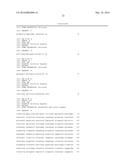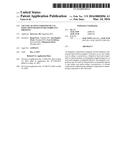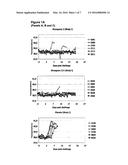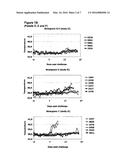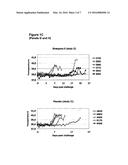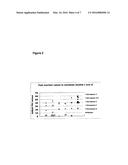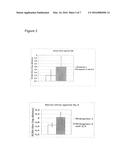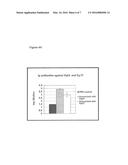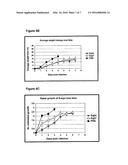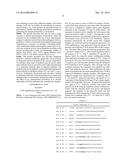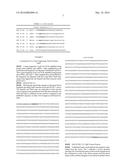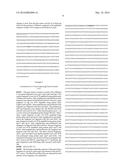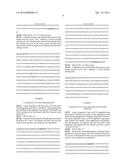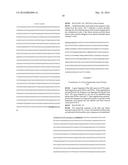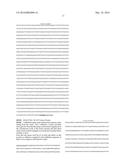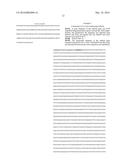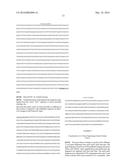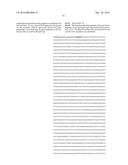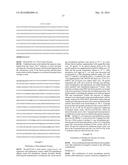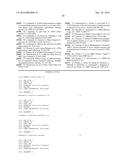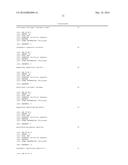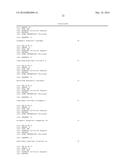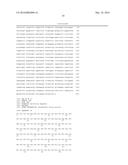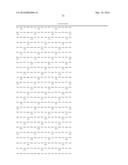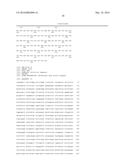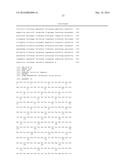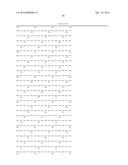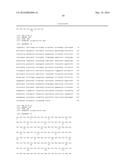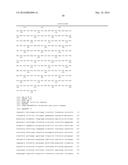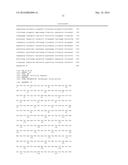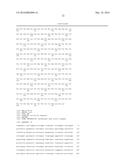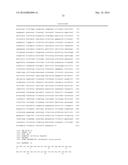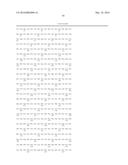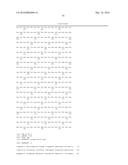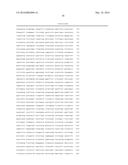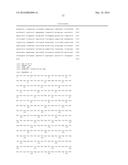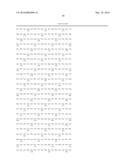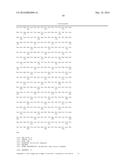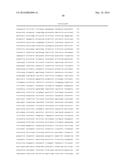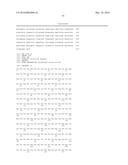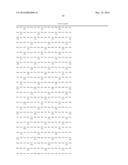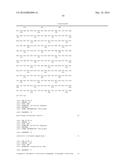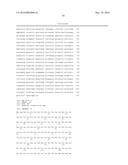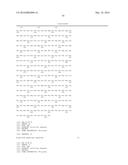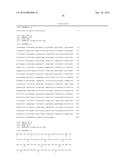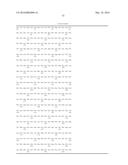Patent application title: VACCINE AGAINST STREPTOCOCCAL INFECTIONS BASED ON RECOMBINANT PROTEINS
Inventors:
Bengt Guss (Uppsala, SE)
Jan-Ingmar Flock (Bromma, SE)
Lars Frykberg (Storvreta, SE)
Margareta Flock (Bromma, SE)
IPC8 Class: AA61K3909FI
USPC Class:
4241391
Class name: Drug, bio-affecting and body treating compositions immunoglobulin, antiserum, antibody, or antibody fragment, except conjugate or complex of the same with nonimmunoglobulin material binds antigen or epitope whose amino acid sequence is disclosed in whole or in part (e.g., binds specifically-identified amino acid sequence, etc.)
Publication date: 2016-03-24
Patent application number: 20160082096
Abstract:
An antigenic composition comprises several antigenic components derived
from antigens of Streptococcus equi subsp. equi or subsp. zooepidemicus,
wherein at least one component is a fusion protein or polypeptide
compromising two or more such antigens or fragments thereof. The
antigenic composition may be used for immunization of mammals against S.
equi subsp. equi and/or subsp. zooepidemicus. A vaccine composition
comprising the antigenic composition as immunizing component is also
disclosed.Claims:
1. A method for the production of an antiserum, which method comprises
administering an antigenic composition to a non-human mammal host to
produce antibodies in said host and recovering antiserum containing said
antibodies produced in said host, wherein said antigenic composition
comprises a plurality of antigenic components derived from antigens of
Streptococcus equi subsp. equi or subsp. zooepidemicus, the antigenic
components comprising: (i) a first fusion polypeptide comprising at least
part of a protein designated EAG and at least a part of protein
designated CNE; and (ii) at least one additional polypeptide selected
from (a) a second fusion polypeptide comprising at least part of a
protein designated Eq5 and at least a part of a protein designated Eq8,
(b) a third fusion polypeptide comprising at least part of a protein
designated IdeE and at least a part of a protein designated Eq5, (c) at
least a part of a protein designated EndoSe or a protein designated
EndoSz, (d) at least part of a protein designated IdeE, (e) at least part
of a protein designated IdeE2, (f) at least part of a protein designated
Eq27, (g) at least part of a protein designated Eq54, (h) at least part
of a protein of a protein family designated Scl. wherein each said at
least part of said proteins comprises at least one antigenic epitope.
2. The method for the production of an antiserum according to claim 1, wherein said first fusion polypeptide further comprises at least a part of at least one protein of the protein family designated Scl.
3. The method for the production of an antiserum according to claim 1, wherein said first fusion polypeptide further comprises at least a part of a protein designated Eq54.
4. The method for the production of an antiserum according to claim 1, wherein said at least part of the protein designated EAG comprises an N-terminal part of the protein.
5. The method for the production of an antiserum according to claim 1, wherein said at least part of the protein designated CNE comprises an N-terminal part of the protein.
6. The method for the production of an antiserum according to claim 1, wherein said at least one additional polypeptide comprises the second fusion polypeptide in claim 1, and at least part of the protein designated IdeE.
7. The method for the production of an antiserum according to claim 1, wherein said antigenic composition further comprises at least part of the protein designated IdeE2.
8. The method for the production of an antiserum according to claim 1, wherein said at least one additional polypeptide comprises the third fusion polypeptide in claim 1.
9. The method for the production of an antiserum according to claim 1, wherein said antigenic composition further comprises at least part of the protein designated EndoSe or EndoSz.
10. The method for the production of an antiserum according to claim 1, wherein the first polypeptide comprises the amino acid sequence as shown in SEQ ID NO: 24, starting from amino acid 12.
11. The method for the production of an antiserum according to claim 1, wherein the first fusion polypeptide comprises the amino acid sequence as shown in SEQ ID NO: 28, starting from amino acid 12.
12. The method for the production of an antiserum according to claim 1, wherein the first fusion polypeptide comprises the amino acid sequence as shown in SEQ ID NO: 34, starting from amino acid 12.
13. The method for the production of an antiserum according to claim 1, wherein the second fusion polypeptide comprises the amino acid sequence as shown in SEQ ID NO: 22, starting from amino acid 12.
14. The method for the production of an antiserum according to claim 1, wherein the third fusion polypeptide comprises the amino acid sequence as shown in SEQ ID NO: 30, starting from amino acid 12.
15. The method for the production of an antiserum according to claim 1, wherein said antigenic composition comprises (i) a fusion polypeptide comprising the amino acid sequence as shown in SEQ ID NO: 22 starting from amino acid 12, (ii) a fusion polypeptide comprising the amino acid sequence as shown in SEQ ID NO: 24 starting from amino acid 12, and (iii) a polypeptide comprising the amino acid sequence as shown in SEQ ID NO: 26 starting from amino acid 12.
16. The method for the production of an antiserum according to claim 1, wherein said antigenic composition comprises (i) a fusion polypeptide comprising the amino acid sequence as shown in SEQ ID NO: 28 starting from amino acid 12, (ii) a fusion polypeptide comprising the amino acid sequence as shown in SEQ ID NO: 30 starting from amino acid 12, and (iii) a polypeptide comprising the amino acid sequence as shown in SEQ ID NO: 32 starting from amino acid 12.
17. The method for the production of an antiserum according to claim 1, wherein said antigenic composition comprises (i) a fusion polypeptide comprising the amino acid sequence as shown in SEQ ID NO: 34 starting from amino acid 12, (ii) a fusion polypeptide comprising the amino acid sequence as shown in SEQ ID NO: 30 starting from amino acid 12, and (iii) a polypeptide comprising the amino acid sequence as shown in SEQ ID NO: 32 starting from amino acid 12.
18. The method for the production of an antiserum according to claim 1, wherein said antigenic composition comprises (i) a fusion polypeptide comprising the amino acid sequence as shown in SEQ ID NO: 34 starting from amino acid 12, and (ii) a fusion polypeptide comprising the amino acid sequence as shown in SEQ ID NO: 30 starting from amino acid 12.
19. The method for the production of an antiserum according to claim 1, wherein said antigenic composition comprises at least one an antigenic fusion polypeptide comprising the amino acid sequence as shown in SEQ ID NO: 22, starting from amino acid 12; an antigenic fusion polypeptide comprising the amino acid sequence as shown in SEQ ID NO: 24, starting from amino acid 12; an antigenic fusion polypeptide comprising the amino acid sequence as shown in SEQ ID NO: 28, starting from amino acid 12; an antigenic fusion polypeptide comprising the amino acid sequence as shown in SEQ ID NO: 30, starting from amino acid 12; an antigenic fusion polypeptide comprising the amino acid sequence as shown in SEQ ID NO: 34, starting from amino acid 12; or an analogue thereof.
20. A method of prophylactic or therapeutic treatment of Streptococcus equi infection in a mammal, comprising administering to said mammal an immunologically effective amount of a vaccine composition, which comprises an antigenic composition comprising a plurality of antigenic components derived from antigens of Streptococcus equi subsp. equi or subsp. zooepidemicus, the antigenic components comprising: (i) a first fusion polypeptide comprising at least part of a protein designated EAG and at least a part of protein designated CNE; and (ii) at least one additional polypeptide selected from (a) a second fusion polypeptide comprising at least part of a protein designated Eq5 and at least a part of a protein designated Eq8, (b) a third fusion polypeptide comprising at least part of a protein designated IdeE and at least a part of a protein designated Eq5, (c) at least a part of a protein designated EndoSe or a protein designated EndoSz, (d) at least part of a protein designated IdeE, (e) at least part of a protein designated IdeE2, (f) at least part of a protein designated Eq27, (g) at least part of a protein designated Eq54, (h) at least part of a protein of a protein family designated Scl. wherein each said at least part of said proteins comprises at least one antigenic epitope; and a pharmaceutically acceptable carrier.
21. The method of prophylactic or therapeutic treatment according to claim 20, wherein said first fusion polypeptide further comprises at least a part of at least one protein of the protein family designated Scl.
22. The method of prophylactic or therapeutic treatment according to claim 20, wherein said first fusion polypeptide further comprises at least a part of a protein designated Eq54.
23. The method of prophylactic or therapeutic treatment according to claim 20, wherein said at least part of the protein designated EAG comprises an N-terminal part of the protein.
24. The method of prophylactic or therapeutic treatment according to claim 20, wherein said at least part of the protein designated CNE comprises an N-terminal part of the protein.
25. The method of prophylactic or therapeutic treatment according to claim 20, wherein said at least one additional polypeptide comprises the second fusion polypeptide in claim 1, and at least part of the protein designated IdeE.
26. The method of prophylactic or therapeutic treatment according to claim 20, wherein said antigenic composition further comprises at least part of the protein designated IdeE2.
27. The method of prophylactic or therapeutic treatment according to claim 20, wherein said at least one additional polypeptide comprises the third fusion polypeptide in claim 1.
28. The method of prophylactic or therapeutic treatment according to claim 20, wherein said antigenic composition further comprises at least part of the protein designated EndoSe or EndoSz.
29. The method of prophylactic or therapeutic treatment according to claim 20, wherein the first fusion polypeptide comprises the amino acid sequence as shown in SEQ ID NO: 24, starting from amino acid 12.
30. The method of prophylactic or therapeutic treatment according to claim 20, wherein the first fusion polypeptide comprises the amino acid sequence as shown in SEQ ID NO: 28, starting from amino acid 12.
31. The method of prophylactic or therapeutic treatment according to claim 20, wherein the first fusion polypeptide comprises the amino acid sequence as shown in SEQ ID NO: 34, starting from amino acid 12.
32. The method of prophylactic or therapeutic treatment according to claim 20, wherein the second fusion polypeptide comprises the amino acid sequence as shown in SEQ ID NO: 22, starting from amino acid 12.
33. The method of prophylactic or therapeutic treatment according to claim 20, wherein the third fusion polypeptide comprises the amino acid sequence as shown in SEQ ID NO: 30, starting from amino acid 12.
34. The method of prophylactic or therapeutic treatment according to claim 20, wherein said antigenic composition comprises (i) a fusion polypeptide comprising the amino acid sequence as shown in SEQ ID NO: 22 starting from amino acid 12, (ii) a fusion polypeptide comprising the amino acid sequence as shown in SEQ ID NO: 24 starting from amino acid 12, and (iii) a polypeptide comprising the amino acid sequence as shown in SEQ ID NO: 26 starting from amino acid 12.
35. The method of prophylactic or therapeutic treatment according to claim 20, wherein said antigenic composition comprises (i) a fusion polypeptide comprising the amino acid sequence as shown in SEQ ID NO: 28 starting from amino acid 12, (ii) a fusion polypeptide comprising the amino acid sequence as shown in SEQ ID NO: 30 starting from amino acid 12, and (iii) a polypeptide comprising the amino acid sequence as shown in SEQ ID NO: 32 starting from amino acid 12.
36. The method of prophylactic or therapeutic treatment according to claim 20, wherein said antigenic composition comprises (i) a fusion polypeptide comprising the amino acid sequence as shown in SEQ ID NO: 34 starting from amino acid 12, (ii) a fusion polypeptide comprising the amino acid sequence as shown in SEQ ID NO: 30 starting from amino acid 12, and (iii) a polypeptide comprising the amino acid sequence as shown in SEQ ID NO: 32 starting from amino acid 12.
37. The method of prophylactic or therapeutic treatment according to claim 20, wherein said antigenic composition comprises (i) a fusion polypeptide comprising the amino acid sequence as shown in SEQ ID NO: 34 starting from amino acid 12, and (ii) a fusion polypeptide comprising the amino acid sequence as shown in SEQ ID NO: 30 starting from amino acid 12.
38. The method of prophylactic or therapeutic treatment according to claim 20, wherein said antigenic composition comprises at least one an antigenic fusion polypeptide comprising the amino acid sequence as shown in SEQ ID NO: 22, starting from amino acid 12; an antigenic fusion polypeptide comprising the amino acid sequence as shown in SEQ ID NO: 24, starting from amino acid 12; an antigenic fusion polypeptide comprising the amino acid sequence as shown in SEQ ID NO: 28, starting from amino acid 12; an antigenic fusion polypeptide comprising the amino acid sequence as shown in SEQ ID NO: 30, starting from amino acid 12; an antigenic fusion polypeptide comprising the amino acid sequence as shown in SEQ ID NO: 34, starting from amino acid 12; or an analogue thereof.
39. A method of protecting horses against Streptococcus equi infection, which comprises inoculating a horse subcutaneously, intradermally, intramuscularly or intranasally with a vaccine composition of claim 20 to induce an immune response against Streptococcus equi in said horse.
40. The method of claim 39, wherein an immune response in the form of IgG and/or IgA and/or IgM antibodies in serum and/or the nasopharyngeal mucus is induced in said horse.
41. The method of claim 20, wherein said mammal is a horse.
Description:
FIELD OF THE INVENTION
[0001] This invention relates to subunit immunogenic or vaccine compositions and use thereof for immunization of mammals susceptible to streptococcal infections. The invention also relates to methods for preparing, formulating and administrating such compositions.
BACKGROUND OF THE INVENTION
[0002] Streptococcal infections in horses are mainly caused by the species Streptococcus equi, which comprises three subspecies designated equi, zooepidemicus, and ruminatorium respectively hereafter simply called S. equi, S. zooepidemicus and S. ruminatorium (Refs. 15, 24, 40).
[0003] S. equi which is virtually confined to horses is the causative agent of strangles, a world-wide distributed and highly contagious serious disease of the upper respiratory tract of the Equidae. Strangles is one of the most frequently reported equine diseases world-wide and is characterized by fever, nasal discharge, and abscess formation in the retropharyngeal and mandibular lymph nodes. In some cases the disease shows a metastatic course in the body, so called "bastard strangles". The disease has a world-wide distribution and causes great economic losses (Ref. 39).
[0004] S. zooepidemicus is considered as an opportunistic commensal often occurring in the upper respiratory tract of healthy horses. However, after stress or virus infection, it can cause a secondary infection, which results in strangles-like symptoms. Moreover, S. zooepidenzicus infects not only horses but also a wide range of other animals, like pigs, goats, dogs, cats, and cows. Even human cases of infection due to subsp. zooepidemicus have been reported (Ref. 5). This subspecies has been implicated as the primary pathogen in conditions such as endometritis, cervicitis, abortion, mastitis, pneumonia, abscesses and joint infections.
[0005] S. ruminatorium has been isolated from milk of sheep and goats with mastitis (Ref. 10).
[0006] Streptococcus pyogenes is an important human pathogen which causes a variety of diseases e.g. impetigo, pharyngitis, necrotizing fasciitis and toxic shock syndrome.
[0007] Although it is possible to treat and cure these streptococcal infections with antibiotics, such as penicillin, tetracycline or gentamicin, an effective prophylactic agent that could prevent outbursts of such infections and obviate or reduce the risk for development of resistant strains associated with antibiotic treatment, would be appreciated.
DESCRIPTION OF THE RELATED ART
[0008] However, although many attempts have been made to develop prophylactic agents such as vaccines against S. equi, at the present time no efficient and safe vaccines are available on the market, neither for the subsp. equi nor for the subsp. zooepidemicus, subsp. ruminatorium or S. pyogenes.
[0009] Existing vaccines against strangles are based on inactivated, e. g. heat-killed, or attenuated strains of S. equi or acid extracts/mutanolysin enriched in M-protein(s), i.e. immunogenic protein(s) produced by S. equi. A vaccine against S. zooepidemicus based on an M-like protein is disclosed in U.S. Pat. No. 5,583,014. In WO 87/00436, Ref. 17 and WO 2009/093014 A2 attenuated strains of S. equi are disclosed for use as a vaccine against infections caused by S. equi.
[0010] A commercial vaccine against strangles, Equilis StrepE from Intervet, UK, was released in 2004. However, the safety and efficacy of this vaccine, which is based on an attenuated (living, deletion mutated) strain of S. equi can be questioned (Refs. 23, 35).
[0011] Since the previously developed vaccines or immunizing preparations based on living or inactivated bacteria are hampered by side-effects and may provide insufficient protection there is a need for efficient and safe prophylactic agents, such as vaccines, that protect against S. equi infections and/or prevent spread thereof without giving rise to undesirable side-effects.
[0012] For years, streptococcal surface proteins, that interact with and/or bind to different components of the Extracellular Matrix (ECM) or plasma proteins of the host cell have been identified and characterized. Examples of extracellular surface proteins of S. equi and S. zooepidemicus that have been characterized are FNZ (Ref. 29), EAG (Ref. 27), the collagen-like proteins (SclC, SclD, SclE, SclF, SclG, SclH and SclI) (Refs. 21, 22), CNE (also called Sec) (Ref. 25), ZAG (Ref. 18 and WO 95/07296). Furthermore, examples of S. equi extracellular proteins that are supposed to be released into the surrounding medium are SFS (Ref. 28), IdeE and IdeZ (Ref. 26), IdeE2 and IdeZ2 (Ref. 16). These types of proteins are potential candidates for use as active component(s) for immunizing purposes.
[0013] The uses of this type of proteins as components in a potential vaccine for protection of horses against strangles are disclosed in WO 2004/032957 A1, WO 00/37496, WO 2007/115059 A2, WO 98/01561 and WO 2009/075646 A1.
[0014] In Flock, M., et al (2004) (Ref. 11), it is reported that in a mouse model of equine strangles, parts of the proteins designated FNZ, SFS and EAG, respectively, were used to immunize mice. FNZ and EAG were considered as promising candidates for development of a safe and efficacious vaccine against strangles.
[0015] Timoney et al (2007) (Ref. 42) reported that recombinant DNA produced extracellular proteins of subsp. equi are useless as vaccine components. It was speculated therein that earlier reported results for some S. equi proteins produced by recombinant DNA technology, showing protection in mice experiments, are not applicable to horses. Thus, it is not obvious that recombinant forms of extracellular localized S. equi proteins necessarily are functional as vaccine components.
[0016] In Ref. 45, vaccination of horses against strangles using the recombinant antigens EAG, CNE and SclC from S. equi is reported. In this study, vaccinated horses showed, after challenge with S. equi, significantly reduced recovery of bacteria and significantly lower levels of nasal discharge.
[0017] Although many efforts have been made to develop efficient vaccines and some of the immunizing components presented in Refs. 14 and 15, WO 2004/032957 A1, WO2009/075646 A1, are promising candidates for use in a vaccine that protects against S. equi infection, development of safe vaccines having a high degree of immunogenicity and exhibiting limited or no side effects is still desirable.
[0018] The human pathogen Streptococcus pyogenes also expresses a great number of extracellular proteins interacting with ECM and/or blood components of the host (Refs. 6, 7, 9, 33). Among these are an endoglycosidase, called EndoS that has the ability to hydrolyse the chitobiose core of the asparagine-linked glycan on human immunoglobulin G (IgG) (Ref. 8). EndoS has been further characterized in a series of articles, describing e.g. enzymatic properties, specificity etc (Refs. 1, 2, 3, 4, 34). The use of EndoS in treating or preventing diseases mediated by IgG antibodies such as autoimmune diseases is disclosed in WO/2008/071418 A2 and the in vitro use of EndoS to isolate and analyse IgG in WO 2009/033670 A2. The use of EndoSe of Streptococcus equi subsp. equi and EndoSz of Streptococcus equi subsp. zooepidemicus, or fragments thereof, as a component in a vaccine against bacterial infections or to elicit an immunogenic response or a protective immune response is disclosed in WO 2011/059385 A1 (the entire disclosure of which is incorporated by reference herein).
BRIEF SUMMARY OF THE INVENTION
[0019] The present invention is based on an antigenic, suitably an immunogenic, composition comprising multiple antigens, suitably immunogens that comprise at least one antigenic epitope or antigenic determinant derived from a protein present in one or both of S. equi and S. zooepidemicus and use thereof for immunization of non-human mammals against S. equi and/or S. zooepidemicus. According to the invention, at least one component of the composition is a fusion protein or polypeptide comprising two or more antigens or fragments thereof.
[0020] The present invention is also directed to a subunit immunogen or vaccine composition comprising the aforesaid antigenic composition as immunizing component; to methods to prepare said antigenic, suitably immunogenic, composition or vaccine composition; to methods to induce an immune response against S. equi and/or S. zooepidemicus in non-human mammals; and to methods for prophylactic or therapeutic treatment of S. equi and/or S. zooepidemicus infection in non-human mammals.
[0021] The invention is also directed to specific antigenic fusion polypeptides per se.
[0022] According to a suitable embodiment, the present invention is directed to a vaccine that protects equines, such as horses, against diseases caused by S. equi, e.g. strangles, upper respiratory tract infections, wound infections and endometritis. The word "protects" is a general term including anything between full protection and reduction of the severity of infection. The degree of protection can be measured in various ways, concerning e.g. S. equi infections in horses the effect of the vaccine can be reduced clinical symptoms and reduced clinical disease, where reduced increase in temperature, reduced swelling of lympnodes and reduced dissemination of bacteria from infected animals etc can be observed. Methods and procedures how to measure the efficacy of an immunizing composition after challenge can be obtained from e.g. Ref. 14, and WO 2009/075646 A1.
[0023] For various reasons, before performing vaccination and challenge experiments in horses, the evaluation of novel antigens to be used in a vaccine are studied in a small animal model. Concerning upper respiratory tract infections caused by subsp. equi a suitable and well established vaccination and experimental infection model has been described (Refs. 11, 12, 13, 14, 16, 43, WO 2004/032957 A1, WO 2009/075646 A1). This model has been used with a high degree of reliability to screen and evaluate S. equi antigens with a potential to provoke a protective immunogenic response in horses (Refs. 13, 14).
[0024] In the context of infections caused by S. equi, the expression "non-human mammals" primarily refers to animals belonging to the family Equidae that consists of horses, donkeys and zebras and to hybrids thereof, such as mules and hinnies. Camels and dromedaries are also encompassed therein.
[0025] In connection with infections caused by S. zooepidemicus, the expression "non-human mammals" in addition refers also to other mammals such as cows, pigs, dogs and cats.
[0026] The above-mentioned aspects of the invention, and preferred embodiments thereof, are defined in the appended claims.
[0027] In particular embodiments, the present invention makes use of one or more polypeptides selected from the amino acid sequences SEQ ID NOS: 22, 24, 26, 28, 30, 32, 34, 38, 42 and one or more nucleotide sequences selected from the nucleotide sequences SEQ ID NOS: 21, 23, 25, 27, 29, 31, 33, 37, 41.
[0028] The practice of the present invention will employ, unless otherwise indicated, conventional techniques of microbiology, recombinant DNA technology and molecular biology and immunology, which are within the skills of the art. Such techniques are explained in literature e.g. Sambrook et al (2001) Molecular Cloning: A laboratory manual, 3rd ed. Cold Spring Harbour Press. Unless defined otherwise, all scientific and technical terms used herein have the same meaning as commonly understood by a person with ordinary skill in the art to which the invention pertains.
[0029] A "fragment" of a molecule such as a protein or nucleic acid is meant to refer to a portion of the amino acid or nucleotide sequence.
[0030] The term "analog" refers to a nucleic acid or amino acid sequence variant having a sequence homology ("identity") of 80% or more, especially 90% or more, with the reference sequence. In general, "identity" refers to an exact nucleotide to nucleotide or amino acid to amino acid correspondence of two polynucleotides or polypeptide sequences, respectively. Techniques for determining nucleic acid sequence identity are well known in the art, and software programs for calculating identity between sequences are available.
[0031] Many of the S. equi proteins have different designations in various reports. To facilitate the reading of this application to previous reports/patent applications references and alternative designation is shown in Table 1 below.
TABLE-US-00001 TABLE 1 Present application References Alternative designation CNE WO 2004/032957 A1, SEC WO 2009/075646 A1 Ref. 25 EAG WO 2004/032957 A1, WO 2009/075646 A1 Ref. 11 Eq8 WO 2009/075646 A1 SEQ0402 Ref. 14 Eq5 WO 2009/075646 A1 SEQ0256 Ref. 14 A21 Ref. 22 SclF A36 Ref. 22 SelI A42 WO 2004/032957 A1, SclC WO 2009/075646 A1 Ref. 22 IdeE WO 2009/075646 A1 Refs. 16, 26 EndoSe WO 2011/059385 A1 Eq54 Ref. 14 SEQ0939 Eq27 Ref. 14 SEQ0944
BRIEF DESCRIPTION OF THE DRAWINGS
[0032] FIG. 1A is diagrams showing rectal temperature versus days post challenge in ponies vaccinated in Study I with Strangvacc 2, Strangvacc 3/4 or placebo for Panels A, B and C.
[0033] FIG. 1B is diagrams showing rectal temperature versus days post challenge in ponies vaccinated in Study II with Strangvacc 3/4, 5 or 7 for Panels D, E and F.
[0034] FIG. 1C is diagrams showing rectal temperature versus days post challenge in ponies vaccinated in Study II with Strangvacc 8 or placebo for Panels G and H.
[0035] FIG. 2 is a diagram showing accumulated post mortem values for individual ponies vaccinated in Studies I and II.
[0036] FIG. 3 is diagrams showing antibody levels in ponies vaccinated with Strangvacc I (containing single antigens) or Strangvacc 2 and 3/4 (data combined together)(containing fusion proteins). Top diagram (panel) shows antibodies against CNE, and bottom diagram (panel) shows antibodies against Eq5 (SEQ0256).
[0037] FIG. 4A is a diagram showing antibody titer against Eq54 (n=10) and Eq27. IgG titers in sera from mice immunized with Eq54 or Eq27, or left non-vaccinated are shown. Mean values and standard errors of log values of dilutions required to get an absorbance of 1.5 in ELISA are shown. Values from non-vaccinated mice are included.
[0038] FIG. 4B is a diagram showing weight loss of infected mice. The average weight loss over time of mice infected with S. equi subsp. equi is shown. Mice (n=3×10) had previously been vaccinated with antigens as indicated. Mean values and standard errors are shown.
[0039] FIG. 4C is a diagram showing nasal colonisation of infected mice. The nasal growth of S. equi subsp. equi over time of mice infected with S. equi subsp. equi is shown. Mice (n=3×10) had previously been vaccinated with antigens as indicated. Mean values and standard errors are shown.
DETAILED DESCRIPTION OF THE INVENTION
[0040] As mentioned above, the present invention is generally concerned with identification of polypeptides or proteins of S. equi or S. zooepidemicus that are able to elicit an immunogenic response, when administered to a mammal; and to the identification of polynucleotides or genes encoding these polypeptides or proteins.
[0041] The present invention is also concerned with fragments or analogs of said polypeptides or proteins or of said polynucleotides or genes.
[0042] More specifically, the invention discloses how gene fragments of S. equi or S. zooepidemicus encoding various extracellular proteins can be combined by gene fusion technology, expressed in a suitable host and used as antigens in a vaccine against streptococcal infections in mammals. While based on such studies, the present invention is not limited to the specific combinations disclosed. Basically, the individual antigens represented in each fusion protein can be arranged in various number, order or combinations. In principal, an order of the antigens can e.g. be N-terminus-A-B-C-D-E-C-terminus, but the position of each individual antigen can be changed and the number thereof varied. Further, the invention also discloses how fusion proteins can be combined in a vaccine with non-fusion proteins to obtain efficient vaccine compositions.
[0043] In the following, reference will be made to various patent and literature references, the relevant disclosures of which are incorporated by reference herein.
[0044] According to one embodiment, the present invention is directed to an antigenic composition comprising several antigens, wherein each antigen comprises at least part of a protein or polypeptide of S. equi or S. zooepidemicus, and said at least part of said protein or polypeptide comprises at least one antigenic epitope or antigenic determinant of S. equi or S. zooepidemicus, and wherein said at least part of a protein or polypeptide is selected from the group comprising:
[0045] a protein or polypeptide which is designated Eq85 and has an amino acid sequence as shown in SEQ ID NO: 22;
[0046] a protein or polypeptide which is designated CCE and has an amino acid sequence as shown in SEQ ID NO: 24;
[0047] a protein or polypeptide which is designated IdcE and has an amino acid sequence as shown in SEQ ID NO: 26;
[0048] a protein or polypeptide which is designated CNEEAG and has an amino acid sequence as shown in SEQ ID NO: 28;
[0049] a protein or polypeptide which is designated IE5 and has an amino acid sequence as shown in SEQ ID NO: 30;
[0050] a protein or polypeptide which is designated EndoSe and has an amino acid sequence as shown in SEQ ID NO: 32;
[0051] a protein or polypeptide which is designated CPCE and has an amino acid sequence as shown in SEQ ID NO: 34;
[0052] a protein or polypeptide which is designated Eq54 and has an amino acid sequence as shown in SEQ ID NO: 38;
[0053] a protein or polypeptide which is designated Eq27 and has an amino acid sequence as shown in SEQ ID NO: 42;
and fragments and analogs thereof; wherein at least one antigen is a fusion protein or polypeptide.
[0054] The above-mentioned antigen or antigens may further be combined with at least a part of a protein or polypeptide selected from the group comprising:
[0055] a protein or polypeptide which is designated CNE and has an amino acid sequence as shown in WO 2004/032957 A1, SEQ ID NO: 4;
[0056] a protein or polypeptide which is designated FNZ and has an amino acid sequence as shown in WO 2004/032957 A1, SEQ ID NO: 2;
[0057] a protein or polypeptide which is designated SFS and has an amino acid sequence as shown in WO 2004/032957 A1, SEQ ID NO: 3;
[0058] a protein or polypeptide which is designated SclC and has an amino acid sequence as shown in WO 2004/032957 A1, SEQ ID NO: 23;
[0059] a protein or polypeptide which is designated EAG and has an amino acid sequence as shown in WO 2004/032957 A1, SEQ ID NO: 1, and WO 2009/075646 A1, SEQ ID NO: 13;
[0060] a protein or polypeptide which is designated IdeE and has an amino acid sequence as shown in WO 2009/075646 A1, SEQ ID NO: 10;
[0061] a protein or polypeptide which is designated IdeE2 and has an amino acid sequence as shown in WO 2009/075646 A1, SEQ ID NO: 1;
[0062] a protein or polypeptide which is designated Eq5 and has an amino acid sequence as shown in WO 2009/075646 A1, SEQ ID NO: 3;
[0063] a protein or polypeptide which is designated Eq8 and has an amino acid sequence as shown in WO 2009/075646 A1, SEQ ID NO: 5;
[0064] a protein or polypeptide which is designated IdeZ2 and has an amino acid sequence as shown in WO 2009/075646 A1, SEQ ID NO: 7;
[0065] a protein or polypeptide which is designated Eqz5 and has an amino acid sequence as shown in WO 2009/075646 A1, SEQ ID NO: 8; and
[0066] a protein or polypeptide which is designated Eqz8 and has an amino acid sequence as shown in WO 2009/075646 A1, SEQ ID NO: 9;
or an analog or a fragment thereof.
[0067] For convenience, the polypeptides having amino acid sequences as shown in the sequence listing of WO 2009/075646 A1 and WO 2004/032957 A1 mentioned above are frequently only designated CNE, FNZ, SclC, SFS, EAG, IdeE, IdeE2, Eq5, Eq8, IdeZ2, Eqz5, and Eqz8, respectively. EAG, IdeE, IdeE2, Eq5, and Eq8 designate proteins that can be found in S. equi and IdeZ2, Eqz5, and Eqz8 designate proteins that can be found in S. zooepidemicus. Other examples are the M or M-like proteins e.g. SeM described in Ref. 42.
[0068] Further examples of antigens that may be included in the antigenic composition of the invention comprise the ScIC proteins SCID-SclI (genbank acc. nos. DQ158080, DQ158081, DQ158082, DQ158083, DQ158084, DQ158085), FNE (acc. no. AF360373), FNEB (acc. no AY898649), FNEC-FNEF (Ref. 24), SeM (acc. no. U73162 also called FBP acc. no. YP002747233), SzPSe (acc. no. U73162), seeH (acc. no. AF186180), seeM (acc. no. AJ583528), seeI (GenBank, Gene ID7697191, SEQ_2037, Ref. 15), seeL (acc. no. AJ1583527), Se51.9 (acc. no. AF521601), Se46.8 (acc. no. AF521600), Se24.3 (acc. no. AY137521), Se75.3 (ace, no. AY137528), Se110.0 (acc. no. AY137519), Se24.3 (AY137521), Se42.0 (acc. no AY137521), Se117.0 (acc. no. AY137523), Se18.9 (acc. no. DQ068464), ZAG (acc. no. U25852), slaA (acc. no. CAW93317), slaB (acc. no. CAW95519), sagA (acc. no. ACG61862), streptolysin S biosynthesis proteins (CW92800, CW92802, CW92798), streptolysin S precursor (CW92796), SpyCEP (acc. no. DQ413032), the SpyCEP similar proteins SeCEP and SzoCEP (Ref. 43).
[0069] However, the proteins or polypeptide fragments that may be included in the antigenic compositions of the invention are not restricted to those listed above. In general, the invention can be used in principle with any extracellular protein or fragments thereof expressed on the surface or proteins transported into the environment of pathogenic streptococci, e.g. different subsp. of S. equi or S. pyogenes. By DNA sequence analysis of the genome of these bacteria e.g. http://www.sanger.acnk/Projects/S_equi/; http://www.sanger.ac.uk/Progects/S_zooepidemicus/; http://www.sanger.ac.uk/Projects/S_pyogenes/, open reading frames can be identified coding for extracellular proteins. These proteins are usually characterized by harboring an N-terminal signal sequence responsible for the transport across the membrane after translation. A particular interesting group of protein for vaccine development is proteins which in addition to harboring the signal sequence also display an easily recognized C-terminal domain including an amino acid motif generally defined as e.g. LPXTG, important for anchoring an extracellular protein to the peptidoglycan structure of the bacterial cell wall (Ref. 37). How to identify such proteins by bioinformatics methods, e.g. computer program SignalP (http://www.cbs.dtu.dk/services/SignalP/), (Refs. 19, 38), is well known to people skilled in the art.
[0070] The antigens or immunogens of the present antigenic or immunogenic compositions may comprise the entire amino acid sequence of said protein or polypeptide or may comprise a fragment, e.g. a C-terminal or N-terminal fragment thereof, or an analog thereof. These antigens may be used alone or in combinations. According to the invention, they may also by gene fusion technology be fused in various combinations and used as antigens in a vaccine. Furthermore, these fusion combinations may be used alone or in combination with other fusion combinations and/or in combination with single antigens.
[0071] According to the present invention, the antigenic compositions may comprise at least one antigen which is produced by recombinant technology and/or at least one antigen which is an isolated or purified antigen, or fragment thereof, such as the native forms produced by the streptococcal bacteria (or overproducing mutants). The native forms may be isolated from cells or growth media from bacteria grown in suitable media resulting in high production of the respective protein. In addition, after finding the optimal growth conditions (including physiological conditions) to obtain the native proteins it is also possible to construct overproducing streptococcal strains. Using methods well known for people skilled in the art there are several ways to generate and isolate overproducing strains, e.g. by site directed mutagenesis, chemical mutagenesis, ultraviolet light etc. The procedure of purifying and isolating an extracellular protein from growth media is well known for people skilled in the art.
[0072] From the above, it is evident that the present antigens or immunogens that are derived from proteins of S. equi, or S. zooepidemicus may comprise the entire protein, a fragment of said protein or an analog of said protein (like for instance synthetic peptides) which is immunogenic. Thus, the present invention is not limited to the fragments of proteins that are specifically disclosed herein.
[0073] The antigenic composition of the present invention may comprise at least one recombinant vector and at least one polynucleotide inserted therein that encodes said at least one protein or polypeptide, and which vector is able to express said polypeptide in vivo in a non-human mammal susceptible to infection with S. equi and/or S. zooepidemicus.
[0074] According to one embodiment of the present invention, the vector is an expression vector which is a plasmid or a viral vector and wherein said polynucleotide has a nucleotide sequence that encodes an antigen of the present invention.
[0075] The application of the present invention is not restricted to the usage of E. coli and vectors suitable for this bacterium as vehicles and tools to express recombinant polypeptides. Other hosts and vectors are well known in the art and can be found in literature and in literature cited in WO 2007/115059 A2. Furthermore, the application of the present application is not restricted to the specific nucleotide sequences of the antigens disclosed in the invention since it may be necessary to adapt the codon usage of the specific nucleotide sequences to the production host to be used. The technique to synthesize and adapt the codon usage is well known for people skilled in the art.
[0076] A further embodiment of the present invention is concerned with a vaccine composition for protecting non-human mammals against infection of S. equi, which comprises an antigenic composition as disclosed above as immunizing component, and a pharmaceutically acceptable carrier.
[0077] Suitably, the present vaccine composition comprises an antigenic or immunogenic composition that contains one or more of the present antigens or immunogens as immunizing component(s). Optionally, one or more of these antigens or immunogens are comprised of analogs of said proteins or fragments thereof.
[0078] The vaccine composition may comprise further components, such as an adjuvant. Suitably, said adjuvant stimulates systemic or mucosal immunity. Such adjuvants are well known in the art.
[0079] Suitable adjuvants for use according to the present invention comprise (1) polymers of acrylic or methacrylic acid, maleic anhydride and alkenyl derivative polymers, (2) immunostimulating sequences (ISS), (3) an oil in water emulsion, (4) cation lipids containing a quaternary ammonium salt, (5) cytokines, (6) aluminum hydroxide or aluminum phosphate, (7) saponin or (8) nanoparticles or (9) any combinations or mixtures thereof. Further examples of suitable adjuvants may also be found in literature cited in WO 2007/115059 A2.
[0080] A suitable adjuvant for use according to the present invention is the adjuvants Abisco, Matrix C and Matrix Q from Isconova AB, Sweden. The key components of ISCOMS are Quillaia saponins derived from the bark of the Chilean soap bark tree Quillaia saporinaria molina. Quillaia saponins are well known for their ability to activate the immune system (Ref. 32). Quillaia saponins mixed with cholesterol, and phospholipids under specific stochiomectry form spherical open cage like structures known as ISCOMS.
[0081] Another suitable adjuvant is Ginseng. Ginseng is a dry extract prepared from the root of the plant Panax ginseng, C. A. Meyer. Ginseng contains a number of active substances named ginsenosides that are a kind of saponins, chemically tri-terpenoid glycosides of the danunaran series. The ginsenosides have adjuvant properties and one of the most active adjuvants is the fraction named Rbl. It has been proved that the fraction Rbl elicits a balanced Th1 and Th2 immune response as determined by measuring the levels of the cytokines IFN-γ, IL-2, IL-4, IL-10 secreted post vaccination with a Rbl adjuvanted vaccine. In addition ginseng and the fraction Rbl stimulate a strong antigen specific antibody response.
[0082] According to a suitable embodiment, the vaccine composition is a vaccine that protects susceptible mammals, suitably horses, against strangles caused by S. equi and against infections caused by S. zooepidemicus.
[0083] The vaccine composition of the present invention is provided in a physiologically administrable form. Suitably, it is administrable by intramuscular, subcutaneous, intradermal or intranasal inoculation.
[0084] Suitably, the vaccine composition of the present invention stimulates serum, mucosal and/or bronchial antibody responses directed to S. equi and/or S. zooepidemicus antigens in mammals susceptible to these bacteria, suitably horses.
[0085] The present invention is also related to a method for producing an antigen or immunogen to be used in an antigenic or immunogenic composition of the present invention, which method comprises the steps of
[0086] (a) providing a DNA fragment encoding said antigen and introducing said fragment into an expression vector;
[0087] (b) introducing said vector, which contains said DNA fragment, into a compatible host cell;
[0088] (c) culturing said host cell provided in step (b) under conditions required for expression of the product encoded by said DNA fragment; and
[0089] (d) isolating the expressed product from the cultured host cell.
[0090] Preferably, the method further comprises a step (e) wherein the isolated product from step (d) is purified, e.g. by affinity chromatography or other chromatographic methods known in the art.
[0091] Accordingly, the antigens of the present invention are usually produced according to recombinant techniques.
[0092] A further embodiment of the present invention is concerned with a method for preparation of a vaccine of the present invention, which vaccine contains as immunizing component an antigenic or immunogenic composition as disclosed above, said method comprising mixing said antigenic composition and a pharmaceutically acceptable carrier.
[0093] The present invention is also related to a method for the production of an antiserum, said method comprising administering an antigenic preparation of the present invention to an animal host to produce antibodies in said animal host and recovering antiserum containing said antibodies produced in said animal host.
[0094] Moreover, the present invention is concerned with a method of prophylactic or therapeutic treatment of S. equi and/or S. zooepidemicus infection in mammals, suitably horses, comprising administering to said mammal an immunologically effective amount of a vaccine or an antiserum of the present invention.
[0095] Accordingly, the present invention is related to a method for protecting horses against S. equi infection, which method comprises inoculating a horse subcutaneously, intranasally, intradermally, orally or intramuscularly, or any combination thereof with a vaccine composition of the present invention to induce an immune response against S. equi in said horse. Suitably, an immune response, in the form of IgG and/or IgA and/or IgM antibodies in the nasopharyngeal mucus, and/or serum is induced in said horse.
[0096] The present invention also relates to an antibody preparation comprising at least one, and suitably at least two, antibodies specific for a protein or a polypeptide of the present antigenic composition, which antibody/antibodies is/are polyclonal or monoclonal; or which preparation comprises a fragment of said antibodies.
[0097] The antibody preparation of the present invention could be used prophylactically or therapeutically against strangles and provides passive immunization when administered to a non-human mammal susceptible to infection by S. equi or infected by S. equi.
[0098] The present invention provides a vaccine composition comprising one or several antigen components which have been prepared according to the present method using E. coli as host cells. The source of these antigens might also be the native bacteria, if methods are developed for expression and purification thereof. Alternatively, the antigens of the present invention can also be produced according to methods that are based on fusion strategies where various parts of the respective antigen are recombined resulting in a fusion protein consisting of parts from different antigens. This fusion strategy could also be suitable for introducing an immune reactive part(s), e.g. T-cell epitopes or attenuated toxins (or parts thereof), thereby introducing other features suitable for optimizing the antigen presentation or localization.
[0099] The present invention may also be used in other vaccines or subunit immunogenic compositions, where the invention can be combined with one or more immunogens, antigens or epitopes selected from other pathogenic microorganisms or viruses to form multivalent subunit immunogenic compositions or vaccines. For example, concerning equine, such a multivalent subunit immunogenic composition or vaccine may comprise at least one polypeptide according to the present invention and at least one immunogen, antigen, or epitope from WEEV, EEV, VEEV, equine influenza virus, EHV-1, EHV-4, EAV, WNV, tetanus, Rhodococcus.
[0100] The present invention also provides diagnostic methods to measure antibodies against the various proteins (or fragments thereof) included in the vaccine composition. For instance, these types of methods may be used to determine antibody titers in sera before and/or after immunization or to determine antibody titers in infected mammals. The methods may also be applied to screen individual mammals to detect infected or chronical carriers of S. equi and S. zooepidemicus. Furthermore, the invention also provides a method to determine antibodies with neutralizing activity against the antigens in the vaccine thereby making it possible to measure the effect of e.g. immunization procedures or to identify individuals who lack antibodies that neutralize the antigens.
EXPERIMENTAL PART
Example 1
PCR Amplifications and Constructions of E. coli Clones
[0101] S. equi subspecies equi strain 1866 (obtained from Nordvacc Lakemedel AB, Sweden), (WO 2004/032957 A1, Ref. 25) was used as source of DNA for cloning. Chromosomal DNA from subspecies equi strain 1866 was prepared and used as a template to amplify various gene fragments presented in the Examples 2-8 and 16 further below. The sequences of primers used to amplify the various gene fragments are listed in Tables 2, 4 and 5. Cleavage sites for the restriction enzymes were included in the primer sequences. The plasmid vector pGEX-6P-1 (GE Healthcare, Uppsala, Sweden) (alternatively the pTYB4 vector, New England Biolabs, was used) was used for cloning and expression. The PCR amplifications were performed using the primers (20 pmol/μl) and FideliTaq® PCR Master Mix (USB Corporation, Cleveland, Ohio) using the following programme: Step 1, pre-heat 1 minute at 95° C., DNA strand separation; Step 2, 30 seconds at 95° C.; Step 3, annealing 15 seconds at 5 degrees below the respective primer combination melting point; and Step 4, elongation for 2 minutes at 72° C., Steps 2-4 were run for 26 cycles. The PCR products were analysed on a 1% agarose gel, and thereafter purified using the QIAquick PCR Purification Kit® (Qiagen). After cleavage with the restriction enzymes the fragments were purified one additional time using the same kit. After purification the fragments were ligated into the vector using ReadyToGo T4DNA Ligase (GE Healthcare, Uppsala, Sweden). After ligation, the respective sample were transformed into competent cells of E. coli strainTG1 using electroporation, and spread on LA-Amp plates (Luria-Bertani broth agar (15 g/L) plates supplemented with ampicillin, final conc. 50 μg/ml) and incubated over night at 37° C. Next day colonies were picked and analysed by PCR using the respective primer combination. Clones with the expected insert were grown and plasmid prepared. The sequence of the respective insert was also determined by DNA sequencing. Correct clones were transformed into competent cells of E. coli strain BL21 (DE3) pLys for protein expression.
TABLE-US-00002 TABLE 2 Primer sequences 5'-3' SEQ ID NO: 1. CneBam: ggttggatccactaatcttagtgacaacatcac SEQ ID NO: 2. CneSac: TCCAGAGCTCCTTGACAGTAAAGCTGGTATAG SEQ ID NO: 3. EagSac: agtggagctcttagacgcagcaacagtg SEQ ID NO: 4. EagXho: CACCCTCGAGTTATTTGGCTTTGTTGATTAAGGTC SEQ ID NO: 5. Eqc9: cgtagagctctcggaacccaatccatatc SEQ ID NO: 6. Eqc10: GAGGTCTAGAAGGACCTTGTTTGCCATTT SEQ ID NO: 7. Eqc11: agcatctagattatctggtccgccagga SEQ ID NO: 8. Eqc12: GAGGCTGCAGTGGACCTCGGGTACCGCCTT SEQ ID NO: 9. Eqc13: agtactgcaggaccagccagcagcactaa SEQ ID NO: 10. ScSac: TGCAGAGCTCTGGCTTTTGGGCAGCTTCTTC SEQ ID NO: 11. Eq8Bam: catgggatccgcgactaccctagcaggac SEQ ID NO: 12. Eq8Nco: CTAGCCATGGGTGCTTAAGCTTTTCAATCTG SEQ ID NO: 13. 85Nco: agtaccatgggaaacgactactgctagtgc SEQ ID NO: 14. Eq5C2: CTGGCTCGAGTTATTTAGCAACCAAGGCTGC SEQ ID NO: 15. IdEG1: tactggatccgacgattaccaaaggaatgctac SEQ ID NO: 16. IdEG2: TGATCTCGAGTTAGCTCAGTTTCTGCCATATG SEQ ID NO: 17. Eq61p1: gtcggatccgaggataaggttgtgcaaactag SEQ ID NO: 18. Eq61p6: GCCTCTCGAGGGATAAGCTAGTCTGTCTTTGG SEQ ID NO: 19. 54Sac: ggcagagctcgatacagcaagctataccatcac SEQ ID NO: 20. 54Xba: TATTTCTAGAAGTTTTATAGGTGAAAACGATAACC
Example 2
Construction of a Clone Expressing Fusion Protein Eq85
[0102] A gene fragment of eq8 was PCR amplified using primer pairs eq8Bam and eq8Nco. After amplification and purification the fragment was digested with BamHI and NcoI. Also a gene fragment of eq5 was PCR amplified using primer pairs 85Nco and eq5C2. After amplification and purification the fragment was digested with NcoI and XhoI. Both fragments were ligated into the BamHI and XhoI cleaved vector pGEX-6P-1.
[0103] SEQ ID NO: 21.
[0104] Showing the nucleotide sequence of the gene fusion fragment encoding Eq85 inserted in the pGEX-6P-1 vector. The BamHI and XhoI sites are indicated in bold and the vector sequences are underlined. Note that the nucleotide A in bold and italics is different in this position compared to the published sequence in http://www.sanger.ac.uk/Projects/S_equi/;
TABLE-US-00003 TCTGTTCCAGGGGCCCCTGGGATCCGCGACTACCCTAGCAGGACAAACA GAAGTACGGGCTGATAATATCTTACGCTTAGATATGACAGATAAAGAAG CAGTTGAAAAATTCGCTAACGAGCTTAAAAATGAAGTCCATAAAAACTA TCGTGGTAGTAATACTTGGCAAAAGCTTACCCTTATACTTAATGGTTAT CAAAACCTTAGAGAACAAATAGAGACCGAGCTAAAAAATAGTGAACAAA AAGTAAAAGAGCTTAATGATAAGGTTAATAGTGAAACTCAAGGAAAACA AGAGTTACAGAATCAGCTTGAGAAAGAAAAAGAAGAGTTAGAAACACTA AAAAAAGAGCTTGAAGCTGAGAAGGCTAAAGGAACTGGAGAAACAGAGA AGCTTCAAAAGGAAATTGAAGCAAAAAATGCAATGATTTCTGACCTACA AAAACAGCTTGAGGAAACTAAGCAAAGGGTTCAAGAGTTTGAAGCTGAA GTAGGTAAATTAATGGCCGAAAAGGCAGACCTACAAACAAAATTAAATG AACAAGAGCAGCTTAACGCTAAGCTTCAAAAAGAAATTGAAGACTTAAA GGCTCAGATTGAAAAGCTTAAGCACCCATGGGAAACGACTACTGCTAGT GCATTTGAAAATAATGGGACAGGTCAACATCTGAACTGGCACATAGATA TTCCACAAGAATATACAGTTGAATTAGGAGAACCAATTACTATCTCAGA TCTTATGAGTCAAATTACGGTTACTCGTAAAGGTAGTAATGGGACTGTT AATGATGGAGATACTTTTGACTTTATTTCGAATGGAGATGGTTCAAGAG GAATTGATACCCCTGGAGTAAAAATATGGTTTGACTTTTACAATGCTGC GGGTACTTCCTTTTTAACTGATGAAATGTTAGCTTCGCCTACATATGCT GTACCGGGGGGATCTTATACTATTAAAGCTTGGGTATTCTATGGGAAAA ATGATACCAAAAAGCTCTTCACATTTAAACTAAAAAATTCCAACAGCAA TAAAACTGAGTTAAGGAAGTCGTTAGAGGAGGCTAAGCTAAAACTCAGC CAGCCTGAAGGAACGTATTCTGATGAATCACTGCAAGCCTTGCAATCAG CGGTTACTATTGGTAAGACCTATTTAAACAGTGACCCTGATCAAAATAC AGTAGATCAATCTGTTACTACTATTGATTCCGCTATTACTAGTCTTGTT AATCTTAATGCTTTAAATGAAGCTATTAATCAAGCTACACCTTTTATAA CAGATGGCAAAGAGTATCCTAAAGAAGCGTATGACGGTCTTGTGCAAAA GCTTGCAGCGGCAGCTAAGCTTCAAAATTCATTTGGTCCTTCACAAGGA GATGTTGATAAGGCTGCGACTGATTTAACGCAAGCTCTTACGACGCTTA AGACTGCTGTAGCGCATGAAGCCTTAGATCAAGCCTTGGCTAAGCTGTT AGAGCTTTACCGAGAAAATCCAAATCTTGCTTTGACATCAGAGTCTTTG AAGGAATTGTACAATAAGGCCATTGAAGCAGCAGGTACCTTCTATAGAA CTGTTAACAAGGATAAAGAGAGAAAAGACATTTCCCTTTATGAGCTAGA GCGCTACACTACAGAAACAAATTCAGTTGTTGATACTATTTTAAAGGTA AAGGCTGCGATTGCCGAAGAAGGAAAGGCAAAATTGCGTTCTGCTTTAG ACCAATTAAATGCTCTTATCGGAGAAAATCTAGACCTATCTCCATATAC AGCAGCTTCTGCTCAAGCCTATACAGACCAGCTAGCTAAGGCTAAGGAG GTCGCAGCAGCGGGTGAGACAGCTTATGCTCAGGAGACAGAACCGACAG CTATTACTAACAGCTTGGTTAAGGTGTTAAATGCTAAGAAATCCCTCTC AGATGCCAAGGCAGCCTTGGTTGCTAAATAACTCGAGCGGCCGCATCGT G
[0105] SEQ ID NO: 22. Eq85 Fusion Protein.
[0106] Underlined amino acids indicate the sequence originating from the vector. The * indicates a scissor protease cleavage site. Note that the amino acids in bold originate from the construction work of the fusion protein and that these amino acids could be changed or even absent if another fusion strategy is used. Note that the amino acid Ile (I) in bold and italics in this position is different compared to the published sequence in http://www.sanger.ac.uk/Projects/S_equi/;
TABLE-US-00004 LEVLFQ*GPLGSATTLAGQTEVRADNILRLDMTDKEAVEKFANELKNEV HKNYRGSNTWQKLTLILNGYQNLREQIETELKNSEQKVICELNDKVNSE TQGKQELQNQLEKEKEELETLKKELEAEKAKGTGETEKLQKEIEAKNAM ISDLQKQLEETKQRVQEFEAEVGKLMAEKADLQTKLNEQEQLNAKLQKE IEDLKAQIEKLKHPWETTTASAFENNGTGQHLNWHIDIPQEYTVELGEP ITISDLMSQITVTRKGSNGTVNDGDTFDFISNGDGSRGIDTPGVKIWFD FYNAAGTSFLTDEMLASPTYAVPGGSYTIKAWVFYGKNDTKKLFTFKLK NSNSNKTELRKSLEEAKLKLSQPEGTYSDESLQALQSAVTIGKTYLNSD PDQNTVDQSVTTIDSAITSLVNLNALNEAINQATPFITDGKEYPKEAYD GLVQKLAAAAKLQNSFGPSQGDVDKAATDLTQALTTLKTAVAHEALDQA LAKLLELYRENPNLALTSESLKELYNKAIEAAGTFYRTVNKDKERKDIS LYELERYTTETNSVVDTILKVKAAIAEEGKAKLRSALDQLNALIGENLD LSPYTAASAQAYTDQLAKAKEVAAAGETAYAQETEPTAITNSLVKVLNA KKSLSDAKAALVAK
Example 3
Construction of a Clone Expressing Fusion Protein CCE
[0107] This gene fusion construct is made of five different S. equi gene fragments (cne, eq21, eq36, eq42 and eag). First a gene fragment of cne was PCR amplified using primer pairs CneBam and CneSac. After amplification and purification the fragment was digested with BamHI and SacI. Second, a gene fragment of eag was PCR amplified using primer pairs EagSac and EagXho. After amplification and purification the fragment was digested with SacI and XhoI. The purified cne and eag fragments were ligated into the BamHI and XhoI cleaved vector pGEX-6P-1. After transformation into E. coli a correct clone was identified and denoted pCNEEAG. Thereafter, a gene fragment of eq21 was PCR amplified using primer pairs eqc9 and eqc10. After amplification and purification the fragment was digested with SacI and XbaI. The gene fragment of eq36 was PCR amplified using primer pairs eqc11 and eqc12. After amplification and purification the fragment was digested with XbaI and PstI. The gene fragment of eq42 was PCR amplified using primer pairs eqc13 and ScSac. After amplification and purification the fragment was digested with PstI and SacI. The three cleaved fragments (eq21, eq36 and eq42) were ligated together and a new PCR was performed using primer pairs eqc9 and ScSac. The obtained PCR product was cleaved with SacI and ligated into SacI cleaved pCNEEAG generating pCCE harboring the gene fragments in the following order cne-eq21-eq36-eq42-eag.
[0108] SEQ ID NO: 23.
[0109] Showing the nucleotide sequence of the gene fusion fragment of cne-eq21-eq36-eq42-eag inserted in the pGEX-6P-1 vector. The BamHI and XhoI sites are indicated in bold and the vector sequences are underlined.
TABLE-US-00005 CTGGAAGTTCTGTTCCAGGGGCCCCTGGGATCCACTAATCTTAGTGACA ACATCACATCATTGACGGTTGCTTCTTCATCACTCCGAGATGGAGAGAG AACGACGGTAAAGGTTGCGTTTGATGACAAAAAACAGAAAATCAAGGCA GGGGATACGATAGAGGTCACCTGGCCTACAAGTGGTAATGTCTACATTC AGGGCTTTAATAAAACCATACCGCTTAATATTAGAGGGGTAGATGTTGG TACCTTGGAGGTCACGCTAGACAAGGCTGTTTTCACATTCAATCAAAAT ATTGAAACAATGCATGATGTCTCTGGTTGGGGAGAGTTTGATATTACTG TTAGAAATGTGACACAAACCACCGCTGAAACATCAGGAACGACCACAGT AAAGGTAGGCAATCGCACTGCTACTATCACTGTTACTAAGCCTGAGGCA GGCACTGGTACCAGCTCATTTTATTATAAGACTGGTGATATGCAGCCCA ATGATACTGAGCGTGTGAGATGGTTCCTGCTGATTAACAACAACAAGGA ATGGGTGGCCAATACTGTTACAGTCGAAGACGATATTCAAGGTGGTCAA ACCTTGGATATGAGCAGCTTTGACATCACCGTATCTGGTTATCGTAACG AGCGCTTCGTTGGGGAAAACGCTCTGACAGAGTTTCATACAACATTTCC AAATTCTGTCATTACGGCAACAGATAATCACATTAGTGTGCGGTTAGAT CAATATGATGCCTCACAAAACACTGTCAACATTGCTTATAAGACAAAGA TAACGGACTTTGACCAAAAAGAATTTGCCAACAACAGTAAAATCTGGTA CCAGATTTTATACAAGGATCAGGTATCGGGTCAAGAGTCAAACCACCAA GTAGCCAATATCAATGCTAACGGCGGGGTTGATGGCAGTCGCTATACCA GCTTTACTGTCAAGGAGCTCTCGGAACCCAATCCATATCCAGATGTGAG GCGTTTCCTTGATGAGAAGTACGATGGAGATGTGGATAAATTATCTAAA CAACTTCAAGGTTATTTTGGTAGTTTAAGAGAGTATATAGAGTTTGAAC TTAAAAATGGCAAACAAGGTCCTTCTAGATTATCTGGTCCGCCAGGATA CCCACTTACTCGTGATTTCTCCCGTAACTTCCTAGAAGAAAATACTGCA AAATATTTAGATCAATTAAGAGAACATCTACAGCACAGATTTAGTGAAC TTGAGAGCTTAACAAGAAAATTAGAGAAAGAAGGCGGTACCCGAGGTCC ACTGCAGGACCAGCCAGCAGCACTAAAATATCCAGAACCTAGAGACTAT TTTCTTCATACTCGTGAAGGTGATGTTATTTATGATGAGGATATAAAAA GATATTTTGAGGATTTAGAAGCCTATTTAACAGCTAGACTTGGTGGGAT TGATAAAAAAGTAGAAGAAGCTGCCCAAAAGCCAGAGCTCTTAGACGCA GCAACAGTGTTAGAGCCTACAACAGCCTTCATTAGAGAAGCTGTTAGGG AAATCAATCAGCTGAGTGATGACTACGCTGACAATCAAGAGCTTCAGGC TGTTCTTGCTAATGCTGGAGTTGAGGCACTTGCTGCAGATACTGTTGAT CAGGCTAAAGCAGCTCTTGACAAAGCAAAGGCAGCTGTTGCTGGTGTTC AGCTTGATGAAGCAAGACGTGAGGCTTACAGAACAATCAATGCCTTAAG TGATCAGCACAAAAGCGATCAAAAGGTTCAGCTAGCTCTAGTTGCTGCA GCAGCTAAGGTGGCAGATGCTGCTTCAGTTGATCAAGTGAATGCAGCCA TTAATGATGCTCATACAGCTATTGCGGACATTACAGGAGCAGCCTTGTT GGAGGCTAAAGAAGCTGCTATCAATGAACTAAAGCAGTATGGCATTAGT GATTACTATGTGACCTTAATCAACAAAGCCAAATAACTCGAGCGGCCGC AT
[0110] SEQ ID NO: 24. CCE fusion protein.
[0111] Underlined amino acids indicate the sequence originating from the vector. The * indicates a scissor protease cleavage site. Note that the amino acids in bold originate from the construction work of the fusion protein and that these amino acids could be changed or even absent if another fusion strategy is used.
TABLE-US-00006 LEVLFQ*GPLGSTNLSDNITSLTVASSSLRDGERTTVKVAFDDKKQKINA GDTIEVTWPTSGNVYIQGFNKTIPLNIRGVDVGTLEVTLDKAVFTFNQNI ETMHDVSGWGEFDITVRNVTQTTAETSGTTTVKVGNRTATITVTKPEAGT GTSSFYYKTGDMQPNDTERVRWFLLINNNKEWVANTVTVEDDIQGGQTLD MSSFDITVSGYRNERFVGENALTEFHTTFPNSVITATDNHISVRLDQYDA SQNTVNIAYKTKITDFDQKEFANNSKIWYQILYKDQVSGQESNHQVANIN ANGGVDGSRYTSFTVKELSEPNPYPDVRRFLDEKYDGDVDKLSKQLQGYF GSLREYIEFELKNGKQGPSRLSGPPGYPLTRDFSRNFLEENTAKYLDQLR EHLQHRFSELESLTRKLEKEGGTRGPLQDQPAALKYPEPRDYFLHTREGD VIYDEDIKRYFEDLEAYLTARLGGIDKKVEEAAQKPELLDAATVLEPTTA FIREAVREINQLSDDYADNQELQAVLANAGVEALAADTVDQAKAALDKAK AAVAGVQLDEARREAYRTINALSDQHKSDQKVQLALVAAAAKVADAASVD QVNAAINDAHTAIADITGAALLEAKEAAINELKQYGISDYYVTLINKAK
Example 4
Construction of a Clone Expressing IdeE
[0112] A gene fragment of the ideE gene was PCR amplified using primer pairs IdEG1 and IdEG2. After amplification and purification the fragment was digested with BamHI and XhoI and ligated into the BamHI and XhoI cleaved vector pGEX-6P-1.
[0113] SEQ ID NO: 25.
[0114] The nucleotide sequence of the ideE gene inserted in the pGEX-6P-1 vector. The BamHI and XhoI sites are indicated in bold and the vector sequences are underlined.
TABLE-US-00007 CTGGAAGTTCTGTTCCAGGGGCCCCTGGGATCCGACGATTACCAAAGGAA TGCTACGGAAGCTTATGCCAAAGAAGTACCACATCAGATCACTTCTGTAT GGACCAAAGGTGTTACACCACTAACACCCGAGCAGTTTCGATATAATAAC GAAGATGTGATCCATGCGCCATATCTTGCTCATCAAGGCTGGTACGATAT CACCAAGGCCTTCGATGGGAAGGATAATCTCTTGTGTGGCGCAGCAACGG CAGGTAATATGCTGCATTGGTGGTTTGATCAAAATAAAACAGAGATTGAA GCCTATTTAAGTAAACACCCTGAAAAGCAAAAAATCATTTTTAACAACCA AGAGCTATTTGATTTGAAAGCTGCTATCGATACCAAGGACAGTCAAACCA ATAGTCAGCTTTTTAATTATTTTAGAGATAAAGCCTTTCCAAATCTATCA GCACGTCAACTCGGGGTTATGCCTGATCTTGTTCTAGACATGTTTATCAA TGGTTACTACTTAAATGTGTTTAAAACACAGTCTACTGATGTCAATCGAC CTTATCAGGACAAGGACAAACGAGGTGGTATTTTCGATGCTGTTTTCACC AGAGGAGATCAGACAACGCTCTTGACAGCTCGTCATGATTTAAAAAATAA AGGACTAAATGACATCAGCACCATTATCAAGCAAGAACTGACTGAAGGAA GAGCCCTTGCTTTATCACATACCTACGCCAATGTTAGCATTAGCCATGTG ATTAACTTGTGGGGAGCTGATTTTAATGCTGAAGGAAACCTTGAGGCCAT CTATGTCACAGACTCAGATGCTAATGCGTCTATTGGTATGAAAAAATATT TTGTCGGCATTAATGCTCATAGACATGTCGCCATTTCTGCCAAGAAAATA GAAGGAGAAAACATTGGCGCTCAAGTATTAGGCTTATTTACGCTTTCCAG TGGCAAGGACATATGGCAGAAACTGAGCTAACTCGAGCGGCCGCAT
[0115] SEQ ID NO: 26. IdeE protein.
[0116] Underlined amino acids indicate the sequence originating from the vector. The * indicates a scissor protease cleavage site.
TABLE-US-00008 LEVLFQ*GPLGSDDYQRNATEAYAKEVPHQITSVWTKGVTPLTPEQFRYN NEDVIHAPYLAHQGWYDITKAFDGKDNLLCGAATAGNMLHWWFDQNKTEI EAYLSKHPEKQKIIFNNQELFDLKAAIDTKDSQTNSQLFNYFRDKAFPNL SARQLGVMPDLVLDMFINGYYLNVFKTQSTDVNRPYQDKDKRGGIFDAVF TRGDQTTLLTARHDLKNKGLNDISTIIKQELTEGRALALSHTYANVSISH VINLWGADFNAEGNLEAIYVTDSDANASIGMKKYFVGINAHREVAISAKK IEGENIGAQVLGLFTLSSGKDIWQKLS
Example 5
Construction of a Clone Expressing Fusion Protein CNEEAG
[0117] A gene fragment of cne was PCR amplified using primer pairs CneBam and CneSac. After amplification and purification the fragment was digested with BamHI and SacI. Also gene fragment of eag was PCR amplified using primer pairs EagSac and EagXho. After amplification and purification the fragment was digested with SacI and XhoI. Both fragments were ligated into the BamHI and XhoI cleaved vector pGEX-6P-1.
[0118] SEQ ID NO: 27.
[0119] Showing the nucleotide sequence of the gene fusion fragment cne-eag encoding CNEEAG inserted in the pGEX-6P-1 vector. The BamHI and XhoI sites are indicated in bold and the vector sequences are underlined.
TABLE-US-00009 CTGGAAGTTCTGTTCCAGGGGCCCCTGGGATCCACTAATCTTAGTGACAA CATCACATCATTGACGGTTGCTTCTTCATCACTCCGAGATGGAGAGAGAA CGACGGTAAAGGTTGCGTTTGATGACAAAAAACAGAAAATCAAGGCAGGG GATACGATAGAGGTCACCTGGCCTACAAGTGGTAATGTCTACATTCAGGG CTTTAATAAAACCATACCGCTTAATATTAGAGGGGTAGATGTTGGTACCT TGGAGGTCACGCTAGACAAGGCTGTTTTCACATTCAATCAAAATATTGAA ACAATGCATGATGTCTCTGGTTGGGGAGAGTTTGATATTACTGTTAGAAA TGTGACACAAACCACCGCTGAAACATCAGGAACGACCACAGTAAAGGTAG GCAATCGCACTGCTACTATCACTGTTACTAAGCCTGAGGCAGGCACTGGT ACCAGCTCATTTTATTATAAGACTGGTGATATGCAGCCCAATGATACTGA GCGTGTGAGATGGTTCCTGCTGATTAACAACAACAAGGAATGGGTGGCCA ATACTGTTACAGTCGAAGACGATATTCAAGGTGGTCAAACCTTGGATATG AGCAGCTTTGACATCACCGTATCTGGTTATCGTAACGAGCGCTTCGTTGG GGAAAACGCTCTGACAGAGTTTCATACAACATTTCCAAATTCTGTCATTA CGGCAACAGATAATCACATTAGTGTGCGGTTAGATCAATATGATGCCTCA CAAAACACTGTCAACATTGCTTATAAGACAAAGATAACGGACTTTGACCA AAAAGAATTTGCCAACAACAGTAAAATCTGGTACCAGATTTTATACAAGG ATCAGGTATCGGGTCAAGAGTCAAACCACCAAGTAGCCAATATCAATGCT AACGGCGGGGTTGATGGCAGTCGCTATACCAGCTTTACTGTCAAGGAGCT CTTAGACGCAGCAACAGTGTTAGAGCCTACAACAGCCTTCATTAGAGAAG CTGTTAGGGAAATCAATCAGCTGAGTGATGACTACGCTGACAATCAAGAG CTTCAGGCTGTTCTTGCTAATGCTGGAGTTGAGGCACTTGCTGCAGATAC TGTTGATCAGGCTAAAGCAGCTCTTGACAAAGCAAAGGCAGCTGTTGCTG GTGTTCAGCTTGATGAAGCAAGACGTGAGGCTTACAGAACAATCAATGCC TTAAGTGATCAGCACAAAAGCGATCAAAAGGTTCAGCTAGCTCTAGTTGC TGCAGCAGCTAAGGTGGCAGATGCTGCTTCAGTTGATCAAGTGAATGCAG CCATTAATGATGCTCATACAGCTATTGCGGACATTACAGGAGCAGCCTTG TTGGAGGCTAAAGAAGCTGCTATCAATGAACTAAAGCAGTATGGCATTAG TGATTACTATGTGACCTTAATCAACAAAGCCAAATAACTCGAGCGGCCGC AT
[0120] SEQ ID NO: 28. CNEEAG Fusion Protein.
[0121] Underlined amino acids indicate the sequence originating from the vector. The * indicates a scissor protease cleavage site. Note that the amino acids in bold originate from the construction work of the fusion protein and that these amino acids could be changed or even absent if another fusion strategy is used.
TABLE-US-00010 LEVLFQ*GPLGSTNLSDNITSLTVASSSLRDGERTTVKVAFDDKKQKIKA GDTIEVTWPTSGNVYIQGFNKTIPLNIRGVDVGTLEVTLDKAVFTFNQNI ETMHDVSGWGEFDITVRNVTQTTAETSGTTTVKVGNRTATITVTKPEAGT GTSSFYYKTGDMQPNDTERVRWFLLINNNKEWVANTVTVEDDIQGGQTLD MSSFDITVSGYRNERFVGENALTEFHTTFPNSVITATDNHISVRLDQYDA SQNTVNIAYKTKITDFDQKEFANNSKIWYQILYKDQVSGQESNHQVANIN ANGGVDGSRYTSFTVKELLDAATVLEPTTAFIREAVREINQLSDDYADNQ ELQAVLANAGVEALAADTVDQAKAALDKAKAAVAGVQLDEARREAYRTIN ALSDQHKSDQKVQLALVAAAAKVADAASVDQVNAAINDAHTAIADITGAA LLEAKEAAINELKQYGISDYYVTLINKAK
Example 6
Construction of a Clone Expressing Fusion Protein IE5
[0122] A gene fragment of the ideE gene was PCR amplified using primer pairs IdEG1 and IENco. After amplification and purification the fragment was digested with BamHI and NcoI. Also gene fragment of eq5 was PCR amplified using primer pairs 85Nco and eq5C2. After amplification and purification the fragment was digested with NcoI and XhoI. Both fragments were ligated into the BamHI and XhoI cleaved vector pGEX-6P-1.
[0123] SEQ ID NO: 29.
[0124] The nucleotide sequence of the ideE eq5 fusion inserted in the pGEX-6P-1 vector. The BamHI and XhoI sites are indicated in bold and the vector sequences are underlined.
TABLE-US-00011 CTGGAAGTTCTGTTCCAGGGGCCCCTGGGATCCGACGATTACCAAAGGAATGCTACGGAA GCTTATGCCAAAGAAGTACCACATCAGATCACTTCTGTATGGACCAAAGGTGTTACACCA CTAACACCCGAGCAGTTTCGATATAATAACGAAGATGTGATCCATGCGCCATATCTTGCT CATCAAGGCTGGTACGATATCACCAAGGCCTTCGATGGGAAGGATAATCTCTTGTGTGGC GCAGCAACGGCAGGTAATATGCTGCATTGGTGGTTTGATCAAAATAAAACAGAGATTGAA GCCTATTTAAGTAAACACCCTGAAAAGCAAAAAATCATTTTTAACAACCAAGAGCTATTT GATTTGAAAGCTGCTATCGATACCAAGGACAGTCAAACCAATAGTCAGCTTTTTAATTAT TTTAGAGATAAAGCCTTTCCAAATCTATCAGCACGTCAACTCGGGGTTATGCCTGATCTT GTTCTAGACATGTTTATCAATGGTTACTACTTAAATGTGTTTAAAACACAGTCTACTGAT GTCAATCGACCTTATCAGGACAAGGACAAACGAGGTGGTATTTTCGATGCTGTTTTCACC AGAGGAGATCAGACAACGCTCTTGACAGCTCGTCATGATTTAAAAAATAAAGGACTAAAT GACATCAGCACCATTATCAAGCAAGAACTGACTGAAGGAAGAGCCCTTGCTTTATCACAT ACCTACGCCAATGTTAGCATTAGCCATGTGATTAACTTGTGGGGAGCTGATTTTAATGCT GAAGGAAACCTTGAGGCCATCTATGTCACAGACTCAGATGCTAATGCGTCTATTGGTATG AAAAAATATTTTGTCGGCATTAATGCTCATAGACATGTCGCCATTTCTGCCAAGAAAATA GAAGGAGAAAACATTGGCGCTCAAGTATTAGGCTTATTTACGCTTTCCAGTGGCAAGGAC ATATGGCAGAAACTGAGCCCATGGGAAACGACTACTGCTAGTGCATTTGAAAATAATGGG ACAGGTCAACATCTGAACTGGCACATAGATATTCCACAAGAATATACAGTTGAATTAGGA GAACCAATTACTATCTCAGATCTTATGAGTCAAATTACGGTTACTCGTAAAGGTAGTAAT GGGACTGTTAATGATGGAGATACTTTTGACTTTATTTCGAATGGAGATGGTTCAAGAGGA ATTGATACCCCTGGAGTAAAAATATGGTTTGACTTTTACAATGCTGCGGGTACTTCCTTT TTAACTGATGAAATGTTAGCTTCGCCTACATATGCTGTACCGGGGGGATCTTATACTATT AAAGCTTGGGTATTCTATGGGAAAAATGATACCAAAAAGCTCTTCACATTTAAACTAAAA AATTCCAACAGCAATAAAACTGAGTTAAGGAAGTCGTTAGAGGAGGCTAAGCTAAAACTC AGCCAGCCTGAAGGAACGTATTCTGATGAATCACTGCAAGCCTTGCAATCAGCGGTTACT ATTGGTAAGACCTATTTAAACAGTGACCCTGATCAAAATACAGTAGATCAATCTGTTACT ACTATTGATTCCGCTATTACTAGTCTTGTTAATCTTAATGCTTTAAATGAAGCTATTAAT CAAGCTACACCTTTTATAACAGATGGCAAAGAGTATCCTAAAGAAGCGTATGACGGTCTT GTGCAAAAGCTTGCAGCGGCAGCTAAGCTTCAAAATTCATTTGGTCCTTCACAAGGAGAT GTTGATAAGGCTGCGACTGATTTAACGCAAGCTCTTACGACGCTTAAGACTGCTGTAGCG CATGAAGCCTTAGATCAAGCCTTGGCTAAGCTGTTAGAGCTTTACCGAGAAAATCCAAAT CTTGCTTTGACATCAGAGTCTTTGAAGGAATTGTACAATAAGGCCATTGAAGCAGCAGGT ACCTTCTATAGAACTGTTAACAAGGATAAAGAGAGAAAAGACATTTCCCTTTATGAGCTA GAGCGCTACACTACAGAAACAAATTCAGTTGTTGATACTATTTTAAAGGTAAAGGCTGCG ATTGCCGAAGAAGGAAAGGCAAAATTGCGTTCTGCTTTAGACCAATTAAATGCTCTTATC GGAGAAAATCTAGACCTATCTCCATATACAGCAGCTTCTGCTCAAGCCTATACAGACCAG CTAGCTAAGGCTAAGGAGGTCGCAGCAGCGGGTGAGACAGCTTATGCTCAGGAGACAGAA CCGACAGCTATTACTAACAGCTTGGTTAAGGTGTTAAATGCTAAGAAATCCCTCTCAGAT GCCAAGGCAGCCTTGGTTGCTAAATAACTCGAGCGGCCGCAT
[0125] SEQ ID NO: 30. IE5 Fusion Protein.
[0126] Underlined amino acids indicate the sequence originating from the vector. The * indicates a scissor protease cleavage site. Note that the amino acids in bold originate from the construction work of the fusion protein and that these amino acids could be changed or even absent if another fusion strategy is used.
Note that the amino acid Ile (I) in bold and italics in this position is different compared to the published sequence in http://www.sanger.ac.uk/Projects/S_equi/;
TABLE-US-00012 LEVLFQ*GPLGSDDYQRNATEAYAKEVPHQITSVWTKGVTPLTPEQFRYN NEDVIHAPYLAHQGWYDITKAFDGKDNLLCGAATAGNMLHWWFDQNKTEI EAYLSKHPEKQKIIFNNQELFDLKAAIDTKDSQTNSQLFNYFRDKAFPNL SARQLGVMPDLVLDMFINGYYLNVFKTQSTDVNRPYQDKDKRGGIFDAVF TRGDQTTLLTARHDLKNKGLNDISTIIKQELTEGRALALSHTYANVSISH VINLWGADFNAEGNLEAIYVTDSDANASIGMKKYFVGINAHRHVAISAKK IEGENIGAQVLGLFTLSSGKDIWQKLSPWETTTASAFENNGTGQHLNWHI DIPQEYTVELGEPITISDLMSQITVTRKGSNGTVNDGDTFDFISNGDGSR GIDTPGVKIWFDFYNAAGTSFLTDEMLASPTYAVPGGSYTIKAWVFYGKN DTKKLFTFKLKNSNSNKTELRKSLEEAKLKLSQPEGTYSDESLQALQSAV TIGKTYLNSDPDQNTVDQSVTTIDSAITSLVNLNALNEAINQATPFITDG KEYPKEAYDGLVQKLAAAAKLQNSFGPSQGDVDKAATDLTQALTTLKTAV AHEALDQALAKLLELYRENPNLALTSESLKELYNKAIEAAGTFYRTVNKD KERKDISLYELERYTTETNSVVDTILKVKAAIAEEGKAKLRSALDQLNAL IGENLDLSPYTAASAQAYTDQLAKAKEVAAAGETAYAQETEPTAITNSLV KVLNAKKSLSDAKAALVAK
Example 7
Construction of a Clone Expressing EndoSe
[0127] A gene fragment of the endoSe gene was PCR amplified using primer pairs eq61p1 and eq61p6. After amplification and purification the fragment was digested with BamHI and XhoI and ligated into the BamHI and XhoI cleaved vector pGEX-6P-1.
[0128] SEQ ID NO: 31.
[0129] The nucleotide sequence of the endoSe gene inserted in the pGEX-6P-1 vector. The BamHI and XhoI sites are indicated in bold and the vector sequences are underlined.
TABLE-US-00013 CTGGAAGTTCTGTTCCAGGGGCCCCTGGGATCCGAGGATAAGGTTGTGCAAACTAGTCCA TCAGTCTCTGCTATTGATGACCTACATTACCTGTCGGAAAACAGTAAAAAAGAATTTAAG GAGGGGTTATCAAAGGCAGGAGAAGTACCTGAAAAGCTAAAGGATATTTTATCCAAGGCA CAGCAGGCAGATAAGCAGGCAAAGGTTCTTGCAGAAATGAAGGTTCCTGAAAAAATAGCC ATGAAGCCTTTAAAGGGGCCTCTTTATGGTGGCTATTTTAGGACTTGGCATGATAAAACA TCAGATCCGGCTGAAAAGGATAAGGTTAATTCTATGGGAGAATTGCCTAAGGAGGTTGAC TTAGCCTTTGTTTTCCATGATTGGACCAAGGATTATAGCTTTTTCTGGCAAGAATTGGCG ACCAAGCATGTGCCAACGCTGAACAAGCAGGGAACACGTGTGATTCGTACCATTCCATGG CGGTTCCTTGCAGGCGGTGATCATAGTGGTATTGCTGAAGATACGCAAAAATACCCAAAT ACTCCAGAGGGAAATAAGGCCTTGGCAAAGGCTATTGTAGATGAATACGTTTATAAATAT AATCTTGATGGTTTAGATGTTGATATTGAGCGGGATAGCATTCCAAAAGTAAATGGAAAA GAGAGTAACGAAAATATTCAGCGCTCTATTGCTGTTTTTGAAGAAATTGGCAAGCTTATT GGGCCAAAGGGCGCTGACAAGTCACGTTTGTTCATTATGGATAGCACCTACATGGCTGAC AAGAACCCATTGATTGAGCGCGGTGCCCAATATATTGATTTGCTGCTTGTGCAGGTTTAT GGCACTCAAGGTGAGAAGGGAGATTGGGATCCAGTCGCTAGAAAACCTGAAAAGACAATG GAGGAACGTTGGGAATCGTATAGCAAATACATTCGTCCTGAGCAGTACATGGTTGGTTTT TCTTTCTATGAGGAATATGCGGGCAGTGGTAACCTCTGGTATGATATTAATGAGAGGAAA GATGATCATAATCCGTTAAATTCAGAGATAGCTGGTACTCGTGCTGAGCGTTATGCAAAA TGGCAGCCTAAGACAGGTGGTGTCAAGGGAGGGATTTTCTCTTATGCGATTGATCGCGAT GGTGTAGCGCATCAACCTAAAAAAGTCTCAGATGATGAGAAAAGAACTAACAAGGCTATA AAGGATATAACAGATGGTATTGTCAAATCAGATTATAAGGTTTCTAAGGCCTTGAAGAAG GTTATGGAAAATGACAAATCCTATGAGCTGATTGATCAGAAAGATTTTCCAGACAAGGCT TTGCGAGAAGCAGTTATTGCACAGGTTGGAAGCAGAAGAGGGGATTTAGAGCGGTTCAAT GGAACCCTGCGCTTAGACAATCCGGATATCAAGAGTTTAGAAGGCCTGAATAAGCTTAAA AAACTAGCTAAGCTAGAGCTAATCGGTCTATCACAAATCACAAAGCTGGATAGCTTAGTC CTACCTGCAAATGCTAAGCCGACCAAGGATACGCTGGCCAATGTTCTTGAAGCCTACGAC AGCGCTAAGAAGGAAGAGACTAAGGCGATTCCACAGGTGGCTCTGACCATTTCTGGTCTA ACTGGCTTGAAGGAATTAAATCTTGCTGGCTTTGATCGTGATAGCTTGGCTGGAATTGAC GCAGCTAGCCTAACCTCTCTTGAAAAGGTGGATCTCTCTAGTAATAAGCTGGACTTAGCA GCTGGTACGGAAAATCGTCAGATTCTTGATACCATGCTGGCAACAGTGACTAAGCATGGC GGTGTTAGCGAAAAGACGTTTGTATTTGATCATCAAAAGCCTACTGGTCTTTATCCTGAT ACTTATGGCACTAAGAGCCTTCAGTTACCAGTAGCAAATGATACAATTGATTTGCAGGCT AAGCTTTTATTTGGAACAGTTACCAATCAGGGCACGCTAATCAATAGCGAAGCTGACTAT AAGGCTTATCAGGAGCAGGAAATAGCAGGTCACCGTTTTGTTGATTCAAGCTATGATTAC AAAGCCTTTGCAGTGACCTACAAGGACTATAAGATCAAGGTGACTGACTCAACCTTAGGT GTCACTGATCACAAGGACTTATCCACTAGCAAGGAGGAGACCTACAAGGTTGAATTCTTT AGCCCTACTAATAGCACTAAGCCTGTGCATGAGGCTAAGGTTGTCGTTGGTGCGGAAAAA ACCATGATGGTTAACCTAGCAGAGGGAGCAACTGTGATTGGTGGTGATGCAGATCCAACA AATGCAAAAAAAGTGTTTGATGGTTTGCTCAATAATGATACAACAATTCTGTCAACTAGC AATAAAGCTTCTATCATTTTTGAACTTAAAGAGCCTGGCTTAGTCAAGTATTGGCGTTTC TTTAATGACAGCAAAATTAGTAAAGCTGACTGTATTAAGGAGGCCAAGCTTGAAGCCTTT GTTGGCCATCTTGAAGCTGGCTCAAAGGTAAAGGATAGCTTGGAAAAATCATCAAAATGG GTAACAGTTTCAGATTATTCAGGAGAGGACCAAGAGTTTAGCCAGCCGTTAAACAACATT GGTGCCAAATATTGGAGAATAACAGTTGATACTAAGGGAGGACGTTACAATTGGCCATCA CTTCCTGAGCTTCAAATCATTGGTTATCAATTACCGGCTGCGGATCTTGTGATGGCAATG CTAGCTACTGCAGAGGAGCTATCTCAGCAAAAAGACAAGTTCTCTCAAGAGCAGCTTAAG GAGCTCGAAGTCAAAATAGCTGCCTTAAAGGCTGCTTTAGATAGTAAGATGTTTAATGCC GATGCTATTAACGCTAGTACTGCTGATCTGAAGGCTTATGTTGATAAGCTTTTAGCTGAT AGAACTGATCAGGAAAAAGTAGCTAAAGCAGCTAAAGTTGAGCAGCCTGTGGCTACTGAC ATAAAAGAAAATACTGAGCCAGAAAATCCAAAGACAGACTAGCTTATCCCTCGAGCGGCC GCAT
[0130] SEQ ID NO: 32. EndoSe Protein.
[0131] Underlined amino acids indicate the sequence originating from the vector. The * indicates a scissor protease cleavage site.
Note that the amino acid Y in bold and italics is different in this position compared to the published sequence in http://www.sanger.ac.uk/Projects/S_equi/;
TABLE-US-00014 LEVLFQ*GPLGSEDKVINTSPSVSAIDDLHYLSENSKKEFKEGLSKAGEV PEKLIMILSKAQQADKQAKVLAEMKVPEKIAMKPLKGPLYGGYFRTWHDK TSDPAEKDKVNSMGELPKEVDLAFVFHDWTKDYSFFWQELATKHVPTLNK QGTRVIRTIPWRELAGGDHSGIAEDTQKYPNTPEGNKALAKAIVDEYVYK YNLDGLDVDIERDSIPKVNGKESNENIQRSIAVFEEIGKLIGPKGADKSR LFIMDSTYMADKNPLIERGAQYIDLLLVQVYGTQGEKGDWDPVARKPEKT MEERWESYSKYIRPEQYMVGFSFYEEYAGSGNLWYDINERKDDHNPLNSE IAGTRAERYAKWQPKTGGVKGGIFSYAIDRDGVAHQPKKVSDDEKRTNKA IKDITDGIVKSDYKVSKALKKVMENDKSYELIDQKDFPDKALREAVIAQV GSRRGDLERFNGTLRLDNPDIKSLEGLNKLKKLAKLELIGLSQITKLDSL VLPANAKPTKDTLANVLEAYDSAKKEETKAIPQVALTISGLTGLKELNLA GFDRDSLAGIDAASLTSLEKVDLSSNKLDLAAGTENRQILDTMLATVTKH GGVSEKTFVFDHQKPTGLYPDTYGTKSLQLPVANDTIDLQAKLLFGTVTN QGTLINSEADYKAYQEQEIAGHRFVDSSYDYKAFAVTYKDYKIKVTDSTL GVTDHKDLSTSKEETYKVEFFSPTNSTKPVHEAKVVVGAEKTMMVNLAEG ATVIGGDADPTNAKKVFDGLLNNDTTILSTSNKASIIFELKEPGLVKYWR FENDSKISKADCIKEAKLEAFVGHLEAGSKVKDSLEKSSKWVTVSDYSGE DQEFSQPLNNIGAKYWRITVDTKGGRYNWPSLPELQIIGYQLPAADLVMA MLATAEELSQQKDKESQEQLKELEVKIAALKAALDSKMFNADAINASTAD LKAYVDKLLADRTDQEKVAKAAKVEQPVATDIKENTEPENPKTD
Example 8
Construction of a Clone Expressing Fusion Protein CPCE
[0132] This gene fusion construct is made of five different S. equi gene fragments (cne, eq54, eq36, eq42 and eag). The gene fragment of eq54 was PCR amplified using primer pairs 54Sac and 54XbaI. After amplification and purification the fragment was digested with SacI and XbaI. The eq36-eq42 fragment was obtained by PCR using primer pairs eqc11 and ScSac with the DNA from construct CCE as template. After amplification and purification the fragment was digested with SacI and XbaI. The two cleaved DNA fragments were ligated into the construct CNEEAG previously cleaved with SacI, generating a clone harboring the gene fragments in the following order cne-eq54-eq36-eq42-eag.
[0133] SEQ ID NO: 33.
[0134] Showing the nucleotide sequence of the gene fusion fragment of cne-eq54-eq36-eq42-eag inserted in the pGEX-6P-1 vector. The BamHI and XhoI sites are indicated in bold and the vector sequences are underlined.
TABLE-US-00015 CTGGAAGTTCTGTTCCAGGGGCCCCTGGGATCCACTAATCTTAGTGACAACATCACATCA TTGACGGTTGCTTCTTCATCACTCCGAGATGGAGAGAGAACGACGGTAAAGGTTGCGTTT GATGACAAAAAACAGAAAATCAAGGCAGGGGATACGATAGAGGTCACCTGGCCTACAAGT GGTAATGTCTACATTCAGGGCTTTAATAAAACCATACCGCTTAATATTAGAGGGGTAGAT GTTGGTACCTTGGAGGTCACGCTAGACAAGGCTGTTTTCACATTCAATCAAAATATTGAA ACAATGCATGATGTCTCTGGTTGGGGAGAGTTTGATATTACTGTTAGAAATGTGACACAA ACCACCGCTGAAACATCAGGAACGACCACAGTAAAGGTAGGCAATCGCACTGCTACTATC ACTGTTACTAAGCCTGAGGCAGGCACTGGTACCAGCTCATTTTATTATAAGACTGGTGAT ATGCAGCCCAATGATACTGAGCGTGTGAGATGGTTCCTGCTGATTAACAACAACAAGGAA TGGGTGGCCAATACTGTTACAGTCGAAGACGATATTCAAGGTGGTCAAACCTTGGATATG AGCAGCTTTGACATCACCGTATCTGGTTATCGTAACGAGCGCTTCGTTGGGGAAAACGCT CTGACAGAGTTTCATACAACATTTCCAAATTCTGTCATTACGGCAACAGATAATCACATT AGTGTGCGGTTAGATCAATATGATGCCTCACAAAACACTGTCAACATTGCTTATAAGACA AAGATAACGGACTTTGACCAAAAAGAATTTGCCAACAACAGTAAAATCTGGTACCAGATT TTATACAAGGATCAGGTATCGGGTCAAGAGTCAAACCACCAAGTAGCCAATATCAATGCT AACGGCGGGGTTGATGGCAGTCGCTATACCAGCTTTACTGTCAAGGAGCTCGATACAGCA AGCTATACCATCACTGTTGAGGGAGCTACAGCAGGTCACACCTATGAGGCTTATCAGATT TTCAAGGGTGACTTGTTTGACAGTACCCTATCAAACATCACATGGGGAGGTGGTGTTACA CCTTTTGAATTTGATGGTTCAAAAGACGCTGCTAAGATTGCAGAGGGATTGAAGGAAGCA AATGCAGCTGCCTTTGCCAAGGAAGCAGGTAAGCACTTGACAGCAACCATTGCAGGAACA GGAACACATGCAATCACCGTTAACGAGGCTGGCTACTACCTCATCAAGGACAAAAATGAT TCTCAAACAGGCAAGCATGACGCCTACACCTCATTTGTCCTGAAGGTTGTTAAAAACACC AGCTTCAAACCAAAATCTGCTATCCCAACAGTCCTTAAAAAGGTCAAGGACCGTAATGAC AAGACAGGTCTTGAGACAGGCTGGCAAGATTCAGCTGACTATGACAAAAATGACAAGGTG CCATTCCAGCTAACCGCAACCCTACCGTCAAATTACGATGCCTTTCAAGAATACTACCTT GAATTTGTAGATACCTTATCAAAAGGGCTAAGCTACAACAAAGACGCCAAGGTCTATGTG GTTAATGGAGATACTCGTCAAGATATTACTAATTCATTTACAGTTAGTGAAGATGGTTCA TCTTTTAAAATCAATAACCTAAAGGCTGTTCAGGGAGTAACAATAACAGCTACCAGTAAG ATCGTTGTCGAATACACTGCTACCCTCAATGACCAAGCGGCCATCGGCAAAAAAGGAAAT CCAAACGAAGTTGCTTTGAAATACTCAAACGATCCAAACGCTCTTGGAAAAGGAGAGGAG TCTCCAAAAGGGGAGACACCAAAAGACAAGGTTATCGTTTTCACCTATAAAACTTCTAGA TTATCTGGTCCGCCAGGATACCCACTTACTCGTGATTTCTCCCGTAACTTCCTAGAAGAA AATACTGCAAAATATTTAGATCAATTAAGAGAACATCTACAGCACAGATTTAGTGAACTT GAGAGCTTAACAAGAAAATTAGAGAAAGAAGGCGGTACCCGAGGTCCACTGCAGGACCAG CCAGCAGCACTAAAATATCCAGAACCTAGAGACTATTTTCTTCATACTCGTGAAGGTGAT GTTATTTATGATGAGGATATAAAAAGATATTTTGAGGATTTAGAAGCCTATTTAACAGCT AGACTTGGTGGGATTGATAAAAAAGTAGAAGAAGCTGCCCAAAAGCCAGAGCTCTTAGAC GCAGCAACAGTGTTAGAGCCTACAACAGCCTTCATTAGAGAAGCTGTTAGGGAAATCAAT CAGCTGAGTGATGACTACGCTGACAATCAAGAGCTTCAGGCTGTTCTTGCTAATGCTGGA GTTGAGGCACTTGCTGCAGATACTGTTGATCAGGCTAAAGCAGCTCTTGACAAAGCAAAG GCAGCTGTTGCTGGTGTTCAGCTTGATGAAGCAAGACGTGAGGCTTACAGAACAATCAAT GCCTTAAGTGATCAGCACAAAAGCGATCAAAAGGTTCAGCTAGCTCTAGTTGCTGCAGCA GCTAAGGTGGCAGATGCTGCTTCAGTTGATCAAGTGAATGCAGCCATTAATGATGCTCAT ACAGCTATTGCGGACATTACAGGAGCAGCCTTGTTGGAGGCTAAAGAAGCTGCTATCAAT GAACTAAAGCAGTATGGCATTAGTGATTACTATGTGACCTTAATCAACAAAGCCAAATAA CTCGAGCGGCCGCAT
[0135] SEQ ID NO: 34. CPCE Fusion Protein.
[0136] Underlined amino acids indicate the sequence originating from the vector. The * indicates a scissor protease cleavage site. Note that the amino acids in bold originate from the construction work of the fusion protein and that these amino acids could be changed or even absent if another fusion strategy is used.
TABLE-US-00016 LEVLFQ*GPLGSTNLSDNITSLTVASSSLRDGERTTVKVAFDDKKQKIKA GDTIEVTWPTSGNVYIQGFNKTIPLNIRGVDVGTLEVTLDKAVFTFNQNI ETMHDVSGWGEFDITVRNVTQTTAETSGTTTVKVGNRTATITVTKPEAGT GTSSFYYKTGDMQPNDTERVRWFLLINNNKEWVANTVTVEDDIQGGQTLD MSSFDITVSGYRNERFVGENALTEFHTTFPNSVITATDNHISVRLDQYDA SQNTVNIAYKTKITDFDQKEFANNSKIWYQILYKDQVSGQESNHQVANIN ANGGVDGSRYTSFTVKELDTASYTITVEGATAGHTYEAYQIFKGDLFDST LSNITWGGGVTPFEFDGSKDAAKIAEGLKEANAAAFAKEAGKHLTATIAG TGTHAITVNEAGYYLIKDKNDSQTGKHDAYTSFVLKVVKNTSFKPKSAIP TVLKKVKDRNDKTGLETGWQDSADYDKNDKVPFQLTATLPSNYDAFQEYY LEFVDTLSKGLSYNKDAKVYVVNGDTRQDITNSFTVSEDGSSFKINNLKA VQGVTITATSKIVVEYTATLNDQAAIGKKGNPNEVALKYSNDPNALGKGE ESPKGETPKDKVIVFTYKTSRLSGPPGYPLTRDFSRNFLEENTAKYLDQL REHLQHRFSELESLTRKLEKEGGTRGPLQDQPAALKYPEPRDYFLHTREG DVIYDEDIKRYFEDLEAYLTARLGGIDKKVEEAAQKPELLDAATVLEPTT AFTREAVREINQLSDDYADNQELQAVLANAGVEALAADTVDQAKAALDKA KAAVAGVQLDEARREAYRTINALSDQHKSDQKVQLALVAAAAKVADAASV DQVNAAINDAHTAIADITGAALLEAKEAAINELKQYGISDYYVTLINKAK
Example 9
Purification of Recombinant Proteins
[0137] The pGEX-6P-1 vector used is a part of an E. coli expression and purification system called GST-glutathione affinity system (GE Healthcare, Uppsala, Sweden). Briefly, following the manufacturer's instructions the clones encoding recombinant proteins were grown at 37° C. in Luria. Bertani Broth medium supplemented with ampicillin (final conc. 50 μg/ml). At an optical density (OD600)˜0.6, the growth medium was supplemented with IPTG (final conc. 0.2 mM) and the growth temperature shifted to 15° C. After incubation over night the E. coli cells were harvested and resuspended in a PBS phosphate-buffered saline [137 mM NaCl, 2.7 mM KCl, 10 mM Na2HPO4, 1.4 mM KH2PO4 (pH 7.4)] supplemented with TWEEN 20, final conc. 0.1% (v/v) (PBST) and lysozyme was added (final conc. 50 μg/ml) whereupon the cells were lysed by freezing and thawing. After centrifugation, the supernatant was sterile filtrated and batch purified with Glutathione-Sepharose® beads. After extensive washing using PBST the fusion protein was treated with scissor protease to release the recombinant proteins. The eluted samples containing the antigens were dialysed against PBS and concentrated. Finally, the amounts of antigens obtained were determined using spectrophotometer and the quality analyzed by SDS-PAGE (performed under reducing conditions) whereupon the gels were coomassie brilliant blue stained. The proteins were stored finally at -20° C. It should be noted that each protein produced in this system (SEQ ID NOS: 22, 24, 26, 28, 30, 32 and 34) contains five additional N-terminal amino acids, Gly-Pro-Leu-Gly-Ser, which are derived from the vector. The C-terminal end of each protein is as stated since a stop codon was added in the primer sequence.
[0138] Another E. coli expression and purification system used was the IMPACT system from New England Bio labs. The use of this system to produce S. equi recombinant proteins has previously been described (e.g. Ref. 14). It should be noted that each protein produced in this system (SEQ ID NOS: 38 and 42) contains five additional amino acids, one Met in the N-terminal part and four Leu-Glu-Pro-Gly at the C-terminal which are derived from the vector.
Example 10
Formulation of Strangvacc Vaccines for Horse Immunizations
[0139] The recombinant proteins described in the examples were after purification (Example 9) mixed in the following combinations.
Strangvacc 1.
[0140] This combination of seven recombinant proteins (earlier called Septavacc) consists of proteins (fragments of) EAG, CNE, SclC, IdeE, IdeE2, SEQ0256 (Eq5), SEQ0402 (Eq8) and has previously been described in WO 2009/075646 (A1) and Refs. 13 and 14.
Strangvacc 2.
[0141] This combination consists of four recombinant proteins IdeE2, IdeE, Eq85 and CCE of which two are fusion proteins (Eq85 and CCE).
Strangvacc 3/4.
[0142] This combination consists of three recombinant proteins IdeE, Eq85 and CCE of which two are fusion proteins (Eq85 and CCE).
Strangvacc 5.
[0143] This combination consists of three recombinant proteins CNEEAG, IE5 and EndoSe of which two are fusion proteins (CNEEAG and IE5).
Strangvacc 7.
[0144] This combination consists of two recombinant fusion proteins CPCE and IE5.
Strangvacc 8.
[0145] This combination consists of three recombinant proteins CPCE, IE5 and EndoSe of which two are fusion proteins (CPCE and IE5).
[0146] Each of the Strangvacc vaccines (1-8) was briefly formulated as follows:
[0147] For subcutaneous immunization each dose contained 75 μg of each protein mixed with 375 μg/dose of the adjuvant Matrix C. (Except for Strangvacc 1 where each dose contained 50 μg of each protein). Dose volume was 2 ml which was subcutaneously injected 1 ml+1 ml close to the retropharyngeal lymph nodes on each side.
[0148] For intranasal immunization each dose contained 225 μg of each protein mixed with 500 μg/dose of the adjuvant Matrix Q. (Except for Strangvacc 1 where each dose contained 150 μg of each protein). Dose volume was 4 ml which was intranasal injected 2 ml+2 ml in each nostril.
[0149] For intramuscular immunization each dose contained 300 μg of each protein mixed with 375 μg/dose of the adjuvant Matrix C. Dose volume 2 ml that was injected at one location intramuscular.
[0150] To adjust the volumes in resp. Strangvacc preparation PBS was used. In the placebo samples the recombinant proteins were omitted. Matrix C and Q was obtained from Isconova AB, Uppsala, Sweden.
[0151] Horses were vaccinated three times. Time between first and second vaccination was seven weeks. The time between second and third vaccination was two weeks and horses were challenged two weeks after the last vaccination.
Example 11
Immunization and Challenge Studies in Horses
[0152] Study I. This vaccination and challenge study was performed at Animal Health Trust, Lanwades Park, Kentford, Newmarket, Suffolk, CB8 7UU, UK sponsored by Intervacc AB, Sweden (study identification B009/001). Study II (study identification B009/002) was also performed at the same location. The objective of these studies were to determine the level of protection conferred on vaccination with variants of Intervacc's new multi-component subunit vaccine following intranasal challenge with wild type S. equi strain 4047 in Welsh Mountain ponies.
Briefly, all procedures for immunisation, experimental infection and clinical assessment of the horses were as described in PLoS Path, Guss et al (2009), Ref. 14, and WO 2009/075646 A1. However, study II was extended to also include a separate group of horses (group 6) that were only vaccinated intramuscularly (three vaccinations). Briefly, in the vaccination and challenge studies several parameters were monitored such as clinical symptoms, rectal temperature, injection site observations, and swelling of lymph nodes etc. The number of S. equi and S. zooepidemicus bacteria were also monitored. Furthermore, blood samples were also taken and used to determine e.g. neutrophils and fibrinogen levels and antibody response against antigens present in the respective vaccine. After completion of the vaccination/challenges studies the horses were euthanized and post mortem (PM) examinations were performed.
TABLE-US-00017 TABLE 3 Vaccination groups. IN means intranasal immunization. SC means subcutan immunization. Matrix is an adjuvant of Isconova AB, Uppsala, Sweden. Group Vaccine Pony Chip ID's Route PM Study I 1 Strangvacc 2 + Matrix 2691, 2695, 2703, IN + SC 17 2711, 2717, 2811 2 Strangvacc 3/4 + Matrix 2849, 2900, 2901, IN + SC 21 2930, 3028, 3060 3 Placebo + adjuvants 3156, 3250, 3693, IN + SC 48 3736, 3844, 9624 Study II 1 Strangvac 3/4 + Matrix 0278, 0594, 0481 IN + SC 2 0504, 1529 2 Strangvacc 5 + Matrix 1567, 2226, 2259 IN + SC 21 2277, 2417, 2749 3 Strangvacc 7 + Matrix 2227, 2633, 2775 IN + SC 18 3305, 3329, 3611 4 Strangvacc 8 + Matrix 2720, 3062, 3680 IN + SC 26 3773, 3942, 3954 5 Placebo + Matrix 3839, 9893, 4069 IN + SC 38 9170, 9408 6 Strangvacc 8 + Matrix 3596, 3730, 3762 Intra- 28 2799, 2991, 9240 muscular 9807 PM = Mean value from pathology score as taken at post mortem examination.
Example 12
[0153] Welsh Mountain Ponies were vaccinated with Strangvacc 2 (n=6), Strangvacc 3/4 (n=6) and placebo (n=6) in Study I. In Study H ponies were vaccinated with Strangvacc 3/4 (n=5), Strangvacc 5 (n=6), Strangvacc 7 (n=6), Strangvacc 8 (n=6) and placebo (n=5). Ponies given placebo serve as controls and were given adjuvant only. Immunisations were done at three occasions intranasally and subcutaneously on both sides. All ponies were experimentally infected with S. equi to cause strangles. The ponies were subjected to clinical examinations daily and rectal temperatures were monitored. Pyrexia is a typical sign of strangles and correlates very well with inflammatory parameters, such as elevated fibrinogen level and neutrophil counts in blood. All procedures for immunisation, experimental infection and clinical assessment of the horses were as described in PLoS Path, Guss et al (2009).
[0154] FIG. 1 (FIGS. 1A-C) includes 8 panels, each showing the temperature of individual ponies for each group vaccinated as indicated on top of each panel. It is clear from the graphs that different formulations result in different levels of protection. As an example, vaccination with Strangvacc 3/4 results in only one out of eleven ponies (Studies I and II combined) with pathological pyrexia, defined as temperature exceeding 39° C. Strangvacc 8, on the other hand, although protective, results in 3-4 out of six ponies with pyrexia.
Example 13
[0155] Ponies vaccinated as described for Example 12 above were subjected to post mortem analysis at the end point of the experiments. The endpoint is defined as pyrexia for 3 days, obvious clinical signs of infection with suffering or at the end of study (day 21 in study I or day 25 in Study II). A scoring system was used for various post mortem observations as described in PLoS Path, Guss et al (2009), Ref 14. The added score is shown in FIG. 2 where each dot represents an individual pony. Of the eleven ponies vaccinated with Strangvacc 3/4 only three displayed a pathological high score. The highest score (46) is the same individual as the one with pyrexia. Strangvacc 8 resulted in two ponies fully protected and one intermediate, based on the post mortem scoring. Using a Mann Whitney statistical analysis of the groups in comparison with the combined placebo groups (n=11), the following p-values were obtained: Strangvacc 2, 0.0019; Strangvacc 3/4, 0.00027; Strangvacc 5, 0.0048; Strangvacc 7, 0.00064; Strangvacc 8, 0.078. A good correlation was found between parameters such as time to pyrexia and post mortem score; short time to pyrexia was found in ponies with high post mortem score. As obvious from the graph, different combinations of fusion proteins in the vaccines result in different level of protection.
Example 14
[0156] Antibody responses in vaccinated ponies were determined as described in PLoS Path, Guss et al (2009), Ref. 14. Briefly, a conventional ELISA test was used where serum samples were diluted in two-fold series. The log values of the dilution required to give an absorbance value of 1.0 were determined for each sample. Sera were analysed from ponies immunised in a previous study where a vaccine, Septavacc (also called Strangvacc 1) was used. Strangvacc 1 contains seven recombinant proteins as single proteins. Sera were also analysed from ponies vaccinated with various fusion proteins.
[0157] All ponies vaccinated with any of the Strangvacc vaccines responded immunologically. This is the case both for Strangvacc 1, where antigens are single antigens, and for the other Strangvacc vaccines with fusion proteins.
[0158] In no case did a fusion protein result in an encompassed protein becoming non-immunogenic, due to unfavourable folding or exposure to the immune system.
[0159] FIG. 3 shows instead that immunogenicity are in some cases significantly enhanced by using fusion proteins. Top panel in FIG. 3 shows that antibodies in ponies vaccinated with Strangvacc 2 and Strangvacc 3/4 have significantly (p=0.04) better anti CNE antibodies than ponies vaccinated with Strangvacc 1. CNE is in Strangvacc 2 and 3/4 included in the same fusion as EAG. In Strangvacc 1, CNE is included as a single protein. Similarly, bottom panel in FIG. 3 shows that antibodies against Eq5 (=SEQ0256) are significantly higher (p 0.0008) in ponies vaccinated with fusion proteins than with Eq5 as a single protein.
Example 15
Intramuscular Vaccination Using Strangvacc 8
[0160] The intramuscular vaccination using Strangvacc 8 (group 6 in study II) resulted in a protection level similar to group 4 in study II.
Example 16
Construction of Clones Expressing Eq54 and Eq27 Protein Fragments to be Used as Recombinant Antigens in Vaccination of Mice Against S. equi Infection
[0161] A gene fragment of the eq54 gene was PCR amplified using primer pairs Eq54F and Eq54R. After amplification and purification the fragment was digested with NcoI and XhoI and ligated into the NcoI and XhoI cleaved vectorpTYB4 obtained from New England Biolabs Inc., USA (NEB).
TABLE-US-00018 TABLE 4 Primers used to clone eq54 gene fragment SEQ ID 35. Eq54F 5'-gcatccatggatacagcaagctatacc a-3' SEQ ID 36. Eq54R 3'-caattattttttcccagataggagctc agct-5' SEQ ID NO: 37. The nucleotide sequence of the eq54 gene inserted in the pTYB4 vector. The NcoI and XhoI sites are indicated in bold and the vector sequences are underlined. CCATGGATACAGCAAGCTATACCATCACTGTTGAGGGAGCTACAGCAGGT CACACCTATGAGGCTTATCAGATTTTCAAGGGTGACTTGTTTGACAGTAC CCTATCAAACATCACATGGGGAGGTGGTGTTACACCTTTTGAATTTGATG GTTCAAAAGACGCTGCTAAGATTGCAGAGGGATTGAAGGAAGCAAATGCA GCTGCCTTTGCCAAGGAAGCAGGTAAGCACTTGACAGCAACCATTGCAGG AACAGGAACACATGCAATCACCGTTAACGAGGCTGGCTACTACCTCATCA AGGACAAAAATGATTCTCAAACAGGCAAGCATGACGCCTACACCTCATTT GTCCTGAAGGTTGTTAAAAACACCAGCTTCAAACCAAAATCTGCTATCCC AACAGTCCTTAAAAAGGTCAAGGACCGTAATGACAAGACAGGTCTTGAGA CAGGCTGGCAAGATTCAGCTGACTATGACAAAAATGACAAGGTGCCATTC CAGCTAACCGCAACCCTACCGTCAAATTACGATGCCTTTCAAGAATACTA CCTTGAATTTGTAGATACCTTATCAAAAGGGCTAAGCTACAACAAAGACG CCAAGGTCTATGTGGTTAATGGAGATACTCGTCAAGATATTACTAATTCA TTTACAGTTAGTGAAGATGGTTCATCTTTTAAAATCAATAACCTAAAGGC TGTTCAGGGAGTAACAATAACAGCTACCAGTAAGATCGTTGTCGAATACA CTGCTACCCTCAATGACCAAGCGGCCATCGGCAAAAAAGGAAATCCAAAC GAAGTTGCTTTGAAATACTCAAACGATCCAAACGCTCTTGGAAAAGGAGA GGAGTCTCCAAAAGGGGAGACACCAAAAGACAAGGTTATCGTTTTCACCT ATAAAACTATCATCAATAAGGTTGATCAAGATCAAAAAGCCCTAAAAGGT GCAGGCTTTACCCTTTATAAGCTGGTCAAAGGTGATAATGGCGAGGAAAA ATATCAAATAGTCCAAGAAATTAAAGCAGGGGATACAACTAGCTTTGAGT TTGTTGGACTTGACGCTGGTGATTACAAGCTCAGCGAAACAACAACACCT GGCGGTTACAACACTATTGCAGATGTCATGTTCAGCATTGTAGCGCAGCA TGAAACCGAGTCAGACGATCCTCAGTTGACTAGCCTAACCGTTGACAAAG CAACTGGCTTCACTGCTGATACAGAAGCTGGTACCGTATCCGCAACTATT GTTAATAAAAGGTCTATCCTCGAGCCCGGGTGC
[0162] SEQ ID NO: 38.
[0163] Eq54 protein expressed using the IMPACT®-system (NEB). Note that N-terminal amino acid Met and the four C-terminal amino acids Leu-Glu-Pro-Gly originate from the vector.
TABLE-US-00019 MDTASYTITVEGATAGHTYEAYQIFKGDLFDSTLSNITWGGGVTPFEFDG SKDAAKIAEGLKEANAAAFAKEAGKHLTATIAGTGTHAITVNEAGYYLIK DKNDSQTGKHDAYTSFVLKVVKNTSFKPKSAIPTVLKKVKDRNDKTGLET GWQDSADYDKNDKVPFQLTATLPSNYDAFQEYYLEEVDTLSKGLSYNKDA KVYVVNGDTRQDITNSFTVSEDGSSFKINNLKAVQGVTITATSKIVVEYT ATLNDQAAIGKKGNPNEVALKYSNDPNALGKGEESPKGETPKDKVIVFTY KTIINKVDQDQKALKGAGFTLYKLVKGDNGEEKYQIVQEIKAGDTTSFEF VGLDAGDYKLSETTTPGGYNTIADVMFSIVAQHETESDDPQLTSLTVDKA TGFTADTEAGTVSATIVNKRSILEPG
[0164] The IMPACT-system was also used to clone and express a fragment of the Eq27 protein. A gene fragment of the eq27 gene was PCR amplified using primer pairs Eqp271 and Eqp272. After amplification and purification the fragment was digested with NcoI and XhoI and ligated into the NcoI and XhoI cleaved vectorpTYB4 obtained from New England Biolabs Inc., USA (NEB)
TABLE-US-00020 TABLE 5 Primers(5'-3') used to clone eq27 gene fragment. SEQ ID NO: 39. Eqp271: gcagccatggagagtctgacgagt gttga SEQ ID NO: 40. Eqp272: TCACCTCGAGTCCTAGCTCACCGT CATAAGC SEQ ID NO: 41. The nucleotide sequence of the eq27 gene inserted in the pTYB4 vector. The NcoI and XhoI sites are indicated in bold and the vector sequences are underlined. CCATGGAGAGTCTGACGAGTGTTGAGCCTGCTGATGGTGCGGTCATGGT CAAGTCAGAGGCTGCTGACCAAGGCTCAAATGAGCTACCAGAAGCTACT GACATTAGTGATATTGCTGGTATTTCTGATGTGACTAAGGTGTCAGCTG CTGTCAATGCTGATACTGTCAAGGAAGTTCAGCCAGTAGCTGTACCTCT TGTAGAGGATCAGGCGCATGAGGAAACTACAGACCAGTCTCAGCCTTCA TCATCGATAGTGTCTGTTACGACAGACAGCTCTCTAGAGACACCAGAAG CTACAAGCTCAGAGGAGCCGATAGCGGAGCAGACCTTGCGGCTGCATTT CAAGACCCTGCCAGCTCAAGACCTATCCTCGCTTGGTCTTTGGGTGTGG GACGATGTTGAGACACCATCTGATCAGCTGGGAGGCTGGCCGACTGGGG CTACCAATTTTAGTCTAGCGAAGACAGATGACTATGGCTATTACATGGA CGTTAAGCTTTCAGCCAATCAAGCCAATAAGGTTAGCTTTTTGATCAAT AACACTAAGGGAGACAATCTGACGGGCGATCGAACCATAGACCTTCTCA GCCCTAAGATGAATGAGGTCTGGATTGATGGCCAGGAGCTGTCTTACTA TCGGCCGCTGGCTCAGGGCTATATCCGTATCAATTATTATCGCAGTGAT GGCCATTATGACAACAAATCGCTCTGGCTTTGGGGAAGTGCTGATGCGT CAATGACTAGTCAGCAGGGCGCTTGGCCAGATGGTATTGATTTTAAGCA GGTCGGTCGATATGGTGCTTATATAGATGTCAAGCTAGCTGATACCAAT GAGCTAGGCTTTCTCTTGCTAGATGAGCGTCAGACAGGTGACGCTGTTA AAATTCAGCCCAATGATTATATTTTTAAAGATTTAAAGAATCACACCCA AATTTTCTTGAAAGACGAGGATCCAACCATTTATACGAACCCTTATTTT GTTAATACAGTTAGATTAATCGGTGCTCAGCAGGTCAGCCCAAGCAGTA TTGAGGCGAGCTTTACGACTCTAGCAGATGTGGATAAGGAAAGCCTTTT AAAAGAATTAAAAATCAGCACTGACAGTAAGGAAGCAGTTGCTATTACT GATATCACCTTAGATGAAAAGACTCATAAGGCTGTCATCACAGGTGATT TTACTCAAGCAGTGGCCACTTATACGGTGACCTTTCATCATGAGAGCTT CCAGGCTAGGCCAAATTGGCAATACAAGGATAGCCTGTATGCTTATGAC GGTGAGCTAGGACTCGAGCCCGGGTGC
[0165] SEQ ID NO: 42.
[0166] Eq27 protein fragment expressed using the IMPACT®-system (NEB). Note that N-terminal amino acid Met and the four C-terminal amino acids Leu-Glu-Pro-Gly originate from the vector.
TABLE-US-00021 MESLTSVEPADGAVMVKSEAADQGSNELPEATDISDIAGISDVTKVSAAV NADTVKEVQPVAVPLVEDQAHEETTDQSQPSSSIVSVTTDSSLETFEATS SEEPIAEQTLRLHFKTLPAQDLSSLGLWVWDDVETPSDQLGGWPTGATNF SLAKTDDYGYYMDVKLSANQANKVSFLINNTKGDNLTGDRTIDLLSPKMN EVWIDGQELSYYRPLAQGYIRINYYRSDGHYDNKSLWLWGSADASMTSQQ GAWPDGIDFKQVGRYGAYIDVKLADTNELGFLLLDERQTGDAVKIQPNDY IFKDLKNHTQIFLKDEDPTIYTNPYFVNTVRLIGAQQVSPSSTEASFTTL ADVDKESLLKELKISTDSKEAVAITDITLDEKTHKAVITGDFSQAVATYT VTFHHESFQARPNWQYKDSLYAYDGELGLEPG
Intranasal Vaccination with Eq 54 and Eq27 Followed by Challenge with Streptococcus equi
Example 17
Immunisation of Mice with Eq54 and Eq27
[0167] Mice (NMRI) weighting approximately 23-25 g were kept in cages of five animals in each. The mice were immunised intranasally with 12 micrograms of each antigen and 10 microgram of Abisco 300 (Isconova AB, Sweden). Ten animals were immunised with Eq54, 10 animals were immunised with Eq27 and 10 were given Abisco 300 adjuvant only to serve as a negative control. Immunisations were given on days 0, 31 and 45.
Example 18
Experimental Infection with Streptococcus equi
[0168] Experimental infection was given on day 52 (7 days after last time of immunisation). S. equi strain 1866 from a clinical case of strangles was used. The strain was first passed through an animal by inoculating ca 106 CFU into the nostrils of an anaesthetized mouse. Bacteria were recovered after 7 days from the nose of the mouse and grown on BG plates (agar plates containing 5% sheep blood 0.01% gentiana violet) at 37° C. in 5% CO2. A single colony was grown on BG plates overnight at 37° C. and resuspended in Todd Hewitt Broth (Oxoid, Basingstoke, Hampshire, United Kingdom) (THB) with 1% yeast extract (THY). The bacteria were kept at -80° C. in vials and a new vial was used for each experiment. To infect mice, bacteria were grown on BG plates at 37° C. in 5% CO2 overnight, followed by inoculation into THB supplemented with 1% Yeast extract (THY) and grown without shaking over night. The culture was then diluted 10 times into THY and 10% horse serum (Sigma) and grown for 4 hours at 37° C. in 5% CO2. The culture was centrifuged and resuspended in THB. A dose containing 1×106 CFU in 10 μl was used for all S. equi infections of mice. The animals were followed daily. Bacterial nasal growth was scored on a four-graded scale from 0 to +++ by gently pressing the nose of the animal onto a BG plate in a reproducible manner. The nasal sample was then spread out onto the entire surface of the plate. One + means 5-100 colonies; two + means more than 100 and three + means confluent growth. The weight was determined every day and the percentage of weight-loss was calculated.
Example 19
Experimental Results of Vaccination with Eq54 or Eq27
[0169] Three groups of mice (n=3×10) were immunised with 1) Eq54 2) Eq27 and 3) non-immunised group where the antigen was replaced with PBS, but still containing the adjuvant.
[0170] A typical sign of infection in mice infected with S. equi subsp. equi is the loss of weight. The percentage weight loss over time was thus determined. FIG. 4B shows that animals vaccinated with Eq54 or Eq27 were protected from infection, reflected by a milder loss of weight compared with control animals. Animals that lost more than 20% weight were killed. It can be seen in FIG. 4B that non-vaccinated animals lost more weight than the vaccinated animals. On day 2 to 4, p<0.05 for Eq54 and for Eq27 compared with controls.
[0171] Another sign of persistent infection of mice with S. equi subsp. equi is the colonisation of bacteria in the upper respiratory airways. Nasal growth of S. equi was therefore determined daily on a four graded scale. FIG. 4C shows that after 2 to 3 days, the non-vaccinated control animals were heavily colonized with bacteria. Mice vaccinated with Eq54 or Eq27 were significantly (p<0.05) less colonized compared with the control group on days 2 and 3.
Example 20
Determination of Antibody Levels in Immunized Mice
[0172] Mice were immunized as described above. Scrum samples were collected 5 days after last vaccination. Standard Enzyme Linked Immuno Sorbent Assay (ELISA) was used to determine levels of IgG specifically directed against Eq54 and Eq27. Briefly, microliter plates were coated with 100 μl over night at room temperature with either protein at 9 μg/ml in Phosphate Buffered Saline (PBS). Bovine Serum Albumin, 100 μl at 2%, was added (1 hour at 37° C.). The plates were washed with PBS with 0.05% Tween (PBST). Serum samples were added at serial dilutions, starting at a 40-fold dilution (1 hour at 37° C.) followed by washing. The specific binding of IgG to the antigens was monitored by adding anti mouse IgG antibodies raised in rabbit conjugated with Horse Radish Peroxidase (Sigma Chemical Co, Mo, USA); 100 μl per well at 1000-fold dilution. After washing in PBST, binding of the conjugate was measured by adding OPD substrate according to the instructions provided by the manufacturer (Dako, Glostrup, Denmark). The coloration was determined at 492 nm in a standard ELISA spectrophotometer. The obtained absorbance values were plotted as a function of serum dilution. For each sample, the 10 log values of the dilution required to bring down the absorbance value to 1.5 were determined. I.e., if a sample requires a 2000 fold dilution to give an absorbance of 1.5, a value of 3.30 is assigned to that sample. FIG. 4A shows antibody titers against Eq54 and Eq27 in mice immunized with these antigens.
REFERENCES
[0173] 1.) Albert, H., Collin, M., Dudziak, D., Ravetch, J. and Nimmerjahn, F. (2008). PNAS 105: 15005-15009.
[0174] 2.) Allhorn M, and Collin M. Ann N Y Acad Sci. 2009 September; 1173:664-9.
[0175] 3.) Allhorn, M, Olin, A. I. Nimmerjahn, F. and Collin, M. PLoS ONE (www.plosone.org) January 2008. Issue 1. e1413. Open access.
[0176] 4.) Allhorn, M., Olsen, A and Collin, M. BMC Microbiology 2008 8:3. (http://www.biomedcentral.com/1471-2180/8/3) Open access.
[0177] 5.) Barnham, M., A. Ljunggren, and M. McIntyre. 1987. Epidem. Inf. 98: 183-190.
[0178] 6.) Bisno A L, Brito M O, Collins C M. (2003) Lancet Infect Dis. Apr.; 3(4):191-200. Review.
[0179] 7.) Chhatwal G S, McMillan D J. (2005) Trends Mol Med. Apr.; 11(4):152-5. Review.
[0180] 8.) Collin, M. and Olsen, A. (2001). EMBO J 20:3046-3055.
[0181] 9.) Coffin M, Olsen A. (2003) Infect Immun. June; 71(6):2983-92. Review.
[0182] 10.) Fernandez, E. et al. 2004. Int. J. Syst. Evol. Microbiol. 54: 2291-2296.
[0183] 11.) Flock, M., Jacobsson, K., Frykberg, L., Hirst, T., R., Franklin, A., Guss, B. and Flock, J.-I. (2004) Infect Immun 72:3228-3236.
[0184] 12.) Flock M, Karlstrom Å, Lannergard J, Guss B, Flock J.-I. (2006) Vaccine. May 8; 24(19):4144-51.
[0185] 13.) Guss, B., Flock, M., Frykberg, L., Waller, A., Robinson, C., Smith, K. and Flock, J.-I.: Available from Nature Precedings <http://hdl.handle.net/10101/npre.2009.2985.1> (2009) Posted 26 Mar. 2009.
[0186] 14.) Guss B, Flock M, Frykberg L, Waller AS, Robinson C, et al. (2009) PLoS Pathog 5(9): e1000584. doi:10.1371/journal.ppat.1000. Sep. 18, 2009.
[0187] 15.) Holden M T, Heather Z, Paillot R, Steward K F, Webb K, et al. (2009) PLoS Pathog 5: e1000346.
[0188] 16.) Hutting, G. et at 2009 FEMS Microbiol Lett. 298:44-50.
[0189] 17.) Jacobs, A. A, Goovaerts, D., Nuijten, P. J., Theelen, R. P., Hartford, O. M., et al. (2000) Vet Rec 147: 563-567.
[0190] 18.) Jacobsson, K., Jonsson, H., Lindmark, H., Guss, B., Lindberg, M., and Frykberg. L. (1997) Microbiol Res. 152:1-8.
[0191] 19.) Janulczyk, R. and Rasmussen, M. (2001) Infect Immun 4019-4026.
[0192] 20.) Jonsson, H., Lindmark, H., and Guss. B. (1995) Infect Immun 63:2968-2975.
[0193] 21.) Karlstrom, Å. et al (2004) Vet Microbiol. December 9; 104(3-4):179-88.
[0194] 22.) Karlstrom, Å. et al (2006) Vet Microbiol. Apr. 16; 114(1-2):72-81.
[0195] 23.) Kemp-Symonds J, Kemble T, Waller A (2007) Equine Vet J 39: 284-286.
[0196] 24.) Lannergard, J. (2006) Potentially virulence-related extracellular proteins of Streptococcus equi. (Doctoral thesis) Acta Universitatis Agriculturae Sueciae, Agraria 2006:80. ISBN 91-576-7129-X.
[0197] 25.) Lannergard, J., Frykberg, L. and Guss B. (2003) FEMS Microbiol. Lett. 222:69-74.
[0198] 26.) Lannergard, J. and Guss, B. (2006) FEMS Microbiol Lett 262: 230-235.
[0199] 27.) Lindmark, H. (1999) Characterization of adhesive extracellular proteins from Streptococcus equi. (Doctoral thesis) Acta Universitatis Agriculturae Sueciae, Agraria 139. ISBN 91-576-5488-3.
[0200] 28.) Lindmark, H., and Guss, B. (1999) Infect. Immun. 67: 2383-2388.
[0201] 29.) Lindmark, H., Jacobsson, K., Frykberg, L., and Guss, B. (1996) Infect Immun 64:3993-3999.
[0202] 30.) Lindmark, H., Jonsson, P., Olsson-Engvall, E., and Guss, B. (1999) Res Vet Sci. 66:93-99.
[0203] 31.) Lindmark, H., Nilsson, M., and Guss, B. (2001) Infect immun 69: 3159-3163.
[0204] 32.) Morein, B. and Lovgren Bengtsson. K. (1998) Immunology and Cellbiology 76:295-299.
[0205] 33.) Nakata, M. et al (2009) Infect Immun 77:32-44.
[0206] 34.) Nandakumar, K. S., Collin, M. Olsen, M. et al. 2007. Eur.J. Immunol. 37:2973-2982.
[0207] 35.) Newton R, Waller A, King, A (2005) Investigation of suspected adverse reactions following strangles vaccination in horses. Vet Rec 156: 291-292.
[0208] 36.) Rasmussen, M. et al (1999) J Biol Chem 274: 15336-15344.
[0209] 37.) Schneewind, O., Fowler, A. and Faull, K. F. (1995) Structure of the cell wall anchor of surface proteins in Staphylococcus aureus. Science 268:103-106.
[0210] 38.) Sutcliffe I C, Harrington D J. (2002) Microbiology. Jul.; 148(Pt 7):2065-77.
[0211] 39.) Sweeney et al (2005) J Vet Int Med 19:123-134.
[0212] 40.) Timoney J F. (2004) Vet Res. 35:397-409.
[0213] 41.) Timoney J F, Kumar P (2008) Early pathogenesis of equine Streptococcus equi in fection (strangles). Equine Vet J 40: 637-642.
[0214] 42.) Timoney J F, Qin A, Muthupalani S, Artiushin S (2007) Vaccine potential of novel surface exposed and secreted proteins of Streptococcus equi. Vaccine 25: 5583-5590.
[0215] 43.) Turner C E, et al. (2009) Vaccine. August 6; 27(36):4923-9. Epub 2009 Jun. 27.
[0216] 44.) Walker, J. A. and Timoney, J. F. (2002) Vet Microbiol 89:311-321.
[0217] 45.) Waller, A., Flock, M., Smith, K., Robinson, C., Mitchell, Z., Karlstrom, Å., Lannergard, J., Bergman, R., Guss, B. and Flock, J.-I. (2007) Vaccine 25: 3629-3635.
Sequence CWU
1
1
42133DNAArtificial SequencePCR primer 1ggttggatcc actaatctta gtgacaacat
cac 33232DNAArtificial SequencePCR
primer 2tccagagctc cttgacagta aagctggtat ag
32328DNAArtificial SequencePCR primer 3agtggagctc ttagacgcag caacagtg
28435DNAArtificial SequencePCR
primer 4caccctcgag ttatttggct ttgttgatta aggtc
35529DNAArtificial SequencePCR primer 5cgtagagctc tcggaaccca
atccatatc 29629DNAArtificial
SequencePCR primer 6gaggtctaga aggaccttgt ttgccattt
29728DNAArtificial SequencePCR primer 7agcatctaga
ttatctggtc cgccagga
28830DNAArtificial SequencePCR primer 8gaggctgcag tggacctcgg gtaccgcctt
30929DNAArtificial SequencePCR primer
9agtactgcag gaccagccag cagcactaa
291031DNAArtificial SequencePCR primer 10tgcagagctc tggcttttgg gcagcttctt
c 311129DNAArtificial SequencePCR
primer 11catgggatcc gcgactaccc tagcaggac
291231DNAArtificial SequencePCR primer 12ctagccatgg gtgcttaagc
ttttcaatct g 311330DNAArtificial
SequencePCR primer 13agtaccatgg gaaacgacta ctgctagtgc
301431DNAArtificial SequencePCR primer 14ctggctcgag
ttatttagca accaaggctg c
311533DNAArtificial SequencePCR primer 15tactggatcc gacgattacc aaaggaatgc
tac 331632DNAArtificial SequencePCR
primer 16tgatctcgag ttagctcagt ttctgccata tg
321732DNAArtificial SequencePCR primer 17gtcggatccg aggataaggt
tgtgcaaact ag 321832DNAArtificial
SequencePCR primer 18gcctctcgag ggataagcta gtctgtcttt gg
321933DNAArtificial SequencePCR primer 19ggcagagctc
gatacagcaa gctataccat cac
332035DNAArtificial SequencePCR primer 20tatttctaga agttttatag gtgaaaacga
taacc 35211961DNAArtificial
SequenceRecombinant gene fusion fragment 21tctgttccag gggcccctgg
gatccgcgac taccctagca ggacaaacag aagtacgggc 60tgataatatc ttacgcttag
atatgacaga taaagaagca gttgaaaaat tcgctaacga 120gcttaaaaat gaagtccata
aaaactatcg tggtagtaat acttggcaaa agcttaccct 180tatacttaat ggttatcaaa
accttagaga acaaatagag accgagctaa aaaatagtga 240acaaaaagta aaagagctta
atgataaggt taatagtgaa actcaaggaa aacaagagtt 300acagaatcag cttgagaaag
aaaaagaaga gttagaaaca ctaaaaaaag agcttgaagc 360tgagaaggct aaaggaactg
gagaaacaga gaagcttcaa aaggaaattg aagcaaaaaa 420tgcaatgatt tctgacctac
aaaaacagct tgaggaaact aagcaaaggg ttcaagagtt 480tgaagctgaa gtaggtaaat
taatggccga aaaggcagac ctacaaacaa aattaaatga 540acaagagcag cttaacgcta
agcttcaaaa agaaattgaa gacttaaagg ctcagattga 600aaagcttaag cacccatggg
aaacgactac tgctagtgca tttgaaaata atgggacagg 660tcaacatctg aactggcaca
tagatattcc acaagaatat acagttgaat taggagaacc 720aattactatc tcagatctta
tgagtcaaat tacggttact cgtaaaggta gtaatgggac 780tgttaatgat ggagatactt
ttgactttat ttcgaatgga gatggttcaa gaggaattga 840tacccctgga gtaaaaatat
ggtttgactt ttacaatgct gcgggtactt cctttttaac 900tgatgaaatg ttagcttcgc
ctacatatgc tgtaccgggg ggatcttata ctattaaagc 960ttgggtattc tatgggaaaa
atgataccaa aaagctcttc acatttaaac taaaaaattc 1020caacagcaat aaaactgagt
taaggaagtc gttagaggag gctaagctaa aactcagcca 1080gcctgaagga acgtattctg
atgaatcact gcaagccttg caatcagcgg ttactattgg 1140taagacctat ttaaacagtg
accctgatca aaatacagta gatcaatctg ttactactat 1200tgattccgct attactagtc
ttgttaatct taatgcttta aatgaagcta ttaatcaagc 1260tacacctttt ataacagatg
gcaaagagta tcctaaagaa gcgtatgacg gtcttgtgca 1320aaagcttgca gcggcagcta
agcttcaaaa ttcatttggt ccttcacaag gagatgttga 1380taaggctgcg actgatttaa
cgcaagctct tacgacgctt aagactgctg tagcgcatga 1440agccttagat caagccttgg
ctaagctgtt agagctttac cgagaaaatc caaatcttgc 1500tttgacatca gagtctttga
aggaattgta caataaggcc attgaagcag caggtacctt 1560ctatagaact gttaacaagg
ataaagagag aaaagacatt tccctttatg agctagagcg 1620ctacactaca gaaacaaatt
cagttgttga tactatttta aaggtaaagg ctgcgattgc 1680cgaagaagga aaggcaaaat
tgcgttctgc tttagaccaa ttaaatgctc ttatcggaga 1740aaatctagac ctatctccat
atacagcagc ttctgctcaa gcctatacag accagctagc 1800taaggctaag gaggtcgcag
cagcgggtga gacagcttat gctcaggaga cagaaccgac 1860agctattact aacagcttgg
ttaaggtgtt aaatgctaag aaatccctct cagatgccaa 1920ggcagccttg gttgctaaat
aactcgagcg gccgcatcgt g 196122649PRTArtificial
SequenceRecombinant fusion protein 22Leu Glu Val Leu Phe Gln Gly Pro Leu
Gly Ser Ala Thr Thr Leu Ala 1 5 10
15 Gly Gln Thr Glu Val Arg Ala Asp Asn Ile Leu Arg Leu Asp
Met Thr 20 25 30
Asp Lys Glu Ala Val Glu Lys Phe Ala Asn Glu Leu Lys Asn Glu Val
35 40 45 His Lys Asn Tyr
Arg Gly Ser Asn Thr Trp Gln Lys Leu Thr Leu Ile 50
55 60 Leu Asn Gly Tyr Gln Asn Leu Arg
Glu Gln Ile Glu Thr Glu Leu Lys 65 70
75 80 Asn Ser Glu Gln Lys Val Lys Glu Leu Asn Asp Lys
Val Asn Ser Glu 85 90
95 Thr Gln Gly Lys Gln Glu Leu Gln Asn Gln Leu Glu Lys Glu Lys Glu
100 105 110 Glu Leu Glu
Thr Leu Lys Lys Glu Leu Glu Ala Glu Lys Ala Lys Gly 115
120 125 Thr Gly Glu Thr Glu Lys Leu Gln
Lys Glu Ile Glu Ala Lys Asn Ala 130 135
140 Met Ile Ser Asp Leu Gln Lys Gln Leu Glu Glu Thr Lys
Gln Arg Val 145 150 155
160 Gln Glu Phe Glu Ala Glu Val Gly Lys Leu Met Ala Glu Lys Ala Asp
165 170 175 Leu Gln Thr Lys
Leu Asn Glu Gln Glu Gln Leu Asn Ala Lys Leu Gln 180
185 190 Lys Glu Ile Glu Asp Leu Lys Ala Gln
Ile Glu Lys Leu Lys His Pro 195 200
205 Trp Glu Thr Thr Thr Ala Ser Ala Phe Glu Asn Asn Gly Thr
Gly Gln 210 215 220
His Leu Asn Trp His Ile Asp Ile Pro Gln Glu Tyr Thr Val Glu Leu 225
230 235 240 Gly Glu Pro Ile Thr
Ile Ser Asp Leu Met Ser Gln Ile Thr Val Thr 245
250 255 Arg Lys Gly Ser Asn Gly Thr Val Asn Asp
Gly Asp Thr Phe Asp Phe 260 265
270 Ile Ser Asn Gly Asp Gly Ser Arg Gly Ile Asp Thr Pro Gly Val
Lys 275 280 285 Ile
Trp Phe Asp Phe Tyr Asn Ala Ala Gly Thr Ser Phe Leu Thr Asp 290
295 300 Glu Met Leu Ala Ser Pro
Thr Tyr Ala Val Pro Gly Gly Ser Tyr Thr 305 310
315 320 Ile Lys Ala Trp Val Phe Tyr Gly Lys Asn Asp
Thr Lys Lys Leu Phe 325 330
335 Thr Phe Lys Leu Lys Asn Ser Asn Ser Asn Lys Thr Glu Leu Arg Lys
340 345 350 Ser Leu
Glu Glu Ala Lys Leu Lys Leu Ser Gln Pro Glu Gly Thr Tyr 355
360 365 Ser Asp Glu Ser Leu Gln Ala
Leu Gln Ser Ala Val Thr Ile Gly Lys 370 375
380 Thr Tyr Leu Asn Ser Asp Pro Asp Gln Asn Thr Val
Asp Gln Ser Val 385 390 395
400 Thr Thr Ile Asp Ser Ala Ile Thr Ser Leu Val Asn Leu Asn Ala Leu
405 410 415 Asn Glu Ala
Ile Asn Gln Ala Thr Pro Phe Ile Thr Asp Gly Lys Glu 420
425 430 Tyr Pro Lys Glu Ala Tyr Asp Gly
Leu Val Gln Lys Leu Ala Ala Ala 435 440
445 Ala Lys Leu Gln Asn Ser Phe Gly Pro Ser Gln Gly Asp
Val Asp Lys 450 455 460
Ala Ala Thr Asp Leu Thr Gln Ala Leu Thr Thr Leu Lys Thr Ala Val 465
470 475 480 Ala His Glu Ala
Leu Asp Gln Ala Leu Ala Lys Leu Leu Glu Leu Tyr 485
490 495 Arg Glu Asn Pro Asn Leu Ala Leu Thr
Ser Glu Ser Leu Lys Glu Leu 500 505
510 Tyr Asn Lys Ala Ile Glu Ala Ala Gly Thr Phe Tyr Arg Thr
Val Asn 515 520 525
Lys Asp Lys Glu Arg Lys Asp Ile Ser Leu Tyr Glu Leu Glu Arg Tyr 530
535 540 Thr Thr Glu Thr Asn
Ser Val Val Asp Thr Ile Leu Lys Val Lys Ala 545 550
555 560 Ala Ile Ala Glu Glu Gly Lys Ala Lys Leu
Arg Ser Ala Leu Asp Gln 565 570
575 Leu Asn Ala Leu Ile Gly Glu Asn Leu Asp Leu Ser Pro Tyr Thr
Ala 580 585 590 Ala
Ser Ala Gln Ala Tyr Thr Asp Gln Leu Ala Lys Ala Lys Glu Val 595
600 605 Ala Ala Ala Gly Glu Thr
Ala Tyr Ala Gln Glu Thr Glu Pro Thr Ala 610 615
620 Ile Thr Asn Ser Leu Val Lys Val Leu Asn Ala
Lys Lys Ser Leu Ser 625 630 635
640 Asp Ala Lys Ala Ala Leu Val Ala Lys 645
231962DNAArtificial SequenceRecombinant gene fusion fragment
23ctggaagttc tgttccaggg gcccctggga tccactaatc ttagtgacaa catcacatca
60ttgacggttg cttcttcatc actccgagat ggagagagaa cgacggtaaa ggttgcgttt
120gatgacaaaa aacagaaaat caaggcaggg gatacgatag aggtcacctg gcctacaagt
180ggtaatgtct acattcaggg ctttaataaa accataccgc ttaatattag aggggtagat
240gttggtacct tggaggtcac gctagacaag gctgttttca cattcaatca aaatattgaa
300acaatgcatg atgtctctgg ttggggagag tttgatatta ctgttagaaa tgtgacacaa
360accaccgctg aaacatcagg aacgaccaca gtaaaggtag gcaatcgcac tgctactatc
420actgttacta agcctgaggc aggcactggt accagctcat tttattataa gactggtgat
480atgcagccca atgatactga gcgtgtgaga tggttcctgc tgattaacaa caacaaggaa
540tgggtggcca atactgttac agtcgaagac gatattcaag gtggtcaaac cttggatatg
600agcagctttg acatcaccgt atctggttat cgtaacgagc gcttcgttgg ggaaaacgct
660ctgacagagt ttcatacaac atttccaaat tctgtcatta cggcaacaga taatcacatt
720agtgtgcggt tagatcaata tgatgcctca caaaacactg tcaacattgc ttataagaca
780aagataacgg actttgacca aaaagaattt gccaacaaca gtaaaatctg gtaccagatt
840ttatacaagg atcaggtatc gggtcaagag tcaaaccacc aagtagccaa tatcaatgct
900aacggcgggg ttgatggcag tcgctatacc agctttactg tcaaggagct ctcggaaccc
960aatccatatc cagatgtgag gcgtttcctt gatgagaagt acgatggaga tgtggataaa
1020ttatctaaac aacttcaagg ttattttggt agtttaagag agtatataga gtttgaactt
1080aaaaatggca aacaaggtcc ttctagatta tctggtccgc caggataccc acttactcgt
1140gatttctccc gtaacttcct agaagaaaat actgcaaaat atttagatca attaagagaa
1200catctacagc acagatttag tgaacttgag agcttaacaa gaaaattaga gaaagaaggc
1260ggtacccgag gtccactgca ggaccagcca gcagcactaa aatatccaga acctagagac
1320tattttcttc atactcgtga aggtgatgtt atttatgatg aggatataaa aagatatttt
1380gaggatttag aagcctattt aacagctaga cttggtggga ttgataaaaa agtagaagaa
1440gctgcccaaa agccagagct cttagacgca gcaacagtgt tagagcctac aacagccttc
1500attagagaag ctgttaggga aatcaatcag ctgagtgatg actacgctga caatcaagag
1560cttcaggctg ttcttgctaa tgctggagtt gaggcacttg ctgcagatac tgttgatcag
1620gctaaagcag ctcttgacaa agcaaaggca gctgttgctg gtgttcagct tgatgaagca
1680agacgtgagg cttacagaac aatcaatgcc ttaagtgatc agcacaaaag cgatcaaaag
1740gttcagctag ctctagttgc tgcagcagct aaggtggcag atgctgcttc agttgatcaa
1800gtgaatgcag ccattaatga tgctcataca gctattgcgg acattacagg agcagccttg
1860ttggaggcta aagaagctgc tatcaatgaa ctaaagcagt atggcattag tgattactat
1920gtgaccttaa tcaacaaagc caaataactc gagcggccgc at
196224648PRTArtificial SequenceRecombinant fusion protein 24Leu Glu Val
Leu Phe Gln Gly Pro Leu Gly Ser Thr Asn Leu Ser Asp 1 5
10 15 Asn Ile Thr Ser Leu Thr Val Ala
Ser Ser Ser Leu Arg Asp Gly Glu 20 25
30 Arg Thr Thr Val Lys Val Ala Phe Asp Asp Lys Lys Gln
Lys Ile Lys 35 40 45
Ala Gly Asp Thr Ile Glu Val Thr Trp Pro Thr Ser Gly Asn Val Tyr 50
55 60 Ile Gln Gly Phe
Asn Lys Thr Ile Pro Leu Asn Ile Arg Gly Val Asp 65 70
75 80 Val Gly Thr Leu Glu Val Thr Leu Asp
Lys Ala Val Phe Thr Phe Asn 85 90
95 Gln Asn Ile Glu Thr Met His Asp Val Ser Gly Trp Gly Glu
Phe Asp 100 105 110
Ile Thr Val Arg Asn Val Thr Gln Thr Thr Ala Glu Thr Ser Gly Thr
115 120 125 Thr Thr Val Lys
Val Gly Asn Arg Thr Ala Thr Ile Thr Val Thr Lys 130
135 140 Pro Glu Ala Gly Thr Gly Thr Ser
Ser Phe Tyr Tyr Lys Thr Gly Asp 145 150
155 160 Met Gln Pro Asn Asp Thr Glu Arg Val Arg Trp Phe
Leu Leu Ile Asn 165 170
175 Asn Asn Lys Glu Trp Val Ala Asn Thr Val Thr Val Glu Asp Asp Ile
180 185 190 Gln Gly Gly
Gln Thr Leu Asp Met Ser Ser Phe Asp Ile Thr Val Ser 195
200 205 Gly Tyr Arg Asn Glu Arg Phe Val
Gly Glu Asn Ala Leu Thr Glu Phe 210 215
220 His Thr Thr Phe Pro Asn Ser Val Ile Thr Ala Thr Asp
Asn His Ile 225 230 235
240 Ser Val Arg Leu Asp Gln Tyr Asp Ala Ser Gln Asn Thr Val Asn Ile
245 250 255 Ala Tyr Lys Thr
Lys Ile Thr Asp Phe Asp Gln Lys Glu Phe Ala Asn 260
265 270 Asn Ser Lys Ile Trp Tyr Gln Ile Leu
Tyr Lys Asp Gln Val Ser Gly 275 280
285 Gln Glu Ser Asn His Gln Val Ala Asn Ile Asn Ala Asn Gly
Gly Val 290 295 300
Asp Gly Ser Arg Tyr Thr Ser Phe Thr Val Lys Glu Leu Ser Glu Pro 305
310 315 320 Asn Pro Tyr Pro Asp
Val Arg Arg Phe Leu Asp Glu Lys Tyr Asp Gly 325
330 335 Asp Val Asp Lys Leu Ser Lys Gln Leu Gln
Gly Tyr Phe Gly Ser Leu 340 345
350 Arg Glu Tyr Ile Glu Phe Glu Leu Lys Asn Gly Lys Gln Gly Pro
Ser 355 360 365 Arg
Leu Ser Gly Pro Pro Gly Tyr Pro Leu Thr Arg Asp Phe Ser Arg 370
375 380 Asn Phe Leu Glu Glu Asn
Thr Ala Lys Tyr Leu Asp Gln Leu Arg Glu 385 390
395 400 His Leu Gln His Arg Phe Ser Glu Leu Glu Ser
Leu Thr Arg Lys Leu 405 410
415 Glu Lys Glu Gly Gly Thr Arg Gly Pro Leu Gln Asp Gln Pro Ala Ala
420 425 430 Leu Lys
Tyr Pro Glu Pro Arg Asp Tyr Phe Leu His Thr Arg Glu Gly 435
440 445 Asp Val Ile Tyr Asp Glu Asp
Ile Lys Arg Tyr Phe Glu Asp Leu Glu 450 455
460 Ala Tyr Leu Thr Ala Arg Leu Gly Gly Ile Asp Lys
Lys Val Glu Glu 465 470 475
480 Ala Ala Gln Lys Pro Glu Leu Leu Asp Ala Ala Thr Val Leu Glu Pro
485 490 495 Thr Thr Ala
Phe Ile Arg Glu Ala Val Arg Glu Ile Asn Gln Leu Ser 500
505 510 Asp Asp Tyr Ala Asp Asn Gln Glu
Leu Gln Ala Val Leu Ala Asn Ala 515 520
525 Gly Val Glu Ala Leu Ala Ala Asp Thr Val Asp Gln Ala
Lys Ala Ala 530 535 540
Leu Asp Lys Ala Lys Ala Ala Val Ala Gly Val Gln Leu Asp Glu Ala 545
550 555 560 Arg Arg Glu Ala
Tyr Arg Thr Ile Asn Ala Leu Ser Asp Gln His Lys 565
570 575 Ser Asp Gln Lys Val Gln Leu Ala Leu
Val Ala Ala Ala Ala Lys Val 580 585
590 Ala Asp Ala Ala Ser Val Asp Gln Val Asn Ala Ala Ile Asn
Asp Ala 595 600 605
His Thr Ala Ile Ala Asp Ile Thr Gly Ala Ala Leu Leu Glu Ala Lys 610
615 620 Glu Ala Ala Ile Asn
Glu Leu Lys Gln Tyr Gly Ile Ser Asp Tyr Tyr 625 630
635 640 Val Thr Leu Ile Asn Lys Ala Lys
645 25996DNAStreptococcus equi 25ctggaagttc
tgttccaggg gcccctggga tccgacgatt accaaaggaa tgctacggaa 60gcttatgcca
aagaagtacc acatcagatc acttctgtat ggaccaaagg tgttacacca 120ctaacacccg
agcagtttcg atataataac gaagatgtga tccatgcgcc atatcttgct 180catcaaggct
ggtacgatat caccaaggcc ttcgatggga aggataatct cttgtgtggc 240gcagcaacgg
caggtaatat gctgcattgg tggtttgatc aaaataaaac agagattgaa 300gcctatttaa
gtaaacaccc tgaaaagcaa aaaatcattt ttaacaacca agagctattt 360gatttgaaag
ctgctatcga taccaaggac agtcaaacca atagtcagct ttttaattat 420tttagagata
aagcctttcc aaatctatca gcacgtcaac tcggggttat gcctgatctt 480gttctagaca
tgtttatcaa tggttactac ttaaatgtgt ttaaaacaca gtctactgat 540gtcaatcgac
cttatcagga caaggacaaa cgaggtggta ttttcgatgc tgttttcacc 600agaggagatc
agacaacgct cttgacagct cgtcatgatt taaaaaataa aggactaaat 660gacatcagca
ccattatcaa gcaagaactg actgaaggaa gagcccttgc tttatcacat 720acctacgcca
atgttagcat tagccatgtg attaacttgt ggggagctga ttttaatgct 780gaaggaaacc
ttgaggccat ctatgtcaca gactcagatg ctaatgcgtc tattggtatg 840aaaaaatatt
ttgtcggcat taatgctcat agacatgtcg ccatttctgc caagaaaata 900gaaggagaaa
acattggcgc tcaagtatta ggcttattta cgctttccag tggcaaggac 960atatggcaga
aactgagcta actcgagcgg ccgcat
99626326PRTStreptococcus equi 26Leu Glu Val Leu Phe Gln Gly Pro Leu Gly
Ser Asp Asp Tyr Gln Arg 1 5 10
15 Asn Ala Thr Glu Ala Tyr Ala Lys Glu Val Pro His Gln Ile Thr
Ser 20 25 30 Val
Trp Thr Lys Gly Val Thr Pro Leu Thr Pro Glu Gln Phe Arg Tyr 35
40 45 Asn Asn Glu Asp Val Ile
His Ala Pro Tyr Leu Ala His Gln Gly Trp 50 55
60 Tyr Asp Ile Thr Lys Ala Phe Asp Gly Lys Asp
Asn Leu Leu Cys Gly 65 70 75
80 Ala Ala Thr Ala Gly Asn Met Leu His Trp Trp Phe Asp Gln Asn Lys
85 90 95 Thr Glu
Ile Glu Ala Tyr Leu Ser Lys His Pro Glu Lys Gln Lys Ile 100
105 110 Ile Phe Asn Asn Gln Glu Leu
Phe Asp Leu Lys Ala Ala Ile Asp Thr 115 120
125 Lys Asp Ser Gln Thr Asn Ser Gln Leu Phe Asn Tyr
Phe Arg Asp Lys 130 135 140
Ala Phe Pro Asn Leu Ser Ala Arg Gln Leu Gly Val Met Pro Asp Leu 145
150 155 160 Val Leu Asp
Met Phe Ile Asn Gly Tyr Tyr Leu Asn Val Phe Lys Thr 165
170 175 Gln Ser Thr Asp Val Asn Arg Pro
Tyr Gln Asp Lys Asp Lys Arg Gly 180 185
190 Gly Ile Phe Asp Ala Val Phe Thr Arg Gly Asp Gln Thr
Thr Leu Leu 195 200 205
Thr Ala Arg His Asp Leu Lys Asn Lys Gly Leu Asn Asp Ile Ser Thr 210
215 220 Ile Ile Lys Gln
Glu Leu Thr Glu Gly Arg Ala Leu Ala Leu Ser His 225 230
235 240 Thr Tyr Ala Asn Val Ser Ile Ser His
Val Ile Asn Leu Trp Gly Ala 245 250
255 Asp Phe Asn Ala Glu Gly Asn Leu Glu Ala Ile Tyr Val Thr
Asp Ser 260 265 270
Asp Ala Asn Ala Ser Ile Gly Met Lys Lys Tyr Phe Val Gly Ile Asn
275 280 285 Ala His Arg His
Val Ala Ile Ser Ala Lys Lys Ile Glu Gly Glu Asn 290
295 300 Ile Gly Ala Gln Val Leu Gly Leu
Phe Thr Leu Ser Ser Gly Lys Asp 305 310
315 320 Ile Trp Gln Lys Leu Ser 325
271452DNAArtificial SequenceRecombinant gene fusion fragment 27ctggaagttc
tgttccaggg gcccctggga tccactaatc ttagtgacaa catcacatca 60ttgacggttg
cttcttcatc actccgagat ggagagagaa cgacggtaaa ggttgcgttt 120gatgacaaaa
aacagaaaat caaggcaggg gatacgatag aggtcacctg gcctacaagt 180ggtaatgtct
acattcaggg ctttaataaa accataccgc ttaatattag aggggtagat 240gttggtacct
tggaggtcac gctagacaag gctgttttca cattcaatca aaatattgaa 300acaatgcatg
atgtctctgg ttggggagag tttgatatta ctgttagaaa tgtgacacaa 360accaccgctg
aaacatcagg aacgaccaca gtaaaggtag gcaatcgcac tgctactatc 420actgttacta
agcctgaggc aggcactggt accagctcat tttattataa gactggtgat 480atgcagccca
atgatactga gcgtgtgaga tggttcctgc tgattaacaa caacaaggaa 540tgggtggcca
atactgttac agtcgaagac gatattcaag gtggtcaaac cttggatatg 600agcagctttg
acatcaccgt atctggttat cgtaacgagc gcttcgttgg ggaaaacgct 660ctgacagagt
ttcatacaac atttccaaat tctgtcatta cggcaacaga taatcacatt 720agtgtgcggt
tagatcaata tgatgcctca caaaacactg tcaacattgc ttataagaca 780aagataacgg
actttgacca aaaagaattt gccaacaaca gtaaaatctg gtaccagatt 840ttatacaagg
atcaggtatc gggtcaagag tcaaaccacc aagtagccaa tatcaatgct 900aacggcgggg
ttgatggcag tcgctatacc agctttactg tcaaggagct cttagacgca 960gcaacagtgt
tagagcctac aacagccttc attagagaag ctgttaggga aatcaatcag 1020ctgagtgatg
actacgctga caatcaagag cttcaggctg ttcttgctaa tgctggagtt 1080gaggcacttg
ctgcagatac tgttgatcag gctaaagcag ctcttgacaa agcaaaggca 1140gctgttgctg
gtgttcagct tgatgaagca agacgtgagg cttacagaac aatcaatgcc 1200ttaagtgatc
agcacaaaag cgatcaaaag gttcagctag ctctagttgc tgcagcagct 1260aaggtggcag
atgctgcttc agttgatcaa gtgaatgcag ccattaatga tgctcataca 1320gctattgcgg
acattacagg agcagccttg ttggaggcta aagaagctgc tatcaatgaa 1380ctaaagcagt
atggcattag tgattactat gtgaccttaa tcaacaaagc caaataactc 1440gagcggccgc
at
145228478PRTArtificial SequenceRecombinant fusion protein 28Leu Glu Val
Leu Phe Gln Gly Pro Leu Gly Ser Thr Asn Leu Ser Asp 1 5
10 15 Asn Ile Thr Ser Leu Thr Val Ala
Ser Ser Ser Leu Arg Asp Gly Glu 20 25
30 Arg Thr Thr Val Lys Val Ala Phe Asp Asp Lys Lys Gln
Lys Ile Lys 35 40 45
Ala Gly Asp Thr Ile Glu Val Thr Trp Pro Thr Ser Gly Asn Val Tyr 50
55 60 Ile Gln Gly Phe
Asn Lys Thr Ile Pro Leu Asn Ile Arg Gly Val Asp 65 70
75 80 Val Gly Thr Leu Glu Val Thr Leu Asp
Lys Ala Val Phe Thr Phe Asn 85 90
95 Gln Asn Ile Glu Thr Met His Asp Val Ser Gly Trp Gly Glu
Phe Asp 100 105 110
Ile Thr Val Arg Asn Val Thr Gln Thr Thr Ala Glu Thr Ser Gly Thr
115 120 125 Thr Thr Val Lys
Val Gly Asn Arg Thr Ala Thr Ile Thr Val Thr Lys 130
135 140 Pro Glu Ala Gly Thr Gly Thr Ser
Ser Phe Tyr Tyr Lys Thr Gly Asp 145 150
155 160 Met Gln Pro Asn Asp Thr Glu Arg Val Arg Trp Phe
Leu Leu Ile Asn 165 170
175 Asn Asn Lys Glu Trp Val Ala Asn Thr Val Thr Val Glu Asp Asp Ile
180 185 190 Gln Gly Gly
Gln Thr Leu Asp Met Ser Ser Phe Asp Ile Thr Val Ser 195
200 205 Gly Tyr Arg Asn Glu Arg Phe Val
Gly Glu Asn Ala Leu Thr Glu Phe 210 215
220 His Thr Thr Phe Pro Asn Ser Val Ile Thr Ala Thr Asp
Asn His Ile 225 230 235
240 Ser Val Arg Leu Asp Gln Tyr Asp Ala Ser Gln Asn Thr Val Asn Ile
245 250 255 Ala Tyr Lys Thr
Lys Ile Thr Asp Phe Asp Gln Lys Glu Phe Ala Asn 260
265 270 Asn Ser Lys Ile Trp Tyr Gln Ile Leu
Tyr Lys Asp Gln Val Ser Gly 275 280
285 Gln Glu Ser Asn His Gln Val Ala Asn Ile Asn Ala Asn Gly
Gly Val 290 295 300
Asp Gly Ser Arg Tyr Thr Ser Phe Thr Val Lys Glu Leu Leu Asp Ala 305
310 315 320 Ala Thr Val Leu Glu
Pro Thr Thr Ala Phe Ile Arg Glu Ala Val Arg 325
330 335 Glu Ile Asn Gln Leu Ser Asp Asp Tyr Ala
Asp Asn Gln Glu Leu Gln 340 345
350 Ala Val Leu Ala Asn Ala Gly Val Glu Ala Leu Ala Ala Asp Thr
Val 355 360 365 Asp
Gln Ala Lys Ala Ala Leu Asp Lys Ala Lys Ala Ala Val Ala Gly 370
375 380 Val Gln Leu Asp Glu Ala
Arg Arg Glu Ala Tyr Arg Thr Ile Asn Ala 385 390
395 400 Leu Ser Asp Gln His Lys Ser Asp Gln Lys Val
Gln Leu Ala Leu Val 405 410
415 Ala Ala Ala Ala Lys Val Ala Asp Ala Ala Ser Val Asp Gln Val Asn
420 425 430 Ala Ala
Ile Asn Asp Ala His Thr Ala Ile Ala Asp Ile Thr Gly Ala 435
440 445 Ala Leu Leu Glu Ala Lys Glu
Ala Ala Ile Asn Glu Leu Lys Gln Tyr 450 455
460 Gly Ile Ser Asp Tyr Tyr Val Thr Leu Ile Asn Lys
Ala Lys 465 470 475
292322DNAArtificial SequenceRecombinant gene fusion fragment 29ctggaagttc
tgttccaggg gcccctggga tccgacgatt accaaaggaa tgctacggaa 60gcttatgcca
aagaagtacc acatcagatc acttctgtat ggaccaaagg tgttacacca 120ctaacacccg
agcagtttcg atataataac gaagatgtga tccatgcgcc atatcttgct 180catcaaggct
ggtacgatat caccaaggcc ttcgatggga aggataatct cttgtgtggc 240gcagcaacgg
caggtaatat gctgcattgg tggtttgatc aaaataaaac agagattgaa 300gcctatttaa
gtaaacaccc tgaaaagcaa aaaatcattt ttaacaacca agagctattt 360gatttgaaag
ctgctatcga taccaaggac agtcaaacca atagtcagct ttttaattat 420tttagagata
aagcctttcc aaatctatca gcacgtcaac tcggggttat gcctgatctt 480gttctagaca
tgtttatcaa tggttactac ttaaatgtgt ttaaaacaca gtctactgat 540gtcaatcgac
cttatcagga caaggacaaa cgaggtggta ttttcgatgc tgttttcacc 600agaggagatc
agacaacgct cttgacagct cgtcatgatt taaaaaataa aggactaaat 660gacatcagca
ccattatcaa gcaagaactg actgaaggaa gagcccttgc tttatcacat 720acctacgcca
atgttagcat tagccatgtg attaacttgt ggggagctga ttttaatgct 780gaaggaaacc
ttgaggccat ctatgtcaca gactcagatg ctaatgcgtc tattggtatg 840aaaaaatatt
ttgtcggcat taatgctcat agacatgtcg ccatttctgc caagaaaata 900gaaggagaaa
acattggcgc tcaagtatta ggcttattta cgctttccag tggcaaggac 960atatggcaga
aactgagccc atgggaaacg actactgcta gtgcatttga aaataatggg 1020acaggtcaac
atctgaactg gcacatagat attccacaag aatatacagt tgaattagga 1080gaaccaatta
ctatctcaga tcttatgagt caaattacgg ttactcgtaa aggtagtaat 1140gggactgtta
atgatggaga tacttttgac tttatttcga atggagatgg ttcaagagga 1200attgataccc
ctggagtaaa aatatggttt gacttttaca atgctgcggg tacttccttt 1260ttaactgatg
aaatgttagc ttcgcctaca tatgctgtac cggggggatc ttatactatt 1320aaagcttggg
tattctatgg gaaaaatgat accaaaaagc tcttcacatt taaactaaaa 1380aattccaaca
gcaataaaac tgagttaagg aagtcgttag aggaggctaa gctaaaactc 1440agccagcctg
aaggaacgta ttctgatgaa tcactgcaag ccttgcaatc agcggttact 1500attggtaaga
cctatttaaa cagtgaccct gatcaaaata cagtagatca atctgttact 1560actattgatt
ccgctattac tagtcttgtt aatcttaatg ctttaaatga agctattaat 1620caagctacac
cttttataac agatggcaaa gagtatccta aagaagcgta tgacggtctt 1680gtgcaaaagc
ttgcagcggc agctaagctt caaaattcat ttggtccttc acaaggagat 1740gttgataagg
ctgcgactga tttaacgcaa gctcttacga cgcttaagac tgctgtagcg 1800catgaagcct
tagatcaagc cttggctaag ctgttagagc tttaccgaga aaatccaaat 1860cttgctttga
catcagagtc tttgaaggaa ttgtacaata aggccattga agcagcaggt 1920accttctata
gaactgttaa caaggataaa gagagaaaag acatttccct ttatgagcta 1980gagcgctaca
ctacagaaac aaattcagtt gttgatacta ttttaaaggt aaaggctgcg 2040attgccgaag
aaggaaaggc aaaattgcgt tctgctttag accaattaaa tgctcttatc 2100ggagaaaatc
tagacctatc tccatataca gcagcttctg ctcaagccta tacagaccag 2160ctagctaagg
ctaaggaggt cgcagcagcg ggtgagacag cttatgctca ggagacagaa 2220ccgacagcta
ttactaacag cttggttaag gtgttaaatg ctaagaaatc cctctcagat 2280gccaaggcag
ccttggttgc taaataactc gagcggccgc at
232230768PRTArtificial SequenceRecombinant fusion protein 30Leu Glu Val
Leu Phe Gln Gly Pro Leu Gly Ser Asp Asp Tyr Gln Arg 1 5
10 15 Asn Ala Thr Glu Ala Tyr Ala Lys
Glu Val Pro His Gln Ile Thr Ser 20 25
30 Val Trp Thr Lys Gly Val Thr Pro Leu Thr Pro Glu Gln
Phe Arg Tyr 35 40 45
Asn Asn Glu Asp Val Ile His Ala Pro Tyr Leu Ala His Gln Gly Trp 50
55 60 Tyr Asp Ile Thr
Lys Ala Phe Asp Gly Lys Asp Asn Leu Leu Cys Gly 65 70
75 80 Ala Ala Thr Ala Gly Asn Met Leu His
Trp Trp Phe Asp Gln Asn Lys 85 90
95 Thr Glu Ile Glu Ala Tyr Leu Ser Lys His Pro Glu Lys Gln
Lys Ile 100 105 110
Ile Phe Asn Asn Gln Glu Leu Phe Asp Leu Lys Ala Ala Ile Asp Thr
115 120 125 Lys Asp Ser Gln
Thr Asn Ser Gln Leu Phe Asn Tyr Phe Arg Asp Lys 130
135 140 Ala Phe Pro Asn Leu Ser Ala Arg
Gln Leu Gly Val Met Pro Asp Leu 145 150
155 160 Val Leu Asp Met Phe Ile Asn Gly Tyr Tyr Leu Asn
Val Phe Lys Thr 165 170
175 Gln Ser Thr Asp Val Asn Arg Pro Tyr Gln Asp Lys Asp Lys Arg Gly
180 185 190 Gly Ile Phe
Asp Ala Val Phe Thr Arg Gly Asp Gln Thr Thr Leu Leu 195
200 205 Thr Ala Arg His Asp Leu Lys Asn
Lys Gly Leu Asn Asp Ile Ser Thr 210 215
220 Ile Ile Lys Gln Glu Leu Thr Glu Gly Arg Ala Leu Ala
Leu Ser His 225 230 235
240 Thr Tyr Ala Asn Val Ser Ile Ser His Val Ile Asn Leu Trp Gly Ala
245 250 255 Asp Phe Asn Ala
Glu Gly Asn Leu Glu Ala Ile Tyr Val Thr Asp Ser 260
265 270 Asp Ala Asn Ala Ser Ile Gly Met Lys
Lys Tyr Phe Val Gly Ile Asn 275 280
285 Ala His Arg His Val Ala Ile Ser Ala Lys Lys Ile Glu Gly
Glu Asn 290 295 300
Ile Gly Ala Gln Val Leu Gly Leu Phe Thr Leu Ser Ser Gly Lys Asp 305
310 315 320 Ile Trp Gln Lys Leu
Ser Pro Trp Glu Thr Thr Thr Ala Ser Ala Phe 325
330 335 Glu Asn Asn Gly Thr Gly Gln His Leu Asn
Trp His Ile Asp Ile Pro 340 345
350 Gln Glu Tyr Thr Val Glu Leu Gly Glu Pro Ile Thr Ile Ser Asp
Leu 355 360 365 Met
Ser Gln Ile Thr Val Thr Arg Lys Gly Ser Asn Gly Thr Val Asn 370
375 380 Asp Gly Asp Thr Phe Asp
Phe Ile Ser Asn Gly Asp Gly Ser Arg Gly 385 390
395 400 Ile Asp Thr Pro Gly Val Lys Ile Trp Phe Asp
Phe Tyr Asn Ala Ala 405 410
415 Gly Thr Ser Phe Leu Thr Asp Glu Met Leu Ala Ser Pro Thr Tyr Ala
420 425 430 Val Pro
Gly Gly Ser Tyr Thr Ile Lys Ala Trp Val Phe Tyr Gly Lys 435
440 445 Asn Asp Thr Lys Lys Leu Phe
Thr Phe Lys Leu Lys Asn Ser Asn Ser 450 455
460 Asn Lys Thr Glu Leu Arg Lys Ser Leu Glu Glu Ala
Lys Leu Lys Leu 465 470 475
480 Ser Gln Pro Glu Gly Thr Tyr Ser Asp Glu Ser Leu Gln Ala Leu Gln
485 490 495 Ser Ala Val
Thr Ile Gly Lys Thr Tyr Leu Asn Ser Asp Pro Asp Gln 500
505 510 Asn Thr Val Asp Gln Ser Val Thr
Thr Ile Asp Ser Ala Ile Thr Ser 515 520
525 Leu Val Asn Leu Asn Ala Leu Asn Glu Ala Ile Asn Gln
Ala Thr Pro 530 535 540
Phe Ile Thr Asp Gly Lys Glu Tyr Pro Lys Glu Ala Tyr Asp Gly Leu 545
550 555 560 Val Gln Lys Leu
Ala Ala Ala Ala Lys Leu Gln Asn Ser Phe Gly Pro 565
570 575 Ser Gln Gly Asp Val Asp Lys Ala Ala
Thr Asp Leu Thr Gln Ala Leu 580 585
590 Thr Thr Leu Lys Thr Ala Val Ala His Glu Ala Leu Asp Gln
Ala Leu 595 600 605
Ala Lys Leu Leu Glu Leu Tyr Arg Glu Asn Pro Asn Leu Ala Leu Thr 610
615 620 Ser Glu Ser Leu Lys
Glu Leu Tyr Asn Lys Ala Ile Glu Ala Ala Gly 625 630
635 640 Thr Phe Tyr Arg Thr Val Asn Lys Asp Lys
Glu Arg Lys Asp Ile Ser 645 650
655 Leu Tyr Glu Leu Glu Arg Tyr Thr Thr Glu Thr Asn Ser Val Val
Asp 660 665 670 Thr
Ile Leu Lys Val Lys Ala Ala Ile Ala Glu Glu Gly Lys Ala Lys 675
680 685 Leu Arg Ser Ala Leu Asp
Gln Leu Asn Ala Leu Ile Gly Glu Asn Leu 690 695
700 Asp Leu Ser Pro Tyr Thr Ala Ala Ser Ala Gln
Ala Tyr Thr Asp Gln 705 710 715
720 Leu Ala Lys Ala Lys Glu Val Ala Ala Ala Gly Glu Thr Ala Tyr Ala
725 730 735 Gln Glu
Thr Glu Pro Thr Ala Ile Thr Asn Ser Leu Val Lys Val Leu 740
745 750 Asn Ala Lys Lys Ser Leu Ser
Asp Ala Lys Ala Ala Leu Val Ala Lys 755 760
765 313004DNAStreptococcus equi 31ctggaagttc
tgttccaggg gcccctggga tccgaggata aggttgtgca aactagtcca 60tcagtctctg
ctattgatga cctacattac ctgtcggaaa acagtaaaaa agaatttaag 120gaggggttat
caaaggcagg agaagtacct gaaaagctaa aggatatttt atccaaggca 180cagcaggcag
ataagcaggc aaaggttctt gcagaaatga aggttcctga aaaaatagcc 240atgaagcctt
taaaggggcc tctttatggt ggctatttta ggacttggca tgataaaaca 300tcagatccgg
ctgaaaagga taaggttaat tctatgggag aattgcctaa ggaggttgac 360ttagcctttg
ttttccatga ttggaccaag gattatagct ttttctggca agaattggcg 420accaagcatg
tgccaacgct gaacaagcag ggaacacgtg tgattcgtac cattccatgg 480cggttccttg
caggcggtga tcatagtggt attgctgaag atacgcaaaa atacccaaat 540actccagagg
gaaataaggc cttggcaaag gctattgtag atgaatacgt ttataaatat 600aatcttgatg
gtttagatgt tgatattgag cgggatagca ttccaaaagt aaatggaaaa 660gagagtaacg
aaaatattca gcgctctatt gctgtttttg aagaaattgg caagcttatt 720gggccaaagg
gcgctgacaa gtcacgtttg ttcattatgg atagcaccta catggctgac 780aagaacccat
tgattgagcg cggtgcccaa tatattgatt tgctgcttgt gcaggtttat 840ggcactcaag
gtgagaaggg agattgggat ccagtcgcta gaaaacctga aaagacaatg 900gaggaacgtt
gggaatcgta tagcaaatac attcgtcctg agcagtacat ggttggtttt 960tctttctatg
aggaatatgc gggcagtggt aacctctggt atgatattaa tgagaggaaa 1020gatgatcata
atccgttaaa ttcagagata gctggtactc gtgctgagcg ttatgcaaaa 1080tggcagccta
agacaggtgg tgtcaaggga gggattttct cttatgcgat tgatcgcgat 1140ggtgtagcgc
atcaacctaa aaaagtctca gatgatgaga aaagaactaa caaggctata 1200aaggatataa
cagatggtat tgtcaaatca gattataagg tttctaaggc cttgaagaag 1260gttatggaaa
atgacaaatc ctatgagctg attgatcaga aagattttcc agacaaggct 1320ttgcgagaag
cagttattgc acaggttgga agcagaagag gggatttaga gcggttcaat 1380ggaaccctgc
gcttagacaa tccggatatc aagagtttag aaggcctgaa taagcttaaa 1440aaactagcta
agctagagct aatcggtcta tcacaaatca caaagctgga tagcttagtc 1500ctacctgcaa
atgctaagcc gaccaaggat acgctggcca atgttcttga agcctacgac 1560agcgctaaga
aggaagagac taaggcgatt ccacaggtgg ctctgaccat ttctggtcta 1620actggcttga
aggaattaaa tcttgctggc tttgatcgtg atagcttggc tggaattgac 1680gcagctagcc
taacctctct tgaaaaggtg gatctctcta gtaataagct ggacttagca 1740gctggtacgg
aaaatcgtca gattcttgat accatgctgg caacagtgac taagcatggc 1800ggtgttagcg
aaaagacgtt tgtatttgat catcaaaagc ctactggtct ttatcctgat 1860acttatggca
ctaagagcct tcagttacca gtagcaaatg atacaattga tttgcaggct 1920aagcttttat
ttggaacagt taccaatcag ggcacgctaa tcaatagcga agctgactat 1980aaggcttatc
aggagcagga aatagcaggt caccgttttg ttgattcaag ctatgattac 2040aaagcctttg
cagtgaccta caaggactat aagatcaagg tgactgactc aaccttaggt 2100gtcactgatc
acaaggactt atccactagc aaggaggaga cctacaaggt tgaattcttt 2160agccctacta
atagcactaa gcctgtgcat gaggctaagg ttgtcgttgg tgcggaaaaa 2220accatgatgg
ttaacctagc agagggagca actgtgattg gtggtgatgc agatccaaca 2280aatgcaaaaa
aagtgtttga tggtttgctc aataatgata caacaattct gtcaactagc 2340aataaagctt
ctatcatttt tgaacttaaa gagcctggct tagtcaagta ttggcgtttc 2400tttaatgaca
gcaaaattag taaagctgac tgtattaagg aggccaagct tgaagccttt 2460gttggccatc
ttgaagctgg ctcaaaggta aaggatagct tggaaaaatc atcaaaatgg 2520gtaacagttt
cagattattc aggagaggac caagagttta gccagccgtt aaacaacatt 2580ggtgccaaat
attggagaat aacagttgat actaagggag gacgttacaa ttggccatca 2640cttcctgagc
ttcaaatcat tggttatcaa ttaccggctg cggatcttgt gatggcaatg 2700ctagctactg
cagaggagct atctcagcaa aaagacaagt tctctcaaga gcagcttaag 2760gagctcgaag
tcaaaatagc tgccttaaag gctgctttag atagtaagat gtttaatgcc 2820gatgctatta
acgctagtac tgctgatctg aaggcttatg ttgataagct tttagctgat 2880agaactgatc
aggaaaaagt agctaaagca gctaaagttg agcagcctgt ggctactgac 2940ataaaagaaa
atactgagcc agaaaatcca aagacagact agcttatccc tcgagcggcc 3000gcat
300432993PRTStreptococcus equi 32Leu Glu Val Leu Phe Gln Gly Pro Leu Gly
Ser Glu Asp Lys Val Val 1 5 10
15 Gln Thr Ser Pro Ser Val Ser Ala Ile Asp Asp Leu His Tyr Leu
Ser 20 25 30 Glu
Asn Ser Lys Lys Glu Phe Lys Glu Gly Leu Ser Lys Ala Gly Glu 35
40 45 Val Pro Glu Lys Leu Lys
Asp Ile Leu Ser Lys Ala Gln Gln Ala Asp 50 55
60 Lys Gln Ala Lys Val Leu Ala Glu Met Lys Val
Pro Glu Lys Ile Ala 65 70 75
80 Met Lys Pro Leu Lys Gly Pro Leu Tyr Gly Gly Tyr Phe Arg Thr Trp
85 90 95 His Asp
Lys Thr Ser Asp Pro Ala Glu Lys Asp Lys Val Asn Ser Met 100
105 110 Gly Glu Leu Pro Lys Glu Val
Asp Leu Ala Phe Val Phe His Asp Trp 115 120
125 Thr Lys Asp Tyr Ser Phe Phe Trp Gln Glu Leu Ala
Thr Lys His Val 130 135 140
Pro Thr Leu Asn Lys Gln Gly Thr Arg Val Ile Arg Thr Ile Pro Trp 145
150 155 160 Arg Phe Leu
Ala Gly Gly Asp His Ser Gly Ile Ala Glu Asp Thr Gln 165
170 175 Lys Tyr Pro Asn Thr Pro Glu Gly
Asn Lys Ala Leu Ala Lys Ala Ile 180 185
190 Val Asp Glu Tyr Val Tyr Lys Tyr Asn Leu Asp Gly Leu
Asp Val Asp 195 200 205
Ile Glu Arg Asp Ser Ile Pro Lys Val Asn Gly Lys Glu Ser Asn Glu 210
215 220 Asn Ile Gln Arg
Ser Ile Ala Val Phe Glu Glu Ile Gly Lys Leu Ile 225 230
235 240 Gly Pro Lys Gly Ala Asp Lys Ser Arg
Leu Phe Ile Met Asp Ser Thr 245 250
255 Tyr Met Ala Asp Lys Asn Pro Leu Ile Glu Arg Gly Ala Gln
Tyr Ile 260 265 270
Asp Leu Leu Leu Val Gln Val Tyr Gly Thr Gln Gly Glu Lys Gly Asp
275 280 285 Trp Asp Pro Val
Ala Arg Lys Pro Glu Lys Thr Met Glu Glu Arg Trp 290
295 300 Glu Ser Tyr Ser Lys Tyr Ile Arg
Pro Glu Gln Tyr Met Val Gly Phe 305 310
315 320 Ser Phe Tyr Glu Glu Tyr Ala Gly Ser Gly Asn Leu
Trp Tyr Asp Ile 325 330
335 Asn Glu Arg Lys Asp Asp His Asn Pro Leu Asn Ser Glu Ile Ala Gly
340 345 350 Thr Arg Ala
Glu Arg Tyr Ala Lys Trp Gln Pro Lys Thr Gly Gly Val 355
360 365 Lys Gly Gly Ile Phe Ser Tyr Ala
Ile Asp Arg Asp Gly Val Ala His 370 375
380 Gln Pro Lys Lys Val Ser Asp Asp Glu Lys Arg Thr Asn
Lys Ala Ile 385 390 395
400 Lys Asp Ile Thr Asp Gly Ile Val Lys Ser Asp Tyr Lys Val Ser Lys
405 410 415 Ala Leu Lys Lys
Val Met Glu Asn Asp Lys Ser Tyr Glu Leu Ile Asp 420
425 430 Gln Lys Asp Phe Pro Asp Lys Ala Leu
Arg Glu Ala Val Ile Ala Gln 435 440
445 Val Gly Ser Arg Arg Gly Asp Leu Glu Arg Phe Asn Gly Thr
Leu Arg 450 455 460
Leu Asp Asn Pro Asp Ile Lys Ser Leu Glu Gly Leu Asn Lys Leu Lys 465
470 475 480 Lys Leu Ala Lys Leu
Glu Leu Ile Gly Leu Ser Gln Ile Thr Lys Leu 485
490 495 Asp Ser Leu Val Leu Pro Ala Asn Ala Lys
Pro Thr Lys Asp Thr Leu 500 505
510 Ala Asn Val Leu Glu Ala Tyr Asp Ser Ala Lys Lys Glu Glu Thr
Lys 515 520 525 Ala
Ile Pro Gln Val Ala Leu Thr Ile Ser Gly Leu Thr Gly Leu Lys 530
535 540 Glu Leu Asn Leu Ala Gly
Phe Asp Arg Asp Ser Leu Ala Gly Ile Asp 545 550
555 560 Ala Ala Ser Leu Thr Ser Leu Glu Lys Val Asp
Leu Ser Ser Asn Lys 565 570
575 Leu Asp Leu Ala Ala Gly Thr Glu Asn Arg Gln Ile Leu Asp Thr Met
580 585 590 Leu Ala
Thr Val Thr Lys His Gly Gly Val Ser Glu Lys Thr Phe Val 595
600 605 Phe Asp His Gln Lys Pro Thr
Gly Leu Tyr Pro Asp Thr Tyr Gly Thr 610 615
620 Lys Ser Leu Gln Leu Pro Val Ala Asn Asp Thr Ile
Asp Leu Gln Ala 625 630 635
640 Lys Leu Leu Phe Gly Thr Val Thr Asn Gln Gly Thr Leu Ile Asn Ser
645 650 655 Glu Ala Asp
Tyr Lys Ala Tyr Gln Glu Gln Glu Ile Ala Gly His Arg 660
665 670 Phe Val Asp Ser Ser Tyr Asp Tyr
Lys Ala Phe Ala Val Thr Tyr Lys 675 680
685 Asp Tyr Lys Ile Lys Val Thr Asp Ser Thr Leu Gly Val
Thr Asp His 690 695 700
Lys Asp Leu Ser Thr Ser Lys Glu Glu Thr Tyr Lys Val Glu Phe Phe 705
710 715 720 Ser Pro Thr Asn
Ser Thr Lys Pro Val His Glu Ala Lys Val Val Val 725
730 735 Gly Ala Glu Lys Thr Met Met Val Asn
Leu Ala Glu Gly Ala Thr Val 740 745
750 Ile Gly Gly Asp Ala Asp Pro Thr Asn Ala Lys Lys Val Phe
Asp Gly 755 760 765
Leu Leu Asn Asn Asp Thr Thr Ile Leu Ser Thr Ser Asn Lys Ala Ser 770
775 780 Ile Ile Phe Glu Leu
Lys Glu Pro Gly Leu Val Lys Tyr Trp Arg Phe 785 790
795 800 Phe Asn Asp Ser Lys Ile Ser Lys Ala Asp
Cys Ile Lys Glu Ala Lys 805 810
815 Leu Glu Ala Phe Val Gly His Leu Glu Ala Gly Ser Lys Val Lys
Asp 820 825 830 Ser
Leu Glu Lys Ser Ser Lys Trp Val Thr Val Ser Asp Tyr Ser Gly 835
840 845 Glu Asp Gln Glu Phe Ser
Gln Pro Leu Asn Asn Ile Gly Ala Lys Tyr 850 855
860 Trp Arg Ile Thr Val Asp Thr Lys Gly Gly Arg
Tyr Asn Trp Pro Ser 865 870 875
880 Leu Pro Glu Leu Gln Ile Ile Gly Tyr Gln Leu Pro Ala Ala Asp Leu
885 890 895 Val Met
Ala Met Leu Ala Thr Ala Glu Glu Leu Ser Gln Gln Lys Asp 900
905 910 Lys Phe Ser Gln Glu Gln Leu
Lys Glu Leu Glu Val Lys Ile Ala Ala 915 920
925 Leu Lys Ala Ala Leu Asp Ser Lys Met Phe Asn Ala
Asp Ala Ile Asn 930 935 940
Ala Ser Thr Ala Asp Leu Lys Ala Tyr Val Asp Lys Leu Leu Ala Asp 945
950 955 960 Arg Thr Asp
Gln Glu Lys Val Ala Lys Ala Ala Lys Val Glu Gln Pro 965
970 975 Val Ala Thr Asp Ile Lys Glu Asn
Thr Glu Pro Glu Asn Pro Lys Thr 980 985
990 Asp 332715DNAArtificial SequenceRecombinant gene
fusion fragment 33ctggaagttc tgttccaggg gcccctggga tccactaatc ttagtgacaa
catcacatca 60ttgacggttg cttcttcatc actccgagat ggagagagaa cgacggtaaa
ggttgcgttt 120gatgacaaaa aacagaaaat caaggcaggg gatacgatag aggtcacctg
gcctacaagt 180ggtaatgtct acattcaggg ctttaataaa accataccgc ttaatattag
aggggtagat 240gttggtacct tggaggtcac gctagacaag gctgttttca cattcaatca
aaatattgaa 300acaatgcatg atgtctctgg ttggggagag tttgatatta ctgttagaaa
tgtgacacaa 360accaccgctg aaacatcagg aacgaccaca gtaaaggtag gcaatcgcac
tgctactatc 420actgttacta agcctgaggc aggcactggt accagctcat tttattataa
gactggtgat 480atgcagccca atgatactga gcgtgtgaga tggttcctgc tgattaacaa
caacaaggaa 540tgggtggcca atactgttac agtcgaagac gatattcaag gtggtcaaac
cttggatatg 600agcagctttg acatcaccgt atctggttat cgtaacgagc gcttcgttgg
ggaaaacgct 660ctgacagagt ttcatacaac atttccaaat tctgtcatta cggcaacaga
taatcacatt 720agtgtgcggt tagatcaata tgatgcctca caaaacactg tcaacattgc
ttataagaca 780aagataacgg actttgacca aaaagaattt gccaacaaca gtaaaatctg
gtaccagatt 840ttatacaagg atcaggtatc gggtcaagag tcaaaccacc aagtagccaa
tatcaatgct 900aacggcgggg ttgatggcag tcgctatacc agctttactg tcaaggagct
cgatacagca 960agctatacca tcactgttga gggagctaca gcaggtcaca cctatgaggc
ttatcagatt 1020ttcaagggtg acttgtttga cagtacccta tcaaacatca catggggagg
tggtgttaca 1080ccttttgaat ttgatggttc aaaagacgct gctaagattg cagagggatt
gaaggaagca 1140aatgcagctg cctttgccaa ggaagcaggt aagcacttga cagcaaccat
tgcaggaaca 1200ggaacacatg caatcaccgt taacgaggct ggctactacc tcatcaagga
caaaaatgat 1260tctcaaacag gcaagcatga cgcctacacc tcatttgtcc tgaaggttgt
taaaaacacc 1320agcttcaaac caaaatctgc tatcccaaca gtccttaaaa aggtcaagga
ccgtaatgac 1380aagacaggtc ttgagacagg ctggcaagat tcagctgact atgacaaaaa
tgacaaggtg 1440ccattccagc taaccgcaac cctaccgtca aattacgatg cctttcaaga
atactacctt 1500gaatttgtag ataccttatc aaaagggcta agctacaaca aagacgccaa
ggtctatgtg 1560gttaatggag atactcgtca agatattact aattcattta cagttagtga
agatggttca 1620tcttttaaaa tcaataacct aaaggctgtt cagggagtaa caataacagc
taccagtaag 1680atcgttgtcg aatacactgc taccctcaat gaccaagcgg ccatcggcaa
aaaaggaaat 1740ccaaacgaag ttgctttgaa atactcaaac gatccaaacg ctcttggaaa
aggagaggag 1800tctccaaaag gggagacacc aaaagacaag gttatcgttt tcacctataa
aacttctaga 1860ttatctggtc cgccaggata cccacttact cgtgatttct cccgtaactt
cctagaagaa 1920aatactgcaa aatatttaga tcaattaaga gaacatctac agcacagatt
tagtgaactt 1980gagagcttaa caagaaaatt agagaaagaa ggcggtaccc gaggtccact
gcaggaccag 2040ccagcagcac taaaatatcc agaacctaga gactattttc ttcatactcg
tgaaggtgat 2100gttatttatg atgaggatat aaaaagatat tttgaggatt tagaagccta
tttaacagct 2160agacttggtg ggattgataa aaaagtagaa gaagctgccc aaaagccaga
gctcttagac 2220gcagcaacag tgttagagcc tacaacagcc ttcattagag aagctgttag
ggaaatcaat 2280cagctgagtg atgactacgc tgacaatcaa gagcttcagg ctgttcttgc
taatgctgga 2340gttgaggcac ttgctgcaga tactgttgat caggctaaag cagctcttga
caaagcaaag 2400gcagctgttg ctggtgttca gcttgatgaa gcaagacgtg aggcttacag
aacaatcaat 2460gccttaagtg atcagcacaa aagcgatcaa aaggttcagc tagctctagt
tgctgcagca 2520gctaaggtgg cagatgctgc ttcagttgat caagtgaatg cagccattaa
tgatgctcat 2580acagctattg cggacattac aggagcagcc ttgttggagg ctaaagaagc
tgctatcaat 2640gaactaaagc agtatggcat tagtgattac tatgtgacct taatcaacaa
agccaaataa 2700ctcgagcggc cgcat
271534899PRTArtificial SequenceRecombinant fusion protein
34Leu Glu Val Leu Phe Gln Gly Pro Leu Gly Ser Thr Asn Leu Ser Asp 1
5 10 15 Asn Ile Thr Ser
Leu Thr Val Ala Ser Ser Ser Leu Arg Asp Gly Glu 20
25 30 Arg Thr Thr Val Lys Val Ala Phe Asp
Asp Lys Lys Gln Lys Ile Lys 35 40
45 Ala Gly Asp Thr Ile Glu Val Thr Trp Pro Thr Ser Gly Asn
Val Tyr 50 55 60
Ile Gln Gly Phe Asn Lys Thr Ile Pro Leu Asn Ile Arg Gly Val Asp 65
70 75 80 Val Gly Thr Leu Glu
Val Thr Leu Asp Lys Ala Val Phe Thr Phe Asn 85
90 95 Gln Asn Ile Glu Thr Met His Asp Val Ser
Gly Trp Gly Glu Phe Asp 100 105
110 Ile Thr Val Arg Asn Val Thr Gln Thr Thr Ala Glu Thr Ser Gly
Thr 115 120 125 Thr
Thr Val Lys Val Gly Asn Arg Thr Ala Thr Ile Thr Val Thr Lys 130
135 140 Pro Glu Ala Gly Thr Gly
Thr Ser Ser Phe Tyr Tyr Lys Thr Gly Asp 145 150
155 160 Met Gln Pro Asn Asp Thr Glu Arg Val Arg Trp
Phe Leu Leu Ile Asn 165 170
175 Asn Asn Lys Glu Trp Val Ala Asn Thr Val Thr Val Glu Asp Asp Ile
180 185 190 Gln Gly
Gly Gln Thr Leu Asp Met Ser Ser Phe Asp Ile Thr Val Ser 195
200 205 Gly Tyr Arg Asn Glu Arg Phe
Val Gly Glu Asn Ala Leu Thr Glu Phe 210 215
220 His Thr Thr Phe Pro Asn Ser Val Ile Thr Ala Thr
Asp Asn His Ile 225 230 235
240 Ser Val Arg Leu Asp Gln Tyr Asp Ala Ser Gln Asn Thr Val Asn Ile
245 250 255 Ala Tyr Lys
Thr Lys Ile Thr Asp Phe Asp Gln Lys Glu Phe Ala Asn 260
265 270 Asn Ser Lys Ile Trp Tyr Gln Ile
Leu Tyr Lys Asp Gln Val Ser Gly 275 280
285 Gln Glu Ser Asn His Gln Val Ala Asn Ile Asn Ala Asn
Gly Gly Val 290 295 300
Asp Gly Ser Arg Tyr Thr Ser Phe Thr Val Lys Glu Leu Asp Thr Ala 305
310 315 320 Ser Tyr Thr Ile
Thr Val Glu Gly Ala Thr Ala Gly His Thr Tyr Glu 325
330 335 Ala Tyr Gln Ile Phe Lys Gly Asp Leu
Phe Asp Ser Thr Leu Ser Asn 340 345
350 Ile Thr Trp Gly Gly Gly Val Thr Pro Phe Glu Phe Asp Gly
Ser Lys 355 360 365
Asp Ala Ala Lys Ile Ala Glu Gly Leu Lys Glu Ala Asn Ala Ala Ala 370
375 380 Phe Ala Lys Glu Ala
Gly Lys His Leu Thr Ala Thr Ile Ala Gly Thr 385 390
395 400 Gly Thr His Ala Ile Thr Val Asn Glu Ala
Gly Tyr Tyr Leu Ile Lys 405 410
415 Asp Lys Asn Asp Ser Gln Thr Gly Lys His Asp Ala Tyr Thr Ser
Phe 420 425 430 Val
Leu Lys Val Val Lys Asn Thr Ser Phe Lys Pro Lys Ser Ala Ile 435
440 445 Pro Thr Val Leu Lys Lys
Val Lys Asp Arg Asn Asp Lys Thr Gly Leu 450 455
460 Glu Thr Gly Trp Gln Asp Ser Ala Asp Tyr Asp
Lys Asn Asp Lys Val 465 470 475
480 Pro Phe Gln Leu Thr Ala Thr Leu Pro Ser Asn Tyr Asp Ala Phe Gln
485 490 495 Glu Tyr
Tyr Leu Glu Phe Val Asp Thr Leu Ser Lys Gly Leu Ser Tyr 500
505 510 Asn Lys Asp Ala Lys Val Tyr
Val Val Asn Gly Asp Thr Arg Gln Asp 515 520
525 Ile Thr Asn Ser Phe Thr Val Ser Glu Asp Gly Ser
Ser Phe Lys Ile 530 535 540
Asn Asn Leu Lys Ala Val Gln Gly Val Thr Ile Thr Ala Thr Ser Lys 545
550 555 560 Ile Val Val
Glu Tyr Thr Ala Thr Leu Asn Asp Gln Ala Ala Ile Gly 565
570 575 Lys Lys Gly Asn Pro Asn Glu Val
Ala Leu Lys Tyr Ser Asn Asp Pro 580 585
590 Asn Ala Leu Gly Lys Gly Glu Glu Ser Pro Lys Gly Glu
Thr Pro Lys 595 600 605
Asp Lys Val Ile Val Phe Thr Tyr Lys Thr Ser Arg Leu Ser Gly Pro 610
615 620 Pro Gly Tyr Pro
Leu Thr Arg Asp Phe Ser Arg Asn Phe Leu Glu Glu 625 630
635 640 Asn Thr Ala Lys Tyr Leu Asp Gln Leu
Arg Glu His Leu Gln His Arg 645 650
655 Phe Ser Glu Leu Glu Ser Leu Thr Arg Lys Leu Glu Lys Glu
Gly Gly 660 665 670
Thr Arg Gly Pro Leu Gln Asp Gln Pro Ala Ala Leu Lys Tyr Pro Glu
675 680 685 Pro Arg Asp Tyr
Phe Leu His Thr Arg Glu Gly Asp Val Ile Tyr Asp 690
695 700 Glu Asp Ile Lys Arg Tyr Phe Glu
Asp Leu Glu Ala Tyr Leu Thr Ala 705 710
715 720 Arg Leu Gly Gly Ile Asp Lys Lys Val Glu Glu Ala
Ala Gln Lys Pro 725 730
735 Glu Leu Leu Asp Ala Ala Thr Val Leu Glu Pro Thr Thr Ala Phe Ile
740 745 750 Arg Glu Ala
Val Arg Glu Ile Asn Gln Leu Ser Asp Asp Tyr Ala Asp 755
760 765 Asn Gln Glu Leu Gln Ala Val Leu
Ala Asn Ala Gly Val Glu Ala Leu 770 775
780 Ala Ala Asp Thr Val Asp Gln Ala Lys Ala Ala Leu Asp
Lys Ala Lys 785 790 795
800 Ala Ala Val Ala Gly Val Gln Leu Asp Glu Ala Arg Arg Glu Ala Tyr
805 810 815 Arg Thr Ile Asn
Ala Leu Ser Asp Gln His Lys Ser Asp Gln Lys Val 820
825 830 Gln Leu Ala Leu Val Ala Ala Ala Ala
Lys Val Ala Asp Ala Ala Ser 835 840
845 Val Asp Gln Val Asn Ala Ala Ile Asn Asp Ala His Thr Ala
Ile Ala 850 855 860
Asp Ile Thr Gly Ala Ala Leu Leu Glu Ala Lys Glu Ala Ala Ile Asn 865
870 875 880 Glu Leu Lys Gln Tyr
Gly Ile Ser Asp Tyr Tyr Val Thr Leu Ile Asn 885
890 895 Lys Ala Lys 3528DNAArtificial
SequencePCR primer 35gcatccatgg atacagcaag ctatacca
283631DNAArtificial SequencePCR primer 36caattatttt
ttcccagata ggagctcagc t
31371283DNAStreptococcus equi 37ccatggatac agcaagctat accatcactg
ttgagggagc tacagcaggt cacacctatg 60aggcttatca gattttcaag ggtgacttgt
ttgacagtac cctatcaaac atcacatggg 120gaggtggtgt tacacctttt gaatttgatg
gttcaaaaga cgctgctaag attgcagagg 180gattgaagga agcaaatgca gctgcctttg
ccaaggaagc aggtaagcac ttgacagcaa 240ccattgcagg aacaggaaca catgcaatca
ccgttaacga ggctggctac tacctcatca 300aggacaaaaa tgattctcaa acaggcaagc
atgacgccta cacctcattt gtcctgaagg 360ttgttaaaaa caccagcttc aaaccaaaat
ctgctatccc aacagtcctt aaaaaggtca 420aggaccgtaa tgacaagaca ggtcttgaga
caggctggca agattcagct gactatgaca 480aaaatgacaa ggtgccattc cagctaaccg
caaccctacc gtcaaattac gatgcctttc 540aagaatacta ccttgaattt gtagatacct
tatcaaaagg gctaagctac aacaaagacg 600ccaaggtcta tgtggttaat ggagatactc
gtcaagatat tactaattca tttacagtta 660gtgaagatgg ttcatctttt aaaatcaata
acctaaaggc tgttcaggga gtaacaataa 720cagctaccag taagatcgtt gtcgaataca
ctgctaccct caatgaccaa gcggccatcg 780gcaaaaaagg aaatccaaac gaagttgctt
tgaaatactc aaacgatcca aacgctcttg 840gaaaaggaga ggagtctcca aaaggggaga
caccaaaaga caaggttatc gttttcacct 900ataaaactat catcaataag gttgatcaag
atcaaaaagc cctaaaaggt gcaggcttta 960ccctttataa gctggtcaaa ggtgataatg
gcgaggaaaa atatcaaata gtccaagaaa 1020ttaaagcagg ggatacaact agctttgagt
ttgttggact tgacgctggt gattacaagc 1080tcagcgaaac aacaacacct ggcggttaca
acactattgc agatgtcatg ttcagcattg 1140tagcgcagca tgaaaccgag tcagacgatc
ctcagttgac tagcctaacc gttgacaaag 1200caactggctt cactgctgat acagaagctg
gtaccgtatc cgcaactatt gttaataaaa 1260ggtctatcct cgagcccggg tgc
128338426PRTStreptococcus equi 38Met Asp
Thr Ala Ser Tyr Thr Ile Thr Val Glu Gly Ala Thr Ala Gly 1 5
10 15 His Thr Tyr Glu Ala Tyr Gln
Ile Phe Lys Gly Asp Leu Phe Asp Ser 20 25
30 Thr Leu Ser Asn Ile Thr Trp Gly Gly Gly Val Thr
Pro Phe Glu Phe 35 40 45
Asp Gly Ser Lys Asp Ala Ala Lys Ile Ala Glu Gly Leu Lys Glu Ala
50 55 60 Asn Ala Ala
Ala Phe Ala Lys Glu Ala Gly Lys His Leu Thr Ala Thr 65
70 75 80 Ile Ala Gly Thr Gly Thr His
Ala Ile Thr Val Asn Glu Ala Gly Tyr 85
90 95 Tyr Leu Ile Lys Asp Lys Asn Asp Ser Gln Thr
Gly Lys His Asp Ala 100 105
110 Tyr Thr Ser Phe Val Leu Lys Val Val Lys Asn Thr Ser Phe Lys
Pro 115 120 125 Lys
Ser Ala Ile Pro Thr Val Leu Lys Lys Val Lys Asp Arg Asn Asp 130
135 140 Lys Thr Gly Leu Glu Thr
Gly Trp Gln Asp Ser Ala Asp Tyr Asp Lys 145 150
155 160 Asn Asp Lys Val Pro Phe Gln Leu Thr Ala Thr
Leu Pro Ser Asn Tyr 165 170
175 Asp Ala Phe Gln Glu Tyr Tyr Leu Glu Phe Val Asp Thr Leu Ser Lys
180 185 190 Gly Leu
Ser Tyr Asn Lys Asp Ala Lys Val Tyr Val Val Asn Gly Asp 195
200 205 Thr Arg Gln Asp Ile Thr Asn
Ser Phe Thr Val Ser Glu Asp Gly Ser 210 215
220 Ser Phe Lys Ile Asn Asn Leu Lys Ala Val Gln Gly
Val Thr Ile Thr 225 230 235
240 Ala Thr Ser Lys Ile Val Val Glu Tyr Thr Ala Thr Leu Asn Asp Gln
245 250 255 Ala Ala Ile
Gly Lys Lys Gly Asn Pro Asn Glu Val Ala Leu Lys Tyr 260
265 270 Ser Asn Asp Pro Asn Ala Leu Gly
Lys Gly Glu Glu Ser Pro Lys Gly 275 280
285 Glu Thr Pro Lys Asp Lys Val Ile Val Phe Thr Tyr Lys
Thr Ile Ile 290 295 300
Asn Lys Val Asp Gln Asp Gln Lys Ala Leu Lys Gly Ala Gly Phe Thr 305
310 315 320 Leu Tyr Lys Leu
Val Lys Gly Asp Asn Gly Glu Glu Lys Tyr Gln Ile 325
330 335 Val Gln Glu Ile Lys Ala Gly Asp Thr
Thr Ser Phe Glu Phe Val Gly 340 345
350 Leu Asp Ala Gly Asp Tyr Lys Leu Ser Glu Thr Thr Thr Pro
Gly Gly 355 360 365
Tyr Asn Thr Ile Ala Asp Val Met Phe Ser Ile Val Ala Gln His Glu 370
375 380 Thr Glu Ser Asp Asp
Pro Gln Leu Thr Ser Leu Thr Val Asp Lys Ala 385 390
395 400 Thr Gly Phe Thr Ala Asp Thr Glu Ala Gly
Thr Val Ser Ala Thr Ile 405 410
415 Val Asn Lys Arg Ser Ile Leu Glu Pro Gly 420
425 3929DNAArtificial SequencePCR primer 39gcagccatgg
agagtctgac gagtgttga
294031DNAArtificial SequencePCR primer 40tcacctcgag tcctagctca ccgtcataag
c 31411301DNAStreptococcus equi
41ccatggagag tctgacgagt gttgagcctg ctgatggtgc ggtcatggtc aagtcagagg
60ctgctgacca aggctcaaat gagctaccag aagctactga cattagtgat attgctggta
120tttctgatgt gactaaggtg tcagctgctg tcaatgctga tactgtcaag gaagttcagc
180cagtagctgt acctcttgta gaggatcagg cgcatgagga aactacagac cagtctcagc
240cttcatcatc gatagtgtct gttacgacag acagctctct agagacacca gaagctacaa
300gctcagagga gccgatagcg gagcagacct tgcggctgca tttcaagacc ctgccagctc
360aagacctatc ctcgcttggt ctttgggtgt gggacgatgt tgagacacca tctgatcagc
420tgggaggctg gccgactggg gctaccaatt ttagtctagc gaagacagat gactatggct
480attacatgga cgttaagctt tcagccaatc aagccaataa ggttagcttt ttgatcaata
540acactaaggg agacaatctg acgggcgatc gaaccataga ccttctcagc cctaagatga
600atgaggtctg gattgatggc caggagctgt cttactatcg gccgctggct cagggctata
660tccgtatcaa ttattatcgc agtgatggcc attatgacaa caaatcgctc tggctttggg
720gaagtgctga tgcgtcaatg actagtcagc agggcgcttg gccagatggt attgatttta
780agcaggtcgg tcgatatggt gcttatatag atgtcaagct agctgatacc aatgagctag
840gctttctctt gctagatgag cgtcagacag gtgacgctgt taaaattcag cccaatgatt
900atatttttaa agatttaaag aatcacaccc aaattttctt gaaagacgag gatccaacca
960tttatacgaa cccttatttt gttaatacag ttagattaat cggtgctcag caggtcagcc
1020caagcagtat tgaggcgagc tttacgactc tagcagatgt ggataaggaa agccttttaa
1080aagaattaaa aatcagcact gacagtaagg aagcagttgc tattactgat atcaccttag
1140atgaaaagac tcataaggct gtcatcacag gtgattttag tcaagcagtg gccacttata
1200cggtgacctt tcatcatgag agcttccagg ctaggccaaa ttggcaatac aaggatagcc
1260tgtatgctta tgacggtgag ctaggactcg agcccgggtg c
130142432PRTStreptococcus equi 42Met Glu Ser Leu Thr Ser Val Glu Pro Ala
Asp Gly Ala Val Met Val 1 5 10
15 Lys Ser Glu Ala Ala Asp Gln Gly Ser Asn Glu Leu Pro Glu Ala
Thr 20 25 30 Asp
Ile Ser Asp Ile Ala Gly Ile Ser Asp Val Thr Lys Val Ser Ala 35
40 45 Ala Val Asn Ala Asp Thr
Val Lys Glu Val Gln Pro Val Ala Val Pro 50 55
60 Leu Val Glu Asp Gln Ala His Glu Glu Thr Thr
Asp Gln Ser Gln Pro 65 70 75
80 Ser Ser Ser Ile Val Ser Val Thr Thr Asp Ser Ser Leu Glu Thr Pro
85 90 95 Glu Ala
Thr Ser Ser Glu Glu Pro Ile Ala Glu Gln Thr Leu Arg Leu 100
105 110 His Phe Lys Thr Leu Pro Ala
Gln Asp Leu Ser Ser Leu Gly Leu Trp 115 120
125 Val Trp Asp Asp Val Glu Thr Pro Ser Asp Gln Leu
Gly Gly Trp Pro 130 135 140
Thr Gly Ala Thr Asn Phe Ser Leu Ala Lys Thr Asp Asp Tyr Gly Tyr 145
150 155 160 Tyr Met Asp
Val Lys Leu Ser Ala Asn Gln Ala Asn Lys Val Ser Phe 165
170 175 Leu Ile Asn Asn Thr Lys Gly Asp
Asn Leu Thr Gly Asp Arg Thr Ile 180 185
190 Asp Leu Leu Ser Pro Lys Met Asn Glu Val Trp Ile Asp
Gly Gln Glu 195 200 205
Leu Ser Tyr Tyr Arg Pro Leu Ala Gln Gly Tyr Ile Arg Ile Asn Tyr 210
215 220 Tyr Arg Ser Asp
Gly His Tyr Asp Asn Lys Ser Leu Trp Leu Trp Gly 225 230
235 240 Ser Ala Asp Ala Ser Met Thr Ser Gln
Gln Gly Ala Trp Pro Asp Gly 245 250
255 Ile Asp Phe Lys Gln Val Gly Arg Tyr Gly Ala Tyr Ile Asp
Val Lys 260 265 270
Leu Ala Asp Thr Asn Glu Leu Gly Phe Leu Leu Leu Asp Glu Arg Gln
275 280 285 Thr Gly Asp Ala
Val Lys Ile Gln Pro Asn Asp Tyr Ile Phe Lys Asp 290
295 300 Leu Lys Asn His Thr Gln Ile Phe
Leu Lys Asp Glu Asp Pro Thr Ile 305 310
315 320 Tyr Thr Asn Pro Tyr Phe Val Asn Thr Val Arg Leu
Ile Gly Ala Gln 325 330
335 Gln Val Ser Pro Ser Ser Ile Glu Ala Ser Phe Thr Thr Leu Ala Asp
340 345 350 Val Asp Lys
Glu Ser Leu Leu Lys Glu Leu Lys Ile Ser Thr Asp Ser 355
360 365 Lys Glu Ala Val Ala Ile Thr Asp
Ile Thr Leu Asp Glu Lys Thr His 370 375
380 Lys Ala Val Ile Thr Gly Asp Phe Ser Gln Ala Val Ala
Thr Tyr Thr 385 390 395
400 Val Thr Phe His His Glu Ser Phe Gln Ala Arg Pro Asn Trp Gln Tyr
405 410 415 Lys Asp Ser Leu
Tyr Ala Tyr Asp Gly Glu Leu Gly Leu Glu Pro Gly 420
425 430
User Contributions:
Comment about this patent or add new information about this topic:

